Hypothesis Testing Calculator
| $H_o$: | |||
| $H_a$: | μ | ≠ | μ₀ |
| $n$ | = | $\bar{x}$ | = | = |
| $\text{Test Statistic: }$ | = |
| $\text{Degrees of Freedom: } $ | $df$ | = |
| $ \text{Level of Significance: } $ | $\alpha$ | = |

Type II Error
| $H_o$: | $\mu$ | ||
| $H_a$: | $\mu$ | ≠ | $\mu_0$ |
| $n$ | = | σ | = | $\mu$ | = |
| $\text{Level of Significance: }$ | $\alpha$ | = |
The first step in hypothesis testing is to calculate the test statistic. The formula for the test statistic depends on whether the population standard deviation (σ) is known or unknown. If σ is known, our hypothesis test is known as a z test and we use the z distribution. If σ is unknown, our hypothesis test is known as a t test and we use the t distribution. Use of the t distribution relies on the degrees of freedom, which is equal to the sample size minus one. Furthermore, if the population standard deviation σ is unknown, the sample standard deviation s is used instead. To switch from σ known to σ unknown, click on $\boxed{\sigma}$ and select $\boxed{s}$ in the Hypothesis Testing Calculator.
| $\sigma$ Known | $\sigma$ Unknown | |
| Test Statistic | $ z = \dfrac{\bar{x}-\mu_0}{\sigma/\sqrt{{\color{Black} n}}} $ | $ t = \dfrac{\bar{x}-\mu_0}{s/\sqrt{n}} $ |
Next, the test statistic is used to conduct the test using either the p-value approach or critical value approach. The particular steps taken in each approach largely depend on the form of the hypothesis test: lower tail, upper tail or two-tailed. The form can easily be identified by looking at the alternative hypothesis (H a ). If there is a less than sign in the alternative hypothesis then it is a lower tail test, greater than sign is an upper tail test and inequality is a two-tailed test. To switch from a lower tail test to an upper tail or two-tailed test, click on $\boxed{\geq}$ and select $\boxed{\leq}$ or $\boxed{=}$, respectively.
| Lower Tail Test | Upper Tail Test | Two-Tailed Test |
| $H_0 \colon \mu \geq \mu_0$ | $H_0 \colon \mu \leq \mu_0$ | $H_0 \colon \mu = \mu_0$ |
| $H_a \colon \mu | $H_a \colon \mu \neq \mu_0$ |
In the p-value approach, the test statistic is used to calculate a p-value. If the test is a lower tail test, the p-value is the probability of getting a value for the test statistic at least as small as the value from the sample. If the test is an upper tail test, the p-value is the probability of getting a value for the test statistic at least as large as the value from the sample. In a two-tailed test, the p-value is the probability of getting a value for the test statistic at least as unlikely as the value from the sample.
To test the hypothesis in the p-value approach, compare the p-value to the level of significance. If the p-value is less than or equal to the level of signifance, reject the null hypothesis. If the p-value is greater than the level of significance, do not reject the null hypothesis. This method remains unchanged regardless of whether it's a lower tail, upper tail or two-tailed test. To change the level of significance, click on $\boxed{.05}$. Note that if the test statistic is given, you can calculate the p-value from the test statistic by clicking on the switch symbol twice.
In the critical value approach, the level of significance ($\alpha$) is used to calculate the critical value. In a lower tail test, the critical value is the value of the test statistic providing an area of $\alpha$ in the lower tail of the sampling distribution of the test statistic. In an upper tail test, the critical value is the value of the test statistic providing an area of $\alpha$ in the upper tail of the sampling distribution of the test statistic. In a two-tailed test, the critical values are the values of the test statistic providing areas of $\alpha / 2$ in the lower and upper tail of the sampling distribution of the test statistic.
To test the hypothesis in the critical value approach, compare the critical value to the test statistic. Unlike the p-value approach, the method we use to decide whether to reject the null hypothesis depends on the form of the hypothesis test. In a lower tail test, if the test statistic is less than or equal to the critical value, reject the null hypothesis. In an upper tail test, if the test statistic is greater than or equal to the critical value, reject the null hypothesis. In a two-tailed test, if the test statistic is less than or equal the lower critical value or greater than or equal to the upper critical value, reject the null hypothesis.
| Lower Tail Test | Upper Tail Test | Two-Tailed Test |
| If $z \leq -z_\alpha$, reject $H_0$. | If $z \geq z_\alpha$, reject $H_0$. | If $z \leq -z_{\alpha/2}$ or $z \geq z_{\alpha/2}$, reject $H_0$. |
| If $t \leq -t_\alpha$, reject $H_0$. | If $t \geq t_\alpha$, reject $H_0$. | If $t \leq -t_{\alpha/2}$ or $t \geq t_{\alpha/2}$, reject $H_0$. |
When conducting a hypothesis test, there is always a chance that you come to the wrong conclusion. There are two types of errors you can make: Type I Error and Type II Error. A Type I Error is committed if you reject the null hypothesis when the null hypothesis is true. Ideally, we'd like to accept the null hypothesis when the null hypothesis is true. A Type II Error is committed if you accept the null hypothesis when the alternative hypothesis is true. Ideally, we'd like to reject the null hypothesis when the alternative hypothesis is true.
| Condition | ||||
| $H_0$ True | $H_a$ True | |||
| Conclusion | Accept $H_0$ | Correct | Type II Error | |
| Reject $H_0$ | Type I Error | Correct | ||
Hypothesis testing is closely related to the statistical area of confidence intervals. If the hypothesized value of the population mean is outside of the confidence interval, we can reject the null hypothesis. Confidence intervals can be found using the Confidence Interval Calculator . The calculator on this page does hypothesis tests for one population mean. Sometimes we're interest in hypothesis tests about two population means. These can be solved using the Two Population Calculator . The probability of a Type II Error can be calculated by clicking on the link at the bottom of the page.

Critical Value And Rejection Region Calculator
Introduction: The Critical Value and Rejection Region Calculator is a powerful tool in hypothesis testing, aiding researchers in determining the critical value and rejection region based on sample statistics and a specified significance level. These calculations are crucial for making informed decisions about null hypothesis rejection. This calculator provides accuracy and efficiency in statistical analyses.
Formula: The critical value and rejection region are calculated using the sample mean, population mean, standard deviation, sample size, and significance level. The critical value represents the threshold beyond which the null hypothesis is rejected, and the rejection region defines the range of values leading to null hypothesis rejection. The actual calculation involves statistical methods or lookup tables.
How to Use:
- Enter the sample mean, population mean, standard deviation, sample size, and significance level.
- Click the “Calculate Critical Value and Rejection Region” button.
- The critical value and rejection region will be displayed in the output fields.
Example: For example, with a sample mean of 25, a population mean of 20, a standard deviation of 5, a sample size of 30, and a significance level of 0.05, clicking calculate may yield a critical value of “±1.96” and a rejection region of “Reject H0 if z < -1.96 or z > 1.96” (placeholder values for demonstration).
- Q: What is a critical value in hypothesis testing? A: A critical value is the threshold beyond which the null hypothesis is rejected, determined by the significance level.
- Q: How is the rejection region defined? A: The rejection region is the range of values leading to null hypothesis rejection, based on the critical value and significance level.
- Q: Can I use this calculator for any significance level? A: Yes, the calculator accepts a user-defined significance level, allowing flexibility in hypothesis testing.
- Q: Why is the sample size important in these calculations? A: The sample size influences the precision of estimates and affects the critical value and rejection region.
- Q: Is the calculator applicable to one-tailed and two-tailed tests? A: Yes, the calculator provides results for both one-tailed and two-tailed tests.
- Q: What does a positive or negative critical value indicate? A: The sign indicates the direction of the difference between the sample mean and population mean.
- Q: Can I use this calculator for other types of hypothesis tests? A: The calculator is designed for hypothesis tests involving means, but modifications can be made for other tests.
- Q: How are critical values used in hypothesis testing decisions? A: If the test statistic falls beyond the critical values, the null hypothesis is rejected.
- Q: What if my significance level is very small? A: A smaller significance level requires more evidence to reject the null hypothesis, leading to a larger critical value.
- Q: Is the rejection region symmetric around the null hypothesis value? A: Yes, for a symmetric distribution, the rejection region is symmetric around the null hypothesis value.
Conclusion: The Critical Value and Rejection Region Calculator is an essential tool for researchers and statisticians involved in hypothesis testing. By providing critical values and rejection regions tailored to user-defined significance levels, this calculator enhances the precision and reliability of statistical analyses, facilitating informed decision-making in various research scenarios.
Related posts:
- How To Calculate Property Value Based On Rental Income
- How To Calculate Real Value
- How To Calculate Sponsorship Value
- Shapley Value Calculator
Leave a Comment Cancel reply
Save my name, email, and website in this browser for the next time I comment.
Critical Value Calculator
Use this calculator for critical values to easily convert a significance level to its corresponding Z value, T score, F-score, or Chi-square value. Outputs the critical region as well. The tool supports one-tailed and two-tailed significance tests / probability values.
Related calculators
- Using the critical value calculator
- What is a critical value?
- T critical value calculation
- Z critical value calculation
- F critical value calculation
Using the critical value calculator
If you want to perform a statistical test of significance (a.k.a. significance test, statistical significance test), determining the value of the test statistic corresponding to the desired significance level is necessary. You need to know the desired error probability ( p-value threshold , common values are 0.05, 0.01, 0.001) corresponding to the significance level of the test. If you know the significance level in percentages, simply subtract it from 100%. For example, 95% significance results in a probability of 100%-95% = 5% = 0.05 .
Then you need to know the shape of the error distribution of the statistic of interest (not to be mistaken with the distribution of the underlying data!) . Our critical value calculator supports statistics which are either:
- Z -distributed (normally distributed, e.g. absolute difference of means)
- T -distributed (Student's T distribution, usually appropriate for small sample sizes, equivalent to the normal for sample sizes over 30)
- X 2 -distributed ( Chi square distribution, often used in goodness-of-fit tests, but also for tests of homogeneity or independence)
- F -distributed (Fisher-Snedecor distribution), usually used in analysis of variance (ANOVA)
Then, for distributions other than the normal one (Z), you need to know the degrees of freedom . For the F statistic there are two separate degrees of freedom - one for the numerator and one for the denominator.
Finally, to determine a critical region, one needs to know whether they are testing a point null versus a composite alternative (on both sides) or a composite null versus (covering one side of the distribution) a composite alternative (covering the other). Basically, it comes down to whether the inference is going to contain claims regarding the direction of the effect or not. Should one want to claim anything about the direction of the effect, the corresponding null hypothesis is direction as well (one-sided hypothesis).
Depending on the type of test - one-tailed or two-tailed, the calculator will output the critical value or values and the corresponding critical region. For one-sided tests it will output both possible regions, whereas for a two-sided test it will output the union of the two critical regions on the opposite sides of the distribution.
What is a critical value?
A critical value (or values) is a point on the support of an error distribution which bounds a critical region from above or below. If the statistics falls below or above a critical value (depending on the type of hypothesis, but it has to fall inside the critical region) then a test is declared statistically significant at the corresponding significance level. For example, in a two-tailed Z test with critical values -1.96 and 1.96 (corresponding to 0.05 significance level) the critical regions are from -∞ to -1.96 and from 1.96 to +∞. Therefore, if the statistic falls below -1.96 or above 1.96, the null hypothesis test is statistically significant.
You can think of the critical value as a cutoff point beyond which events are considered rare enough to count as evidence against the specified null hypothesis. It is a value achieved by a distance function with probability equal to or greater than the significance level under the specified null hypothesis. In an error-probabilistic framework, a proper distance function based on a test statistic takes the generic form [1] :
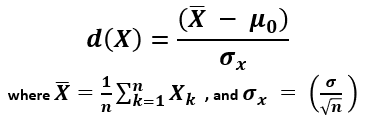
X (read "X bar") is the arithmetic mean of the population baseline or the control, μ 0 is the observed mean / treatment group mean, while σ x is the standard error of the mean (SEM, or standard deviation of the error of the mean).
Here is how it looks in practice when the error is normally distributed (Z distribution) with a one-tailed null and alternative hypotheses and a significance level α set to 0.05:

And here is the same significance level when applied to a point null and a two-tailed alternative hypothesis:
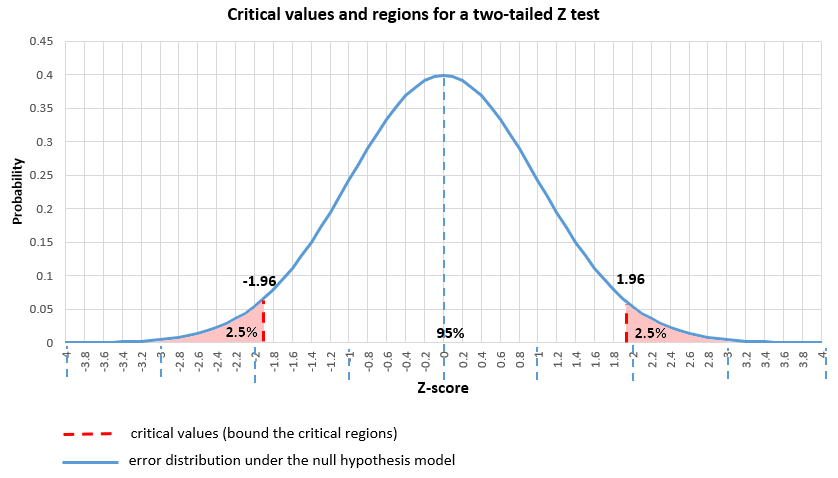
The distance function would vary depending on the distribution of the error: Z, T, F, or Chi-square (X 2 ). The calculation of a particular critical value based on a supplied probability and error distribution is simply a matter of calculating the inverse cumulative probability density function (inverse CPDF) of the respective distribution. This can be a difficult task, most notably for the T distribution [2] .
T critical value calculation
The T-distribution is often preferred in the social sciences, psychiatry, economics, and other sciences where low sample sizes are a common occurrence. Certain clinical studies also fall under this umbrella. This stems from the fact that for sample sizes over 30 it is practically equivalent to the normal distribution which is easier to work with. It was proposed by William Gosset, a.k.a. Student, in 1908 [3] , which is why it is also referred to as "Student's T distribution".
To find the critical t value, one needs to compute the inverse cumulative PDF of the T distribution. To do that, the significance level and the degrees of freedom need to be known. The degrees of freedom represent the number of values in the final calculation of a statistic that are free to vary whilst the statistic remains fixed at a certain value.
It should be noted that there is not, in fact, a single T-distribution, but there are infinitely many T-distributions, each with a different level of degrees of freedom. Below are some key values of the T-distribution with 1 degree of freedom, assuming a one-tailed T test is to be performed. These are often used as critical values to define rejection regions in hypothesis testing.
| Probability value | Degrees of Freedom | T critical value |
|---|---|---|
| 0.2000 | 1 | 1.3764 |
| 0.1000 | 1 | 3.0777 |
| 0.0500 | 1 | 6.3138 |
| 0.0250 | 1 | 12.7062 |
| 0.0200 | 1 | 15.8946 |
| 0.0100 | 1 | 31.8205 |
| 0.0010 | 1 | 318.3088 |
| 0.0005 | 1 | 636.6193 |
Z critical value calculation
The Z-score is a statistic showing how many standard deviations away from the normal, usually the mean, a given observation is. It is often called just a standard score, z-value, normal score, and standardized variable. A Z critical value is just a particular cutoff in the error distribution of a normally-distributed statistic.
Z critical values are computed by using the inverse cumulative probability density function of the standard normal distribution with a mean (μ) of zero and standard deviation (σ) of one. Below are some commonly encountered probability values (significance levels) and their corresponding Z values for the critical region, assuming a one-tailed hypothesis .
| Probability value | Z critical value |
|---|---|
| 0.2000 | 0.8416 |
| 0.1000 | 1.2816 |
| 0.0500 | 1.6449 |
| 0.0250 | 1.9600 |
| 0.0200 | 2.0537 |
| 0.0100 | 2.3263 |
| 0.0010 | 3.0902 |
| 0.0005 | 3.2905 |
The critical region defined by each of these would span from the Z value to plus infinity for the right-tailed case, and from minus infinity to minus the Z critical value in the left-tailed case. Our calculator for critical value will both find the critical z value(s) and output the corresponding critical regions for you.
Chi Square (Χ 2 ) critical value calculation
Chi square distributed errors are commonly encountered in goodness-of-fit tests and homogeneity tests, but also in tests for independence in contingency tables. Since the distribution is based on the squares of scores, it only contains positive values. Calculating the inverse cumulative PDF of the distribution is required in order to convert a desired probability (significance) to a chi square critical value.
Just like the T and F distributions, there is a different chi square distribution corresponding to different degrees of freedom. Hence, to calculate a Χ 2 critical value one needs to supply the degrees of freedom for the statistic of interest.
F critical value calculation
F distributed errors are commonly encountered in analysis of variance (ANOVA), which is very common in the social sciences. The distribution, also referred to as the Fisher-Snedecor distribution, only contains positive values, similar to the Χ 2 one. Similar to the T distribution, there is no single F-distribution to speak of. A different F distribution is defined for each pair of degrees of freedom - one for the numerator and one for the denominator.
Calculating the inverse cumulative PDF of the F distribution specified by the two degrees of freedom is required in order to convert a desired probability (significance) to a critical value. There is no simple solution to find a critical value of f and while there are tables, using a calculator is the preferred approach nowadays.
References
1 Mayo D.G., Spanos A. (2010) – "Error Statistics", in P. S. Bandyopadhyay & M. R. Forster (Eds.), Philosophy of Statistics, (7, 152–198). Handbook of the Philosophy of Science . The Netherlands: Elsevier.
2 Shaw T.W. (2006) – "Sampling Student's T distribution – use of the inverse cumulative distribution function", Journal of Computational Finance 9(4):37-73, DOI:10.21314/JCF.2006.150
3 "Student" [William Sealy Gosset] (1908) - "The probable error of a mean", Biometrika 6(1):1–25. DOI:10.1093/biomet/6.1.1
Cite this calculator & page
If you'd like to cite this online calculator resource and information as provided on the page, you can use the following citation: Georgiev G.Z., "Critical Value Calculator" , [online] Available at: https://www.gigacalculator.com/calculators/critical-value-calculator.php URL [Accessed Date: 01 Aug, 2024].
Our statistical calculators have been featured in scientific papers and articles published in high-profile science journals by:

The author of this tool

Statistical calculators
t-test Calculator
Table of contents
Welcome to our t-test calculator! Here you can not only easily perform one-sample t-tests , but also two-sample t-tests , as well as paired t-tests .
Do you prefer to find the p-value from t-test, or would you rather find the t-test critical values? Well, this t-test calculator can do both! 😊
What does a t-test tell you? Take a look at the text below, where we explain what actually gets tested when various types of t-tests are performed. Also, we explain when to use t-tests (in particular, whether to use the z-test vs. t-test) and what assumptions your data should satisfy for the results of a t-test to be valid. If you've ever wanted to know how to do a t-test by hand, we provide the necessary t-test formula, as well as tell you how to determine the number of degrees of freedom in a t-test.
When to use a t-test?
A t-test is one of the most popular statistical tests for location , i.e., it deals with the population(s) mean value(s).
There are different types of t-tests that you can perform:
- A one-sample t-test;
- A two-sample t-test; and
- A paired t-test.
In the next section , we explain when to use which. Remember that a t-test can only be used for one or two groups . If you need to compare three (or more) means, use the analysis of variance ( ANOVA ) method.
The t-test is a parametric test, meaning that your data has to fulfill some assumptions :
- The data points are independent; AND
- The data, at least approximately, follow a normal distribution .
If your sample doesn't fit these assumptions, you can resort to nonparametric alternatives. Visit our Mann–Whitney U test calculator or the Wilcoxon rank-sum test calculator to learn more. Other possibilities include the Wilcoxon signed-rank test or the sign test.
Which t-test?
Your choice of t-test depends on whether you are studying one group or two groups:
One sample t-test
Choose the one-sample t-test to check if the mean of a population is equal to some pre-set hypothesized value .
The average volume of a drink sold in 0.33 l cans — is it really equal to 330 ml?
The average weight of people from a specific city — is it different from the national average?
Two-sample t-test
Choose the two-sample t-test to check if the difference between the means of two populations is equal to some pre-determined value when the two samples have been chosen independently of each other.
In particular, you can use this test to check whether the two groups are different from one another .
The average difference in weight gain in two groups of people: one group was on a high-carb diet and the other on a high-fat diet.
The average difference in the results of a math test from students at two different universities.
This test is sometimes referred to as an independent samples t-test , or an unpaired samples t-test .
Paired t-test
A paired t-test is used to investigate the change in the mean of a population before and after some experimental intervention , based on a paired sample, i.e., when each subject has been measured twice: before and after treatment.
In particular, you can use this test to check whether, on average, the treatment has had any effect on the population .
The change in student test performance before and after taking a course.
The change in blood pressure in patients before and after administering some drug.
How to do a t-test?
So, you've decided which t-test to perform. These next steps will tell you how to calculate the p-value from t-test or its critical values, and then which decision to make about the null hypothesis.
Decide on the alternative hypothesis :
Use a two-tailed t-test if you only care whether the population's mean (or, in the case of two populations, the difference between the populations' means) agrees or disagrees with the pre-set value.
Use a one-tailed t-test if you want to test whether this mean (or difference in means) is greater/less than the pre-set value.
Compute your T-score value :
Formulas for the test statistic in t-tests include the sample size , as well as its mean and standard deviation . The exact formula depends on the t-test type — check the sections dedicated to each particular test for more details.
Determine the degrees of freedom for the t-test:
The degrees of freedom are the number of observations in a sample that are free to vary as we estimate statistical parameters. In the simplest case, the number of degrees of freedom equals your sample size minus the number of parameters you need to estimate . Again, the exact formula depends on the t-test you want to perform — check the sections below for details.
The degrees of freedom are essential, as they determine the distribution followed by your T-score (under the null hypothesis). If there are d degrees of freedom, then the distribution of the test statistics is the t-Student distribution with d degrees of freedom . This distribution has a shape similar to N(0,1) (bell-shaped and symmetric) but has heavier tails . If the number of degrees of freedom is large (>30), which generically happens for large samples, the t-Student distribution is practically indistinguishable from N(0,1).
💡 The t-Student distribution owes its name to William Sealy Gosset, who, in 1908, published his paper on the t-test under the pseudonym "Student". Gosset worked at the famous Guinness Brewery in Dublin, Ireland, and devised the t-test as an economical way to monitor the quality of beer. Cheers! 🍺🍺🍺
p-value from t-test
Recall that the p-value is the probability (calculated under the assumption that the null hypothesis is true) that the test statistic will produce values at least as extreme as the T-score produced for your sample . As probabilities correspond to areas under the density function, p-value from t-test can be nicely illustrated with the help of the following pictures:
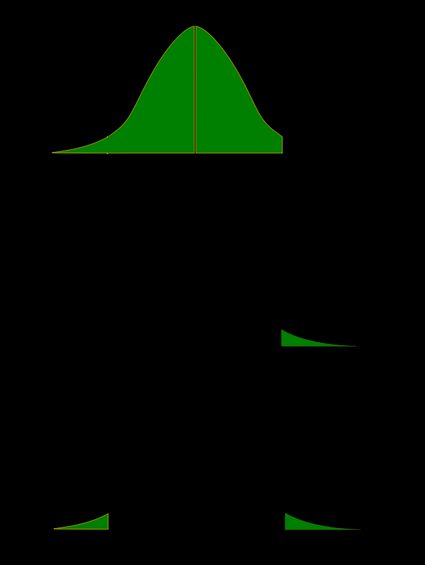
The following formulae say how to calculate p-value from t-test. By cdf t,d we denote the cumulative distribution function of the t-Student distribution with d degrees of freedom:
p-value from left-tailed t-test:
p-value = cdf t,d (t score )
p-value from right-tailed t-test:
p-value = 1 − cdf t,d (t score )
p-value from two-tailed t-test:
p-value = 2 × cdf t,d (−|t score |)
or, equivalently: p-value = 2 − 2 × cdf t,d (|t score |)
However, the cdf of the t-distribution is given by a somewhat complicated formula. To find the p-value by hand, you would need to resort to statistical tables, where approximate cdf values are collected, or to specialized statistical software. Fortunately, our t-test calculator determines the p-value from t-test for you in the blink of an eye!
t-test critical values
Recall, that in the critical values approach to hypothesis testing, you need to set a significance level, α, before computing the critical values , which in turn give rise to critical regions (a.k.a. rejection regions).
Formulas for critical values employ the quantile function of t-distribution, i.e., the inverse of the cdf :
Critical value for left-tailed t-test: cdf t,d -1 (α)
critical region:
(-∞, cdf t,d -1 (α)]
Critical value for right-tailed t-test: cdf t,d -1 (1-α)
[cdf t,d -1 (1-α), ∞)
Critical values for two-tailed t-test: ±cdf t,d -1 (1-α/2)
(-∞, -cdf t,d -1 (1-α/2)] ∪ [cdf t,d -1 (1-α/2), ∞)
To decide the fate of the null hypothesis, just check if your T-score lies within the critical region:
If your T-score belongs to the critical region , reject the null hypothesis and accept the alternative hypothesis.
If your T-score is outside the critical region , then you don't have enough evidence to reject the null hypothesis.
How to use our t-test calculator
Choose the type of t-test you wish to perform:
A one-sample t-test (to test the mean of a single group against a hypothesized mean);
A two-sample t-test (to compare the means for two groups); or
A paired t-test (to check how the mean from the same group changes after some intervention).
Two-tailed;
Left-tailed; or
Right-tailed.
This t-test calculator allows you to use either the p-value approach or the critical regions approach to hypothesis testing!
Enter your T-score and the number of degrees of freedom . If you don't know them, provide some data about your sample(s): sample size, mean, and standard deviation, and our t-test calculator will compute the T-score and degrees of freedom for you .
Once all the parameters are present, the p-value, or critical region, will immediately appear underneath the t-test calculator, along with an interpretation!
One-sample t-test
The null hypothesis is that the population mean is equal to some value μ 0 \mu_0 μ 0 .
The alternative hypothesis is that the population mean is:
- different from μ 0 \mu_0 μ 0 ;
- smaller than μ 0 \mu_0 μ 0 ; or
- greater than μ 0 \mu_0 μ 0 .
One-sample t-test formula :
- μ 0 \mu_0 μ 0 — Mean postulated in the null hypothesis;
- n n n — Sample size;
- x ˉ \bar{x} x ˉ — Sample mean; and
- s s s — Sample standard deviation.
Number of degrees of freedom in t-test (one-sample) = n − 1 n-1 n − 1 .
The null hypothesis is that the actual difference between these groups' means, μ 1 \mu_1 μ 1 , and μ 2 \mu_2 μ 2 , is equal to some pre-set value, Δ \Delta Δ .
The alternative hypothesis is that the difference μ 1 − μ 2 \mu_1 - \mu_2 μ 1 − μ 2 is:
- Different from Δ \Delta Δ ;
- Smaller than Δ \Delta Δ ; or
- Greater than Δ \Delta Δ .
In particular, if this pre-determined difference is zero ( Δ = 0 \Delta = 0 Δ = 0 ):
The null hypothesis is that the population means are equal.
The alternate hypothesis is that the population means are:
- μ 1 \mu_1 μ 1 and μ 2 \mu_2 μ 2 are different from one another;
- μ 1 \mu_1 μ 1 is smaller than μ 2 \mu_2 μ 2 ; and
- μ 1 \mu_1 μ 1 is greater than μ 2 \mu_2 μ 2 .
Formally, to perform a t-test, we should additionally assume that the variances of the two populations are equal (this assumption is called the homogeneity of variance ).
There is a version of a t-test that can be applied without the assumption of homogeneity of variance: it is called a Welch's t-test . For your convenience, we describe both versions.
Two-sample t-test if variances are equal
Use this test if you know that the two populations' variances are the same (or very similar).
Two-sample t-test formula (with equal variances) :
where s p s_p s p is the so-called pooled standard deviation , which we compute as:
- Δ \Delta Δ — Mean difference postulated in the null hypothesis;
- n 1 n_1 n 1 — First sample size;
- x ˉ 1 \bar{x}_1 x ˉ 1 — Mean for the first sample;
- s 1 s_1 s 1 — Standard deviation in the first sample;
- n 2 n_2 n 2 — Second sample size;
- x ˉ 2 \bar{x}_2 x ˉ 2 — Mean for the second sample; and
- s 2 s_2 s 2 — Standard deviation in the second sample.
Number of degrees of freedom in t-test (two samples, equal variances) = n 1 + n 2 − 2 n_1 + n_2 - 2 n 1 + n 2 − 2 .
Two-sample t-test if variances are unequal (Welch's t-test)
Use this test if the variances of your populations are different.
Two-sample Welch's t-test formula if variances are unequal:
- s 1 s_1 s 1 — Standard deviation in the first sample;
- s 2 s_2 s 2 — Standard deviation in the second sample.
The number of degrees of freedom in a Welch's t-test (two-sample t-test with unequal variances) is very difficult to count. We can approximate it with the help of the following Satterthwaite formula :
Alternatively, you can take the smaller of n 1 − 1 n_1 - 1 n 1 − 1 and n 2 − 1 n_2 - 1 n 2 − 1 as a conservative estimate for the number of degrees of freedom.
🔎 The Satterthwaite formula for the degrees of freedom can be rewritten as a scaled weighted harmonic mean of the degrees of freedom of the respective samples: n 1 − 1 n_1 - 1 n 1 − 1 and n 2 − 1 n_2 - 1 n 2 − 1 , and the weights are proportional to the standard deviations of the corresponding samples.
As we commonly perform a paired t-test when we have data about the same subjects measured twice (before and after some treatment), let us adopt the convention of referring to the samples as the pre-group and post-group.
The null hypothesis is that the true difference between the means of pre- and post-populations is equal to some pre-set value, Δ \Delta Δ .
The alternative hypothesis is that the actual difference between these means is:
Typically, this pre-determined difference is zero. We can then reformulate the hypotheses as follows:
The null hypothesis is that the pre- and post-means are the same, i.e., the treatment has no impact on the population .
The alternative hypothesis:
- The pre- and post-means are different from one another (treatment has some effect);
- The pre-mean is smaller than the post-mean (treatment increases the result); or
- The pre-mean is greater than the post-mean (treatment decreases the result).
Paired t-test formula
In fact, a paired t-test is technically the same as a one-sample t-test! Let us see why it is so. Let x 1 , . . . , x n x_1, ... , x_n x 1 , ... , x n be the pre observations and y 1 , . . . , y n y_1, ... , y_n y 1 , ... , y n the respective post observations. That is, x i , y i x_i, y_i x i , y i are the before and after measurements of the i -th subject.
For each subject, compute the difference, d i : = x i − y i d_i := x_i - y_i d i := x i − y i . All that happens next is just a one-sample t-test performed on the sample of differences d 1 , . . . , d n d_1, ... , d_n d 1 , ... , d n . Take a look at the formula for the T-score :
Δ \Delta Δ — Mean difference postulated in the null hypothesis;
n n n — Size of the sample of differences, i.e., the number of pairs;
x ˉ \bar{x} x ˉ — Mean of the sample of differences; and
s s s — Standard deviation of the sample of differences.
Number of degrees of freedom in t-test (paired): n − 1 n - 1 n − 1
t-test vs Z-test
We use a Z-test when we want to test the population mean of a normally distributed dataset, which has a known population variance . If the number of degrees of freedom is large, then the t-Student distribution is very close to N(0,1).
Hence, if there are many data points (at least 30), you may swap a t-test for a Z-test, and the results will be almost identical. However, for small samples with unknown variance, remember to use the t-test because, in such cases, the t-Student distribution differs significantly from the N(0,1)!
🙋 Have you concluded you need to perform the z-test? Head straight to our z-test calculator !
What is a t-test?
A t-test is a widely used statistical test that analyzes the means of one or two groups of data. For instance, a t-test is performed on medical data to determine whether a new drug really helps.
What are different types of t-tests?
Different types of t-tests are:
- One-sample t-test;
- Two-sample t-test; and
- Paired t-test.
How to find the t value in a one sample t-test?
To find the t-value:
- Subtract the null hypothesis mean from the sample mean value.
- Divide the difference by the standard deviation of the sample.
- Multiply the resultant with the square root of the sample size.
.css-1qjnekj.css-1qjnekj{color:#2B3148;background-color:transparent;font-family:"Roboto","Helvetica","Arial",sans-serif;font-size:20px;line-height:24px;overflow:visible;padding-top:0px;position:relative;}.css-1qjnekj.css-1qjnekj:after{content:'';-webkit-transform:scale(0);-moz-transform:scale(0);-ms-transform:scale(0);transform:scale(0);position:absolute;border:2px solid #EA9430;border-radius:2px;inset:-8px;z-index:1;}.css-1qjnekj .js-external-link-button.link-like,.css-1qjnekj .js-external-link-anchor{color:inherit;border-radius:1px;-webkit-text-decoration:underline;text-decoration:underline;}.css-1qjnekj .js-external-link-button.link-like:hover,.css-1qjnekj .js-external-link-anchor:hover,.css-1qjnekj .js-external-link-button.link-like:active,.css-1qjnekj .js-external-link-anchor:active{text-decoration-thickness:2px;text-shadow:1px 0 0;}.css-1qjnekj .js-external-link-button.link-like:focus-visible,.css-1qjnekj .js-external-link-anchor:focus-visible{outline:transparent 2px dotted;box-shadow:0 0 0 2px #6314E6;}.css-1qjnekj p,.css-1qjnekj div{margin:0;display:block;}.css-1qjnekj pre{margin:0;display:block;}.css-1qjnekj pre code{display:block;width:-webkit-fit-content;width:-moz-fit-content;width:fit-content;}.css-1qjnekj pre:not(:first-child){padding-top:8px;}.css-1qjnekj ul,.css-1qjnekj ol{display:block margin:0;padding-left:20px;}.css-1qjnekj ul li,.css-1qjnekj ol li{padding-top:8px;}.css-1qjnekj ul ul,.css-1qjnekj ol ul,.css-1qjnekj ul ol,.css-1qjnekj ol ol{padding-top:0;}.css-1qjnekj ul:not(:first-child),.css-1qjnekj ol:not(:first-child){padding-top:4px;} .css-1dtpypy{margin:auto;background-color:white;overflow:auto;overflow-wrap:break-word;word-break:break-word;}.css-1dtpypy code,.css-1dtpypy kbd,.css-1dtpypy pre,.css-1dtpypy samp{font-family:monospace;}.css-1dtpypy code{padding:2px 4px;color:#444;background:#ddd;border-radius:4px;}.css-1dtpypy figcaption,.css-1dtpypy caption{text-align:center;}.css-1dtpypy figcaption{font-size:12px;font-style:italic;overflow:hidden;}.css-1dtpypy h3{font-size:1.75rem;}.css-1dtpypy h4{font-size:1.5rem;}.css-1dtpypy .mathBlock{font-size:24px;-webkit-padding-start:4px;padding-inline-start:4px;}.css-1dtpypy .mathBlock .katex{font-size:24px;text-align:left;}.css-1dtpypy .math-inline{background-color:#f0f0f0;display:inline-block;font-size:inherit;padding:0 3px;}.css-1dtpypy .videoBlock,.css-1dtpypy .imageBlock{margin-bottom:16px;}.css-1dtpypy .imageBlock__image-align--left,.css-1dtpypy .videoBlock__video-align--left{float:left;}.css-1dtpypy .imageBlock__image-align--right,.css-1dtpypy .videoBlock__video-align--right{float:right;}.css-1dtpypy .imageBlock__image-align--center,.css-1dtpypy .videoBlock__video-align--center{display:block;margin-left:auto;margin-right:auto;clear:both;}.css-1dtpypy .imageBlock__image-align--none,.css-1dtpypy .videoBlock__video-align--none{clear:both;margin-left:0;margin-right:0;}.css-1dtpypy .videoBlock__video--wrapper{position:relative;padding-bottom:56.25%;height:0;}.css-1dtpypy .videoBlock__video--wrapper iframe{position:absolute;top:0;left:0;width:100%;height:100%;}.css-1dtpypy .videoBlock__caption{text-align:left;}@font-face{font-family:'KaTeX_AMS';src:url(/katex-fonts/KaTeX_AMS-Regular.woff2) format('woff2'),url(/katex-fonts/KaTeX_AMS-Regular.woff) format('woff'),url(/katex-fonts/KaTeX_AMS-Regular.ttf) format('truetype');font-weight:normal;font-style:normal;}@font-face{font-family:'KaTeX_Caligraphic';src:url(/katex-fonts/KaTeX_Caligraphic-Bold.woff2) format('woff2'),url(/katex-fonts/KaTeX_Caligraphic-Bold.woff) format('woff'),url(/katex-fonts/KaTeX_Caligraphic-Bold.ttf) format('truetype');font-weight:bold;font-style:normal;}@font-face{font-family:'KaTeX_Caligraphic';src:url(/katex-fonts/KaTeX_Caligraphic-Regular.woff2) format('woff2'),url(/katex-fonts/KaTeX_Caligraphic-Regular.woff) format('woff'),url(/katex-fonts/KaTeX_Caligraphic-Regular.ttf) format('truetype');font-weight:normal;font-style:normal;}@font-face{font-family:'KaTeX_Fraktur';src:url(/katex-fonts/KaTeX_Fraktur-Bold.woff2) format('woff2'),url(/katex-fonts/KaTeX_Fraktur-Bold.woff) format('woff'),url(/katex-fonts/KaTeX_Fraktur-Bold.ttf) format('truetype');font-weight:bold;font-style:normal;}@font-face{font-family:'KaTeX_Fraktur';src:url(/katex-fonts/KaTeX_Fraktur-Regular.woff2) format('woff2'),url(/katex-fonts/KaTeX_Fraktur-Regular.woff) format('woff'),url(/katex-fonts/KaTeX_Fraktur-Regular.ttf) format('truetype');font-weight:normal;font-style:normal;}@font-face{font-family:'KaTeX_Main';src:url(/katex-fonts/KaTeX_Main-Bold.woff2) format('woff2'),url(/katex-fonts/KaTeX_Main-Bold.woff) format('woff'),url(/katex-fonts/KaTeX_Main-Bold.ttf) format('truetype');font-weight:bold;font-style:normal;}@font-face{font-family:'KaTeX_Main';src:url(/katex-fonts/KaTeX_Main-BoldItalic.woff2) format('woff2'),url(/katex-fonts/KaTeX_Main-BoldItalic.woff) format('woff'),url(/katex-fonts/KaTeX_Main-BoldItalic.ttf) format('truetype');font-weight:bold;font-style:italic;}@font-face{font-family:'KaTeX_Main';src:url(/katex-fonts/KaTeX_Main-Italic.woff2) format('woff2'),url(/katex-fonts/KaTeX_Main-Italic.woff) format('woff'),url(/katex-fonts/KaTeX_Main-Italic.ttf) format('truetype');font-weight:normal;font-style:italic;}@font-face{font-family:'KaTeX_Main';src:url(/katex-fonts/KaTeX_Main-Regular.woff2) format('woff2'),url(/katex-fonts/KaTeX_Main-Regular.woff) format('woff'),url(/katex-fonts/KaTeX_Main-Regular.ttf) format('truetype');font-weight:normal;font-style:normal;}@font-face{font-family:'KaTeX_Math';src:url(/katex-fonts/KaTeX_Math-BoldItalic.woff2) format('woff2'),url(/katex-fonts/KaTeX_Math-BoldItalic.woff) format('woff'),url(/katex-fonts/KaTeX_Math-BoldItalic.ttf) format('truetype');font-weight:bold;font-style:italic;}@font-face{font-family:'KaTeX_Math';src:url(/katex-fonts/KaTeX_Math-Italic.woff2) format('woff2'),url(/katex-fonts/KaTeX_Math-Italic.woff) format('woff'),url(/katex-fonts/KaTeX_Math-Italic.ttf) format('truetype');font-weight:normal;font-style:italic;}@font-face{font-family:'KaTeX_SansSerif';src:url(/katex-fonts/KaTeX_SansSerif-Bold.woff2) format('woff2'),url(/katex-fonts/KaTeX_SansSerif-Bold.woff) format('woff'),url(/katex-fonts/KaTeX_SansSerif-Bold.ttf) format('truetype');font-weight:bold;font-style:normal;}@font-face{font-family:'KaTeX_SansSerif';src:url(/katex-fonts/KaTeX_SansSerif-Italic.woff2) format('woff2'),url(/katex-fonts/KaTeX_SansSerif-Italic.woff) format('woff'),url(/katex-fonts/KaTeX_SansSerif-Italic.ttf) format('truetype');font-weight:normal;font-style:italic;}@font-face{font-family:'KaTeX_SansSerif';src:url(/katex-fonts/KaTeX_SansSerif-Regular.woff2) format('woff2'),url(/katex-fonts/KaTeX_SansSerif-Regular.woff) format('woff'),url(/katex-fonts/KaTeX_SansSerif-Regular.ttf) format('truetype');font-weight:normal;font-style:normal;}@font-face{font-family:'KaTeX_Script';src:url(/katex-fonts/KaTeX_Script-Regular.woff2) format('woff2'),url(/katex-fonts/KaTeX_Script-Regular.woff) format('woff'),url(/katex-fonts/KaTeX_Script-Regular.ttf) format('truetype');font-weight:normal;font-style:normal;}@font-face{font-family:'KaTeX_Size1';src:url(/katex-fonts/KaTeX_Size1-Regular.woff2) format('woff2'),url(/katex-fonts/KaTeX_Size1-Regular.woff) format('woff'),url(/katex-fonts/KaTeX_Size1-Regular.ttf) format('truetype');font-weight:normal;font-style:normal;}@font-face{font-family:'KaTeX_Size2';src:url(/katex-fonts/KaTeX_Size2-Regular.woff2) format('woff2'),url(/katex-fonts/KaTeX_Size2-Regular.woff) format('woff'),url(/katex-fonts/KaTeX_Size2-Regular.ttf) format('truetype');font-weight:normal;font-style:normal;}@font-face{font-family:'KaTeX_Size3';src:url(/katex-fonts/KaTeX_Size3-Regular.woff2) format('woff2'),url(/katex-fonts/KaTeX_Size3-Regular.woff) format('woff'),url(/katex-fonts/KaTeX_Size3-Regular.ttf) format('truetype');font-weight:normal;font-style:normal;}@font-face{font-family:'KaTeX_Size4';src:url(/katex-fonts/KaTeX_Size4-Regular.woff2) format('woff2'),url(/katex-fonts/KaTeX_Size4-Regular.woff) format('woff'),url(/katex-fonts/KaTeX_Size4-Regular.ttf) format('truetype');font-weight:normal;font-style:normal;}@font-face{font-family:'KaTeX_Typewriter';src:url(/katex-fonts/KaTeX_Typewriter-Regular.woff2) format('woff2'),url(/katex-fonts/KaTeX_Typewriter-Regular.woff) format('woff'),url(/katex-fonts/KaTeX_Typewriter-Regular.ttf) format('truetype');font-weight:normal;font-style:normal;}.css-1dtpypy .katex{font:normal 1.21em KaTeX_Main,Times New Roman,serif;line-height:1.2;text-indent:0;text-rendering:auto;}.css-1dtpypy .katex *{-ms-high-contrast-adjust:none!important;border-color:currentColor;}.css-1dtpypy .katex .katex-version::after{content:'0.13.13';}.css-1dtpypy .katex .katex-mathml{position:absolute;clip:rect(1px,1px,1px,1px);padding:0;border:0;height:1px;width:1px;overflow:hidden;}.css-1dtpypy .katex .katex-html>.newline{display:block;}.css-1dtpypy .katex .base{position:relative;display:inline-block;white-space:nowrap;width:-webkit-min-content;width:-moz-min-content;width:-webkit-min-content;width:-moz-min-content;width:min-content;}.css-1dtpypy .katex .strut{display:inline-block;}.css-1dtpypy .katex .textbf{font-weight:bold;}.css-1dtpypy .katex .textit{font-style:italic;}.css-1dtpypy .katex .textrm{font-family:KaTeX_Main;}.css-1dtpypy .katex .textsf{font-family:KaTeX_SansSerif;}.css-1dtpypy .katex .texttt{font-family:KaTeX_Typewriter;}.css-1dtpypy .katex .mathnormal{font-family:KaTeX_Math;font-style:italic;}.css-1dtpypy .katex .mathit{font-family:KaTeX_Main;font-style:italic;}.css-1dtpypy .katex .mathrm{font-style:normal;}.css-1dtpypy .katex .mathbf{font-family:KaTeX_Main;font-weight:bold;}.css-1dtpypy .katex .boldsymbol{font-family:KaTeX_Math;font-weight:bold;font-style:italic;}.css-1dtpypy .katex .amsrm{font-family:KaTeX_AMS;}.css-1dtpypy .katex .mathbb,.css-1dtpypy .katex .textbb{font-family:KaTeX_AMS;}.css-1dtpypy .katex .mathcal{font-family:KaTeX_Caligraphic;}.css-1dtpypy .katex .mathfrak,.css-1dtpypy .katex .textfrak{font-family:KaTeX_Fraktur;}.css-1dtpypy .katex .mathtt{font-family:KaTeX_Typewriter;}.css-1dtpypy .katex .mathscr,.css-1dtpypy .katex .textscr{font-family:KaTeX_Script;}.css-1dtpypy .katex .mathsf,.css-1dtpypy .katex .textsf{font-family:KaTeX_SansSerif;}.css-1dtpypy .katex .mathboldsf,.css-1dtpypy .katex .textboldsf{font-family:KaTeX_SansSerif;font-weight:bold;}.css-1dtpypy .katex .mathitsf,.css-1dtpypy .katex .textitsf{font-family:KaTeX_SansSerif;font-style:italic;}.css-1dtpypy .katex .mainrm{font-family:KaTeX_Main;font-style:normal;}.css-1dtpypy .katex .vlist-t{display:inline-table;table-layout:fixed;border-collapse:collapse;}.css-1dtpypy .katex .vlist-r{display:table-row;}.css-1dtpypy .katex .vlist{display:table-cell;vertical-align:bottom;position:relative;}.css-1dtpypy .katex .vlist>span{display:block;height:0;position:relative;}.css-1dtpypy .katex .vlist>span>span{display:inline-block;}.css-1dtpypy .katex .vlist>span>.pstrut{overflow:hidden;width:0;}.css-1dtpypy .katex .vlist-t2{margin-right:-2px;}.css-1dtpypy .katex .vlist-s{display:table-cell;vertical-align:bottom;font-size:1px;width:2px;min-width:2px;}.css-1dtpypy .katex .vbox{display:-webkit-inline-box;display:-webkit-inline-flex;display:-ms-inline-flexbox;display:inline-flex;-webkit-flex-direction:column;-ms-flex-direction:column;flex-direction:column;-webkit-align-items:baseline;-webkit-box-align:baseline;-ms-flex-align:baseline;align-items:baseline;}.css-1dtpypy .katex .hbox{display:-webkit-inline-box;display:-webkit-inline-flex;display:-ms-inline-flexbox;display:inline-flex;-webkit-flex-direction:row;-ms-flex-direction:row;flex-direction:row;width:100%;}.css-1dtpypy .katex .thinbox{display:-webkit-inline-box;display:-webkit-inline-flex;display:-ms-inline-flexbox;display:inline-flex;-webkit-flex-direction:row;-ms-flex-direction:row;flex-direction:row;width:0;max-width:0;}.css-1dtpypy .katex .msupsub{text-align:left;}.css-1dtpypy .katex .mfrac>span>span{text-align:center;}.css-1dtpypy .katex .mfrac .frac-line{display:inline-block;width:100%;border-bottom-style:solid;}.css-1dtpypy .katex .mfrac .frac-line,.css-1dtpypy .katex .overline .overline-line,.css-1dtpypy .katex .underline .underline-line,.css-1dtpypy .katex .hline,.css-1dtpypy .katex .hdashline,.css-1dtpypy .katex .rule{min-height:1px;}.css-1dtpypy .katex .mspace{display:inline-block;}.css-1dtpypy .katex .llap,.css-1dtpypy .katex .rlap,.css-1dtpypy .katex .clap{width:0;position:relative;}.css-1dtpypy .katex .llap>.inner,.css-1dtpypy .katex .rlap>.inner,.css-1dtpypy .katex .clap>.inner{position:absolute;}.css-1dtpypy .katex .llap>.fix,.css-1dtpypy .katex .rlap>.fix,.css-1dtpypy .katex .clap>.fix{display:inline-block;}.css-1dtpypy .katex .llap>.inner{right:0;}.css-1dtpypy .katex .rlap>.inner,.css-1dtpypy .katex .clap>.inner{left:0;}.css-1dtpypy .katex .clap>.inner>span{margin-left:-50%;margin-right:50%;}.css-1dtpypy .katex .rule{display:inline-block;border:solid 0;position:relative;}.css-1dtpypy .katex .overline .overline-line,.css-1dtpypy .katex .underline .underline-line,.css-1dtpypy .katex .hline{display:inline-block;width:100%;border-bottom-style:solid;}.css-1dtpypy .katex .hdashline{display:inline-block;width:100%;border-bottom-style:dashed;}.css-1dtpypy .katex .sqrt>.root{margin-left:0.27777778em;margin-right:-0.55555556em;}.css-1dtpypy .katex .sizing.reset-size1.size1,.css-1dtpypy .katex .fontsize-ensurer.reset-size1.size1{font-size:1em;}.css-1dtpypy .katex .sizing.reset-size1.size2,.css-1dtpypy .katex .fontsize-ensurer.reset-size1.size2{font-size:1.2em;}.css-1dtpypy .katex .sizing.reset-size1.size3,.css-1dtpypy .katex .fontsize-ensurer.reset-size1.size3{font-size:1.4em;}.css-1dtpypy .katex .sizing.reset-size1.size4,.css-1dtpypy .katex .fontsize-ensurer.reset-size1.size4{font-size:1.6em;}.css-1dtpypy .katex .sizing.reset-size1.size5,.css-1dtpypy .katex .fontsize-ensurer.reset-size1.size5{font-size:1.8em;}.css-1dtpypy .katex .sizing.reset-size1.size6,.css-1dtpypy .katex .fontsize-ensurer.reset-size1.size6{font-size:2em;}.css-1dtpypy .katex .sizing.reset-size1.size7,.css-1dtpypy .katex .fontsize-ensurer.reset-size1.size7{font-size:2.4em;}.css-1dtpypy .katex .sizing.reset-size1.size8,.css-1dtpypy .katex .fontsize-ensurer.reset-size1.size8{font-size:2.88em;}.css-1dtpypy .katex .sizing.reset-size1.size9,.css-1dtpypy .katex .fontsize-ensurer.reset-size1.size9{font-size:3.456em;}.css-1dtpypy .katex .sizing.reset-size1.size10,.css-1dtpypy .katex .fontsize-ensurer.reset-size1.size10{font-size:4.148em;}.css-1dtpypy .katex .sizing.reset-size1.size11,.css-1dtpypy .katex .fontsize-ensurer.reset-size1.size11{font-size:4.976em;}.css-1dtpypy .katex .sizing.reset-size2.size1,.css-1dtpypy .katex .fontsize-ensurer.reset-size2.size1{font-size:0.83333333em;}.css-1dtpypy .katex .sizing.reset-size2.size2,.css-1dtpypy .katex .fontsize-ensurer.reset-size2.size2{font-size:1em;}.css-1dtpypy .katex .sizing.reset-size2.size3,.css-1dtpypy .katex .fontsize-ensurer.reset-size2.size3{font-size:1.16666667em;}.css-1dtpypy .katex .sizing.reset-size2.size4,.css-1dtpypy .katex .fontsize-ensurer.reset-size2.size4{font-size:1.33333333em;}.css-1dtpypy .katex .sizing.reset-size2.size5,.css-1dtpypy .katex .fontsize-ensurer.reset-size2.size5{font-size:1.5em;}.css-1dtpypy .katex .sizing.reset-size2.size6,.css-1dtpypy .katex .fontsize-ensurer.reset-size2.size6{font-size:1.66666667em;}.css-1dtpypy .katex .sizing.reset-size2.size7,.css-1dtpypy .katex .fontsize-ensurer.reset-size2.size7{font-size:2em;}.css-1dtpypy .katex .sizing.reset-size2.size8,.css-1dtpypy .katex .fontsize-ensurer.reset-size2.size8{font-size:2.4em;}.css-1dtpypy .katex .sizing.reset-size2.size9,.css-1dtpypy .katex .fontsize-ensurer.reset-size2.size9{font-size:2.88em;}.css-1dtpypy .katex .sizing.reset-size2.size10,.css-1dtpypy .katex .fontsize-ensurer.reset-size2.size10{font-size:3.45666667em;}.css-1dtpypy .katex .sizing.reset-size2.size11,.css-1dtpypy .katex .fontsize-ensurer.reset-size2.size11{font-size:4.14666667em;}.css-1dtpypy .katex .sizing.reset-size3.size1,.css-1dtpypy .katex .fontsize-ensurer.reset-size3.size1{font-size:0.71428571em;}.css-1dtpypy .katex .sizing.reset-size3.size2,.css-1dtpypy .katex .fontsize-ensurer.reset-size3.size2{font-size:0.85714286em;}.css-1dtpypy .katex .sizing.reset-size3.size3,.css-1dtpypy .katex .fontsize-ensurer.reset-size3.size3{font-size:1em;}.css-1dtpypy .katex .sizing.reset-size3.size4,.css-1dtpypy .katex .fontsize-ensurer.reset-size3.size4{font-size:1.14285714em;}.css-1dtpypy .katex .sizing.reset-size3.size5,.css-1dtpypy .katex .fontsize-ensurer.reset-size3.size5{font-size:1.28571429em;}.css-1dtpypy .katex .sizing.reset-size3.size6,.css-1dtpypy .katex .fontsize-ensurer.reset-size3.size6{font-size:1.42857143em;}.css-1dtpypy .katex .sizing.reset-size3.size7,.css-1dtpypy .katex .fontsize-ensurer.reset-size3.size7{font-size:1.71428571em;}.css-1dtpypy .katex .sizing.reset-size3.size8,.css-1dtpypy .katex .fontsize-ensurer.reset-size3.size8{font-size:2.05714286em;}.css-1dtpypy .katex .sizing.reset-size3.size9,.css-1dtpypy .katex .fontsize-ensurer.reset-size3.size9{font-size:2.46857143em;}.css-1dtpypy .katex .sizing.reset-size3.size10,.css-1dtpypy .katex .fontsize-ensurer.reset-size3.size10{font-size:2.96285714em;}.css-1dtpypy .katex .sizing.reset-size3.size11,.css-1dtpypy .katex .fontsize-ensurer.reset-size3.size11{font-size:3.55428571em;}.css-1dtpypy .katex .sizing.reset-size4.size1,.css-1dtpypy .katex .fontsize-ensurer.reset-size4.size1{font-size:0.625em;}.css-1dtpypy .katex .sizing.reset-size4.size2,.css-1dtpypy .katex .fontsize-ensurer.reset-size4.size2{font-size:0.75em;}.css-1dtpypy .katex .sizing.reset-size4.size3,.css-1dtpypy .katex .fontsize-ensurer.reset-size4.size3{font-size:0.875em;}.css-1dtpypy .katex .sizing.reset-size4.size4,.css-1dtpypy .katex .fontsize-ensurer.reset-size4.size4{font-size:1em;}.css-1dtpypy .katex .sizing.reset-size4.size5,.css-1dtpypy .katex .fontsize-ensurer.reset-size4.size5{font-size:1.125em;}.css-1dtpypy .katex .sizing.reset-size4.size6,.css-1dtpypy .katex .fontsize-ensurer.reset-size4.size6{font-size:1.25em;}.css-1dtpypy .katex .sizing.reset-size4.size7,.css-1dtpypy .katex .fontsize-ensurer.reset-size4.size7{font-size:1.5em;}.css-1dtpypy .katex .sizing.reset-size4.size8,.css-1dtpypy .katex .fontsize-ensurer.reset-size4.size8{font-size:1.8em;}.css-1dtpypy .katex .sizing.reset-size4.size9,.css-1dtpypy .katex .fontsize-ensurer.reset-size4.size9{font-size:2.16em;}.css-1dtpypy .katex .sizing.reset-size4.size10,.css-1dtpypy .katex .fontsize-ensurer.reset-size4.size10{font-size:2.5925em;}.css-1dtpypy .katex .sizing.reset-size4.size11,.css-1dtpypy .katex .fontsize-ensurer.reset-size4.size11{font-size:3.11em;}.css-1dtpypy .katex .sizing.reset-size5.size1,.css-1dtpypy .katex .fontsize-ensurer.reset-size5.size1{font-size:0.55555556em;}.css-1dtpypy .katex .sizing.reset-size5.size2,.css-1dtpypy .katex .fontsize-ensurer.reset-size5.size2{font-size:0.66666667em;}.css-1dtpypy .katex .sizing.reset-size5.size3,.css-1dtpypy .katex .fontsize-ensurer.reset-size5.size3{font-size:0.77777778em;}.css-1dtpypy .katex .sizing.reset-size5.size4,.css-1dtpypy .katex .fontsize-ensurer.reset-size5.size4{font-size:0.88888889em;}.css-1dtpypy .katex .sizing.reset-size5.size5,.css-1dtpypy .katex .fontsize-ensurer.reset-size5.size5{font-size:1em;}.css-1dtpypy .katex .sizing.reset-size5.size6,.css-1dtpypy .katex .fontsize-ensurer.reset-size5.size6{font-size:1.11111111em;}.css-1dtpypy .katex .sizing.reset-size5.size7,.css-1dtpypy .katex .fontsize-ensurer.reset-size5.size7{font-size:1.33333333em;}.css-1dtpypy .katex .sizing.reset-size5.size8,.css-1dtpypy .katex .fontsize-ensurer.reset-size5.size8{font-size:1.6em;}.css-1dtpypy .katex .sizing.reset-size5.size9,.css-1dtpypy .katex .fontsize-ensurer.reset-size5.size9{font-size:1.92em;}.css-1dtpypy .katex .sizing.reset-size5.size10,.css-1dtpypy .katex .fontsize-ensurer.reset-size5.size10{font-size:2.30444444em;}.css-1dtpypy .katex .sizing.reset-size5.size11,.css-1dtpypy .katex .fontsize-ensurer.reset-size5.size11{font-size:2.76444444em;}.css-1dtpypy .katex .sizing.reset-size6.size1,.css-1dtpypy .katex .fontsize-ensurer.reset-size6.size1{font-size:0.5em;}.css-1dtpypy .katex .sizing.reset-size6.size2,.css-1dtpypy .katex .fontsize-ensurer.reset-size6.size2{font-size:0.6em;}.css-1dtpypy .katex .sizing.reset-size6.size3,.css-1dtpypy .katex .fontsize-ensurer.reset-size6.size3{font-size:0.7em;}.css-1dtpypy .katex .sizing.reset-size6.size4,.css-1dtpypy .katex .fontsize-ensurer.reset-size6.size4{font-size:0.8em;}.css-1dtpypy .katex .sizing.reset-size6.size5,.css-1dtpypy .katex .fontsize-ensurer.reset-size6.size5{font-size:0.9em;}.css-1dtpypy .katex .sizing.reset-size6.size6,.css-1dtpypy .katex .fontsize-ensurer.reset-size6.size6{font-size:1em;}.css-1dtpypy .katex .sizing.reset-size6.size7,.css-1dtpypy .katex .fontsize-ensurer.reset-size6.size7{font-size:1.2em;}.css-1dtpypy .katex .sizing.reset-size6.size8,.css-1dtpypy .katex .fontsize-ensurer.reset-size6.size8{font-size:1.44em;}.css-1dtpypy .katex .sizing.reset-size6.size9,.css-1dtpypy .katex .fontsize-ensurer.reset-size6.size9{font-size:1.728em;}.css-1dtpypy .katex .sizing.reset-size6.size10,.css-1dtpypy .katex .fontsize-ensurer.reset-size6.size10{font-size:2.074em;}.css-1dtpypy .katex .sizing.reset-size6.size11,.css-1dtpypy .katex .fontsize-ensurer.reset-size6.size11{font-size:2.488em;}.css-1dtpypy .katex .sizing.reset-size7.size1,.css-1dtpypy .katex .fontsize-ensurer.reset-size7.size1{font-size:0.41666667em;}.css-1dtpypy .katex .sizing.reset-size7.size2,.css-1dtpypy .katex .fontsize-ensurer.reset-size7.size2{font-size:0.5em;}.css-1dtpypy .katex .sizing.reset-size7.size3,.css-1dtpypy .katex .fontsize-ensurer.reset-size7.size3{font-size:0.58333333em;}.css-1dtpypy .katex .sizing.reset-size7.size4,.css-1dtpypy .katex .fontsize-ensurer.reset-size7.size4{font-size:0.66666667em;}.css-1dtpypy .katex .sizing.reset-size7.size5,.css-1dtpypy .katex .fontsize-ensurer.reset-size7.size5{font-size:0.75em;}.css-1dtpypy .katex .sizing.reset-size7.size6,.css-1dtpypy .katex .fontsize-ensurer.reset-size7.size6{font-size:0.83333333em;}.css-1dtpypy .katex .sizing.reset-size7.size7,.css-1dtpypy .katex .fontsize-ensurer.reset-size7.size7{font-size:1em;}.css-1dtpypy .katex .sizing.reset-size7.size8,.css-1dtpypy .katex .fontsize-ensurer.reset-size7.size8{font-size:1.2em;}.css-1dtpypy .katex .sizing.reset-size7.size9,.css-1dtpypy .katex .fontsize-ensurer.reset-size7.size9{font-size:1.44em;}.css-1dtpypy .katex .sizing.reset-size7.size10,.css-1dtpypy .katex .fontsize-ensurer.reset-size7.size10{font-size:1.72833333em;}.css-1dtpypy .katex .sizing.reset-size7.size11,.css-1dtpypy .katex .fontsize-ensurer.reset-size7.size11{font-size:2.07333333em;}.css-1dtpypy .katex .sizing.reset-size8.size1,.css-1dtpypy .katex .fontsize-ensurer.reset-size8.size1{font-size:0.34722222em;}.css-1dtpypy .katex .sizing.reset-size8.size2,.css-1dtpypy .katex .fontsize-ensurer.reset-size8.size2{font-size:0.41666667em;}.css-1dtpypy .katex .sizing.reset-size8.size3,.css-1dtpypy .katex .fontsize-ensurer.reset-size8.size3{font-size:0.48611111em;}.css-1dtpypy .katex .sizing.reset-size8.size4,.css-1dtpypy .katex .fontsize-ensurer.reset-size8.size4{font-size:0.55555556em;}.css-1dtpypy .katex .sizing.reset-size8.size5,.css-1dtpypy .katex .fontsize-ensurer.reset-size8.size5{font-size:0.625em;}.css-1dtpypy .katex .sizing.reset-size8.size6,.css-1dtpypy .katex .fontsize-ensurer.reset-size8.size6{font-size:0.69444444em;}.css-1dtpypy .katex .sizing.reset-size8.size7,.css-1dtpypy .katex .fontsize-ensurer.reset-size8.size7{font-size:0.83333333em;}.css-1dtpypy .katex .sizing.reset-size8.size8,.css-1dtpypy .katex .fontsize-ensurer.reset-size8.size8{font-size:1em;}.css-1dtpypy .katex .sizing.reset-size8.size9,.css-1dtpypy .katex .fontsize-ensurer.reset-size8.size9{font-size:1.2em;}.css-1dtpypy .katex .sizing.reset-size8.size10,.css-1dtpypy .katex .fontsize-ensurer.reset-size8.size10{font-size:1.44027778em;}.css-1dtpypy .katex .sizing.reset-size8.size11,.css-1dtpypy .katex .fontsize-ensurer.reset-size8.size11{font-size:1.72777778em;}.css-1dtpypy .katex .sizing.reset-size9.size1,.css-1dtpypy .katex .fontsize-ensurer.reset-size9.size1{font-size:0.28935185em;}.css-1dtpypy .katex .sizing.reset-size9.size2,.css-1dtpypy .katex .fontsize-ensurer.reset-size9.size2{font-size:0.34722222em;}.css-1dtpypy .katex .sizing.reset-size9.size3,.css-1dtpypy .katex .fontsize-ensurer.reset-size9.size3{font-size:0.40509259em;}.css-1dtpypy .katex .sizing.reset-size9.size4,.css-1dtpypy .katex .fontsize-ensurer.reset-size9.size4{font-size:0.46296296em;}.css-1dtpypy .katex .sizing.reset-size9.size5,.css-1dtpypy .katex .fontsize-ensurer.reset-size9.size5{font-size:0.52083333em;}.css-1dtpypy .katex .sizing.reset-size9.size6,.css-1dtpypy .katex .fontsize-ensurer.reset-size9.size6{font-size:0.5787037em;}.css-1dtpypy .katex .sizing.reset-size9.size7,.css-1dtpypy .katex .fontsize-ensurer.reset-size9.size7{font-size:0.69444444em;}.css-1dtpypy .katex .sizing.reset-size9.size8,.css-1dtpypy .katex .fontsize-ensurer.reset-size9.size8{font-size:0.83333333em;}.css-1dtpypy .katex .sizing.reset-size9.size9,.css-1dtpypy .katex .fontsize-ensurer.reset-size9.size9{font-size:1em;}.css-1dtpypy .katex .sizing.reset-size9.size10,.css-1dtpypy .katex .fontsize-ensurer.reset-size9.size10{font-size:1.20023148em;}.css-1dtpypy .katex .sizing.reset-size9.size11,.css-1dtpypy .katex .fontsize-ensurer.reset-size9.size11{font-size:1.43981481em;}.css-1dtpypy .katex .sizing.reset-size10.size1,.css-1dtpypy .katex .fontsize-ensurer.reset-size10.size1{font-size:0.24108004em;}.css-1dtpypy .katex .sizing.reset-size10.size2,.css-1dtpypy .katex .fontsize-ensurer.reset-size10.size2{font-size:0.28929605em;}.css-1dtpypy .katex .sizing.reset-size10.size3,.css-1dtpypy .katex .fontsize-ensurer.reset-size10.size3{font-size:0.33751205em;}.css-1dtpypy .katex .sizing.reset-size10.size4,.css-1dtpypy .katex .fontsize-ensurer.reset-size10.size4{font-size:0.38572806em;}.css-1dtpypy .katex .sizing.reset-size10.size5,.css-1dtpypy .katex .fontsize-ensurer.reset-size10.size5{font-size:0.43394407em;}.css-1dtpypy .katex .sizing.reset-size10.size6,.css-1dtpypy .katex .fontsize-ensurer.reset-size10.size6{font-size:0.48216008em;}.css-1dtpypy .katex .sizing.reset-size10.size7,.css-1dtpypy .katex .fontsize-ensurer.reset-size10.size7{font-size:0.57859209em;}.css-1dtpypy .katex .sizing.reset-size10.size8,.css-1dtpypy .katex .fontsize-ensurer.reset-size10.size8{font-size:0.69431051em;}.css-1dtpypy .katex .sizing.reset-size10.size9,.css-1dtpypy .katex .fontsize-ensurer.reset-size10.size9{font-size:0.83317261em;}.css-1dtpypy .katex .sizing.reset-size10.size10,.css-1dtpypy .katex .fontsize-ensurer.reset-size10.size10{font-size:1em;}.css-1dtpypy .katex .sizing.reset-size10.size11,.css-1dtpypy .katex .fontsize-ensurer.reset-size10.size11{font-size:1.19961427em;}.css-1dtpypy .katex .sizing.reset-size11.size1,.css-1dtpypy .katex .fontsize-ensurer.reset-size11.size1{font-size:0.20096463em;}.css-1dtpypy .katex .sizing.reset-size11.size2,.css-1dtpypy .katex .fontsize-ensurer.reset-size11.size2{font-size:0.24115756em;}.css-1dtpypy .katex .sizing.reset-size11.size3,.css-1dtpypy .katex .fontsize-ensurer.reset-size11.size3{font-size:0.28135048em;}.css-1dtpypy .katex .sizing.reset-size11.size4,.css-1dtpypy .katex .fontsize-ensurer.reset-size11.size4{font-size:0.32154341em;}.css-1dtpypy .katex .sizing.reset-size11.size5,.css-1dtpypy .katex .fontsize-ensurer.reset-size11.size5{font-size:0.36173633em;}.css-1dtpypy .katex .sizing.reset-size11.size6,.css-1dtpypy .katex .fontsize-ensurer.reset-size11.size6{font-size:0.40192926em;}.css-1dtpypy .katex .sizing.reset-size11.size7,.css-1dtpypy .katex .fontsize-ensurer.reset-size11.size7{font-size:0.48231511em;}.css-1dtpypy .katex .sizing.reset-size11.size8,.css-1dtpypy .katex .fontsize-ensurer.reset-size11.size8{font-size:0.57877814em;}.css-1dtpypy .katex .sizing.reset-size11.size9,.css-1dtpypy .katex .fontsize-ensurer.reset-size11.size9{font-size:0.69453376em;}.css-1dtpypy .katex .sizing.reset-size11.size10,.css-1dtpypy .katex .fontsize-ensurer.reset-size11.size10{font-size:0.83360129em;}.css-1dtpypy .katex .sizing.reset-size11.size11,.css-1dtpypy .katex .fontsize-ensurer.reset-size11.size11{font-size:1em;}.css-1dtpypy .katex .delimsizing.size1{font-family:KaTeX_Size1;}.css-1dtpypy .katex .delimsizing.size2{font-family:KaTeX_Size2;}.css-1dtpypy .katex .delimsizing.size3{font-family:KaTeX_Size3;}.css-1dtpypy .katex .delimsizing.size4{font-family:KaTeX_Size4;}.css-1dtpypy .katex .delimsizing.mult .delim-size1>span{font-family:KaTeX_Size1;}.css-1dtpypy .katex .delimsizing.mult .delim-size4>span{font-family:KaTeX_Size4;}.css-1dtpypy .katex .nulldelimiter{display:inline-block;width:0.12em;}.css-1dtpypy .katex .delimcenter{position:relative;}.css-1dtpypy .katex .op-symbol{position:relative;}.css-1dtpypy .katex .op-symbol.small-op{font-family:KaTeX_Size1;}.css-1dtpypy .katex .op-symbol.large-op{font-family:KaTeX_Size2;}.css-1dtpypy .katex .op-limits>.vlist-t{text-align:center;}.css-1dtpypy .katex .accent>.vlist-t{text-align:center;}.css-1dtpypy .katex .accent .accent-body{position:relative;}.css-1dtpypy .katex .accent .accent-body:not(.accent-full){width:0;}.css-1dtpypy .katex .overlay{display:block;}.css-1dtpypy .katex .mtable .vertical-separator{display:inline-block;min-width:1px;}.css-1dtpypy .katex .mtable .arraycolsep{display:inline-block;}.css-1dtpypy .katex .mtable .col-align-c>.vlist-t{text-align:center;}.css-1dtpypy .katex .mtable .col-align-l>.vlist-t{text-align:left;}.css-1dtpypy .katex .mtable .col-align-r>.vlist-t{text-align:right;}.css-1dtpypy .katex .svg-align{text-align:left;}.css-1dtpypy .katex svg{display:block;position:absolute;width:100%;height:inherit;fill:currentColor;stroke:currentColor;fill-rule:nonzero;fill-opacity:1;stroke-width:1;stroke-linecap:butt;stroke-linejoin:miter;stroke-miterlimit:4;stroke-dasharray:none;stroke-dashoffset:0;stroke-opacity:1;}.css-1dtpypy .katex svg path{stroke:none;}.css-1dtpypy .katex img{border-style:none;min-width:0;min-height:0;max-width:none;max-height:none;}.css-1dtpypy .katex .stretchy{width:100%;display:block;position:relative;overflow:hidden;}.css-1dtpypy .katex .stretchy::before,.css-1dtpypy .katex .stretchy::after{content:'';}.css-1dtpypy .katex .hide-tail{width:100%;position:relative;overflow:hidden;}.css-1dtpypy .katex .halfarrow-left{position:absolute;left:0;width:50.2%;overflow:hidden;}.css-1dtpypy .katex .halfarrow-right{position:absolute;right:0;width:50.2%;overflow:hidden;}.css-1dtpypy .katex .brace-left{position:absolute;left:0;width:25.1%;overflow:hidden;}.css-1dtpypy .katex .brace-center{position:absolute;left:25%;width:50%;overflow:hidden;}.css-1dtpypy .katex .brace-right{position:absolute;right:0;width:25.1%;overflow:hidden;}.css-1dtpypy .katex .x-arrow-pad{padding:0 0.5em;}.css-1dtpypy .katex .cd-arrow-pad{padding:0 0.55556em 0 0.27778em;}.css-1dtpypy .katex .x-arrow,.css-1dtpypy .katex .mover,.css-1dtpypy .katex .munder{text-align:center;}.css-1dtpypy .katex .boxpad{padding:0 0.3em 0 0.3em;}.css-1dtpypy .katex .fbox,.css-1dtpypy .katex .fcolorbox{box-sizing:border-box;border:0.04em solid;}.css-1dtpypy .katex .cancel-pad{padding:0 0.2em 0 0.2em;}.css-1dtpypy .katex .cancel-lap{margin-left:-0.2em;margin-right:-0.2em;}.css-1dtpypy .katex .sout{border-bottom-style:solid;border-bottom-width:0.08em;}.css-1dtpypy .katex .angl{box-sizing:border-box;border-top:0.049em solid;border-right:0.049em solid;margin-right:0.03889em;}.css-1dtpypy .katex .anglpad{padding:0 0.03889em 0 0.03889em;}.css-1dtpypy .katex .eqn-num::before{counter-increment:katexEqnNo;content:'(' counter(katexEqnNo) ')';}.css-1dtpypy .katex .mml-eqn-num::before{counter-increment:mmlEqnNo;content:'(' counter(mmlEqnNo) ')';}.css-1dtpypy .katex .mtr-glue{width:50%;}.css-1dtpypy .katex .cd-vert-arrow{display:inline-block;position:relative;}.css-1dtpypy .katex .cd-label-left{display:inline-block;position:absolute;right:calc(50% + 0.3em);text-align:left;}.css-1dtpypy .katex .cd-label-right{display:inline-block;position:absolute;left:calc(50% + 0.3em);text-align:right;}.css-1dtpypy .katex-display{display:block;margin:1em 0;text-align:center;}.css-1dtpypy .katex-display>.katex{display:block;white-space:nowrap;}.css-1dtpypy .katex-display>.katex>.katex-html{display:block;position:relative;}.css-1dtpypy .katex-display>.katex>.katex-html>.tag{position:absolute;right:0;}.css-1dtpypy .katex-display.leqno>.katex>.katex-html>.tag{left:0;right:auto;}.css-1dtpypy .katex-display.fleqn>.katex{text-align:left;padding-left:2em;}.css-1dtpypy body{counter-reset:katexEqnNo mmlEqnNo;}.css-1dtpypy table{width:-webkit-max-content;width:-moz-max-content;width:max-content;}.css-1dtpypy .tableBlock{max-width:100%;margin-bottom:1rem;overflow-y:scroll;}.css-1dtpypy .tableBlock thead,.css-1dtpypy .tableBlock thead th{border-bottom:1px solid #333!important;}.css-1dtpypy .tableBlock th,.css-1dtpypy .tableBlock td{padding:10px;text-align:left;}.css-1dtpypy .tableBlock th{font-weight:bold!important;}.css-1dtpypy .tableBlock caption{caption-side:bottom;color:#555;font-size:12px;font-style:italic;text-align:center;}.css-1dtpypy .tableBlock caption>p{margin:0;}.css-1dtpypy .tableBlock th>p,.css-1dtpypy .tableBlock td>p{margin:0;}.css-1dtpypy .tableBlock [data-background-color='aliceblue']{background-color:#f0f8ff;color:#000;}.css-1dtpypy .tableBlock [data-background-color='black']{background-color:#000;color:#fff;}.css-1dtpypy .tableBlock [data-background-color='chocolate']{background-color:#d2691e;color:#fff;}.css-1dtpypy .tableBlock [data-background-color='cornflowerblue']{background-color:#6495ed;color:#fff;}.css-1dtpypy .tableBlock [data-background-color='crimson']{background-color:#dc143c;color:#fff;}.css-1dtpypy .tableBlock [data-background-color='darkblue']{background-color:#00008b;color:#fff;}.css-1dtpypy .tableBlock [data-background-color='darkseagreen']{background-color:#8fbc8f;color:#000;}.css-1dtpypy .tableBlock [data-background-color='deepskyblue']{background-color:#00bfff;color:#000;}.css-1dtpypy .tableBlock [data-background-color='gainsboro']{background-color:#dcdcdc;color:#000;}.css-1dtpypy .tableBlock [data-background-color='grey']{background-color:#808080;color:#fff;}.css-1dtpypy .tableBlock [data-background-color='lemonchiffon']{background-color:#fffacd;color:#000;}.css-1dtpypy .tableBlock [data-background-color='lightpink']{background-color:#ffb6c1;color:#000;}.css-1dtpypy .tableBlock [data-background-color='lightsalmon']{background-color:#ffa07a;color:#000;}.css-1dtpypy .tableBlock [data-background-color='lightskyblue']{background-color:#87cefa;color:#000;}.css-1dtpypy .tableBlock [data-background-color='mediumblue']{background-color:#0000cd;color:#fff;}.css-1dtpypy .tableBlock [data-background-color='omnigrey']{background-color:#f0f0f0;color:#000;}.css-1dtpypy .tableBlock [data-background-color='white']{background-color:#fff;color:#000;}.css-1dtpypy .tableBlock [data-text-align='center']{text-align:center;}.css-1dtpypy .tableBlock [data-text-align='left']{text-align:left;}.css-1dtpypy .tableBlock [data-text-align='right']{text-align:right;}.css-1dtpypy .tableBlock [data-vertical-align='bottom']{vertical-align:bottom;}.css-1dtpypy .tableBlock [data-vertical-align='middle']{vertical-align:middle;}.css-1dtpypy .tableBlock [data-vertical-align='top']{vertical-align:top;}.css-1dtpypy .tableBlock__font-size--xxsmall{font-size:10px;}.css-1dtpypy .tableBlock__font-size--xsmall{font-size:12px;}.css-1dtpypy .tableBlock__font-size--small{font-size:14px;}.css-1dtpypy .tableBlock__font-size--large{font-size:18px;}.css-1dtpypy .tableBlock__border--some tbody tr:not(:last-child){border-bottom:1px solid #e2e5e7;}.css-1dtpypy .tableBlock__border--bordered td,.css-1dtpypy .tableBlock__border--bordered th{border:1px solid #e2e5e7;}.css-1dtpypy .tableBlock__border--borderless tbody+tbody,.css-1dtpypy .tableBlock__border--borderless td,.css-1dtpypy .tableBlock__border--borderless th,.css-1dtpypy .tableBlock__border--borderless tr,.css-1dtpypy .tableBlock__border--borderless thead,.css-1dtpypy .tableBlock__border--borderless thead th{border:0!important;}.css-1dtpypy .tableBlock:not(.tableBlock__table-striped) tbody tr{background-color:unset!important;}.css-1dtpypy .tableBlock__table-striped tbody tr:nth-of-type(odd){background-color:#f9fafc!important;}.css-1dtpypy .tableBlock__table-compactl th,.css-1dtpypy .tableBlock__table-compact td{padding:3px!important;}.css-1dtpypy .tableBlock__full-size{width:100%;}.css-1dtpypy .textBlock{margin-bottom:16px;}.css-1dtpypy .textBlock__text-formatting--finePrint{font-size:12px;}.css-1dtpypy .textBlock__text-infoBox{padding:0.75rem 1.25rem;margin-bottom:1rem;border:1px solid transparent;border-radius:0.25rem;}.css-1dtpypy .textBlock__text-infoBox p{margin:0;}.css-1dtpypy .textBlock__text-infoBox--primary{background-color:#cce5ff;border-color:#b8daff;color:#004085;}.css-1dtpypy .textBlock__text-infoBox--secondary{background-color:#e2e3e5;border-color:#d6d8db;color:#383d41;}.css-1dtpypy .textBlock__text-infoBox--success{background-color:#d4edda;border-color:#c3e6cb;color:#155724;}.css-1dtpypy .textBlock__text-infoBox--danger{background-color:#f8d7da;border-color:#f5c6cb;color:#721c24;}.css-1dtpypy .textBlock__text-infoBox--warning{background-color:#fff3cd;border-color:#ffeeba;color:#856404;}.css-1dtpypy .textBlock__text-infoBox--info{background-color:#d1ecf1;border-color:#bee5eb;color:#0c5460;}.css-1dtpypy .textBlock__text-infoBox--dark{background-color:#d6d8d9;border-color:#c6c8ca;color:#1b1e21;}.css-1dtpypy .text-overline{-webkit-text-decoration:overline;text-decoration:overline;}.css-1dtpypy.css-1dtpypy{color:#2B3148;background-color:transparent;font-family:"Roboto","Helvetica","Arial",sans-serif;font-size:20px;line-height:24px;overflow:visible;padding-top:0px;position:relative;}.css-1dtpypy.css-1dtpypy:after{content:'';-webkit-transform:scale(0);-moz-transform:scale(0);-ms-transform:scale(0);transform:scale(0);position:absolute;border:2px solid #EA9430;border-radius:2px;inset:-8px;z-index:1;}.css-1dtpypy .js-external-link-button.link-like,.css-1dtpypy .js-external-link-anchor{color:inherit;border-radius:1px;-webkit-text-decoration:underline;text-decoration:underline;}.css-1dtpypy .js-external-link-button.link-like:hover,.css-1dtpypy .js-external-link-anchor:hover,.css-1dtpypy .js-external-link-button.link-like:active,.css-1dtpypy .js-external-link-anchor:active{text-decoration-thickness:2px;text-shadow:1px 0 0;}.css-1dtpypy .js-external-link-button.link-like:focus-visible,.css-1dtpypy .js-external-link-anchor:focus-visible{outline:transparent 2px dotted;box-shadow:0 0 0 2px #6314E6;}.css-1dtpypy p,.css-1dtpypy div{margin:0;display:block;}.css-1dtpypy pre{margin:0;display:block;}.css-1dtpypy pre code{display:block;width:-webkit-fit-content;width:-moz-fit-content;width:fit-content;}.css-1dtpypy pre:not(:first-child){padding-top:8px;}.css-1dtpypy ul,.css-1dtpypy ol{display:block margin:0;padding-left:20px;}.css-1dtpypy ul li,.css-1dtpypy ol li{padding-top:8px;}.css-1dtpypy ul ul,.css-1dtpypy ol ul,.css-1dtpypy ul ol,.css-1dtpypy ol ol{padding-top:0;}.css-1dtpypy ul:not(:first-child),.css-1dtpypy ol:not(:first-child){padding-top:4px;} Test setup
Choose test type
t-test for the population mean, μ, based on one independent sample . Null hypothesis H 0 : μ = μ 0
Alternative hypothesis H 1
Test details
Significance level α
The probability that we reject a true H 0 (type I error).
Degrees of freedom
Calculated as sample size minus one.
Test results
- Skip to secondary menu
- Skip to main content
- Skip to primary sidebar
Statistics By Jim
Making statistics intuitive
Critical Value: Definition, Finding & Calculator
By Jim Frost 2 Comments
What is a Critical Value?
A critical value defines regions in the sampling distribution of a test statistic. These values play a role in both hypothesis tests and confidence intervals. In hypothesis tests, critical values determine whether the results are statistically significant. For confidence intervals, they help calculate the upper and lower limits.
In both cases, critical values account for uncertainty in sample data you’re using to make inferences about a population . They answer the following questions:
- How different does the sample estimate need to be from the null hypothesis to be statistically significant?
- What is the margin of error (confidence interval) around the sample estimate of the population parameter ?
In this post, I’ll show you how to find critical values, use them to determine statistical significance, and use them to construct confidence intervals. I also include a critical value calculator at the end of this article so you can apply what you learn.
Because most people start learning with the z-test and its test statistic, the z-score, I’ll use them for the examples throughout this post. However, I provide links with detailed information for other types of tests and sampling distributions.
Related posts : Sampling Distributions and Test Statistics
Using a Critical Value to Determine Statistical Significance

In this context, the sampling distribution of a test statistic defines the probability for ranges of values. The significance level (α) specifies the probability that corresponds with the critical value within the distribution. Let’s work through an example for a z-test.
The z-test uses the z test statistic. For this test, the z-distribution finds probabilities for ranges of z-scores under the assumption that the null hypothesis is true. For a z-test, the null z-score is zero, which is at the central peak of the sampling distribution. This sampling distribution centers on the null hypothesis value, and the critical values mark the minimum distance from the null hypothesis required for statistical significance.
Critical values depend on your significance level and whether you’re performing a one- or two-sided hypothesis. For these examples, I’ll use a significance level of 0.05. This value defines how improbable the test statistic must be to be significant.
Related posts : Significance Levels and P-values and Z-scores
Two-Sided Tests
Two-sided hypothesis tests have two rejection regions. Consequently, you’ll need two critical values that define them. Because there are two rejection regions, we must split our significance level in half. Each rejection region has a probability of α / 2, making the total likelihood for both areas equal the significance level.
The probability plot below displays the critical values and the rejection regions for a two-sided z-test with a significance level of 0.05. When the z-score is ≤ -1.96 or ≥ 1.96, it exceeds the cutoff, and your results are statistically significant.

One-Sided Tests
One-tailed tests have one rejection region and, hence, only one critical value. The total α probability goes into that one side. The probability plots below display these values for right- and left-sided z-tests. These tests can detect effects in only one direction.

Related post : Understanding One-Tailed and Two-Tailed Hypothesis Tests and Effects in Statistics
Using a Critical Value to Construct Confidence Intervals
Confidence intervals use the same critical values (CVs) as the corresponding hypothesis test. The confidence level equals 1 – the significance level. Consequently, the CVs for a significance level of 0.05 produce a confidence level of 1 – 0.05 = 0.95 or 95%.
For example, to calculate the 95% confidence interval for our two-tailed z-test with a significance level of 0.05, use the CVs of -1.96 and 1.96 that we found above.
To calculate the upper and lower limits of the interval, take the positive critical value and multiply it by the standard error of the mean. Then take the sample mean and add and subtract that product from it.
- Lower Limit = Sample Mean – (CV * Standard Error of the Mean)
- Upper Limit = Sample Mean + (CV * Standard Error of the Mean)
To learn more about confidence intervals and how to construct them, read my posts about Confidence Intervals and How Confidence Intervals Work .
Related post : Standard Error of the Mean
How to Find a Critical Value
Unfortunately, the formulas for finding critical values are very complex. Typically, you don’t calculate them by hand. For the examples in this article, I’ve used statistical software to find them. However, you can also use statistical tables.
To learn how to use these critical value tables, read my articles that contain the tables and information about using them. The process for finding them is similar for the various tests. Using these tables requires knowing the correct test statistic, the significance level, the number of tails, and, in most cases, the degrees of freedom.
The following articles provide the statistical tables, explain how to use them, and visually illustrate the results.
- T distribution table
- Chi-square table
Related post : Degrees of Freedom
Critical Value Calculator
Another method for finding CVs is to use a critical value calculator, such as the one below. These calculators are handy for finding the answer, but they don’t provide the context for the results.
This calculator finds critical values for the sampling distributions of common test statistics.
For example, choose the following in the calculator:
- Z (standard normal)
- Significance level = 0.05
The calculator will display the same ±1.96 values we found earlier in this article.
Share this:

Reader Interactions
January 16, 2024 at 5:26 pm
Hello, I am currently taking statistics and am reviewing confidence intervals. I would like to know what is the equation for calculating a two-tailed test for upper and lower limits? I would like to know is there a way to calculate one and two-tailed tests without using a confidence interval calculator and can you explain further?
January 16, 2024 at 6:43 pm
If you’re talking about calculating the critical values values for a test statistic for two-tailed test, the calculations are fairly complex. Consequently, you’ll either use statistical software, an online calculator, or a statistical table to find those limits.
Comments and Questions Cancel reply
Critical Value Calculator
To get the result, fill out the calculator form and press the Calculate button.
Table of Content
- 1 What is Critical Value
- 2 Critical Value Formula
- 3 How to calculate critical value? - steps and process
- 4 Common confidence levels and their critical values
- 5 Types of Critical Values
- 6 Critical Value of Z
- 7 Assistance offered by this critical value calculator
What is Critical Value
Any point on a line that divides the graph into two equal parts is considered to have a critical value, to put it simply. Depending on the area in which the value falls, the null hypothesis is either rejected or accepted. One of the two divisions created by the critical value is known as the rejection region. The null hypothesis would not be accepted if the test value were to be found in the rejection region.
Critical Value Formula
The critical value is the point on a test statistic distribution where it is decided whether to reject or not to reject the null hypothesis. The critical value formula depends on the kind of test being run and the level of significance (alpha) picked.
For Example, the critical value formula for a two-tailed z-test with a normal distribution is:
where "alpha" denotes the level of significance and "z" denotes the standard normal distribution (usually 0.05).
The formula for the critical value in a two-tailed t-test is:
where "df" stands for degrees of freedom, "alpha" for level of significance, and "t" stands for the t-distribution.
The formula for a one-tailed test varies depending on which side of the distribution you want to test.
It's crucial to remember that while these formulas provide the critical value for a specific level of significance, the critical value for a specific probability level can also be determined by using the inverse of the cumulative distribution function of the test statistic.
How to Calculate Critical Values: A Step-by-Step Guide
Calculating critical values is an important part of statistical analysis, and understanding the process can help you make better decisions based on data. In this guide, we'll walk you through the steps for calculating critical values.
Step 1: Determine the Type of Hypothesis Test
The first step is to determine whether you are conducting a one-tailed or two-tailed hypothesis test. In a one-tailed test, the null hypothesis is that there is no effect or a specific direction of effect (i.e., "greater than" or "less than"). In a two-tailed test, the null hypothesis is that there is no effect, without specifying the direction of the effect.
Step 2: Choose the Level of Significance
The level of significance, denoted by α (alpha), is the probability of rejecting the null hypothesis when it is true. Common levels of significance are 0.05 (5%) and 0.01 (1%), but the specific value depends on the researcher's preference and the context of the study.
Step 3: Determine the Degrees of Freedom
The degrees of freedom, denoted by df, represent the number of independent pieces of information in the sample that can vary. The formula for degrees of freedom depends on the type of test and the sample size.
For a one-tailed test with a sample size of n, df = n - 1.
For example , if you have a sample size of n = 20, the degrees of freedom for a one-tailed test would be df = 20 - 1 = 19.
For a two-tailed test with a sample size of n, df = n - 2.
For example , if you have a sample size of n = 30, the degrees of freedom for a two-tailed test would be df = 30 - 2 = 28.
Step 4: Look Up the Critical Value
Once you know the type of test, level of significance, and degrees of freedom, you can find the critical value from a statistical table. The critical value is the minimum value of the test statistic that will lead to the rejection of the null hypothesis.
For example , suppose you are conducting a one-tailed test with a level of significance α = 0.05 and degrees of freedom df = 19. From a t-distribution table, the critical value is 1.734.
For a two-tailed test, you need to find the critical value for both tails. The critical values are typically denoted by tα/2 and -tα/2
For example , if α = 0.01 and df = 28, the critical values from a t-distribution table are -2.763 and 2.763, respectively.
Step 5: Calculate the Test Statistic
Calculate the test statistic using the sample data and the null hypothesis. The test statistic is the value used to determine whether to reject or fail to reject the null hypothesis.
For example , suppose you are testing the null hypothesis that the mean weight of a certain population is 50 kg, and your sample mean is 55 kg with a sample standard deviation of 10 kg. The test statistic for a one-tailed test is calculated as:
t = (sample mean - null hypothesis) / (sample standard deviation/sqrt (sample size)) = (55 - 50) / (10 / sqrt(20)) = 3.162
Since the test statistic of 3.162 is greater than the critical value of 1.734, we reject the null hypothesis at the 0.05 level of significance. This means that we have evidence to support the alternative hypothesis that the mean weight of the population is greater than 50 kg.
Common confidence levels and their critical values
In statistical inference, confidence levels are used to quantify the uncertainty associated with estimating a population parameter based on a sample. A confidence level is the probability that a statistical interval, such as a confidence interval, contains the true population parameter. Common confidence levels used in practice include 90%, 95%, and 99%.
The critical values for a given confidence level depend on the distribution of the test statistic and the degrees of freedom. Let's overview some examples of common confidence levels and their corresponding critical values for different distributions.
Normal Distribution
For a normal distribution, the critical values for different confidence levels are given by the z-score. The z-score is the number of standard deviations a value is away from the mean. The critical values for different confidence levels are:
90% confidence level: z = 1.645
95% confidence level: z = 1.96
99% confidence level: z = 2.576
Example : If you want to construct a 95% confidence interval for the population mean based on a sample from a normal distribution, you would use the critical value of z = 1.96
Student's t-Distribution
For small sample sizes or when the population standard deviation is unknown, the t-distribution is used instead of the normal distribution. The critical values for different confidence levels for the t-distribution depend on the degrees of freedom. Some common values are:
90% confidence level: t(df) = 1.645
95% confidence level: t(df) = 1.96
99% confidence level: t(df) = 2.576
Example : If you want to construct a 90% confidence interval for the population mean based on a sample from a t-distribution with 10 degrees of freedom, you would use the critical value of t(10) = 1.645
Chi-Squared Distribution
The chi-squared distribution is used for hypothesis tests and confidence intervals involving the variance of a normally distributed population. The critical values for different confidence levels depend on the degrees of freedom. Some common values are:
90% confidence level: χ²(df) = 14.68
95% confidence level: χ²(df) = 16.92
99% confidence level: χ²(df) = 23.59
Example : If you want to construct a 99% confidence interval for the population variance based on a sample from a normal distribution, you would use the critical value of χ2(n-1) = 23.59, where n is the sample size.
Types of Critical Values
Critical values are specific values that are used to determine whether to reject or fail to reject the null hypothesis. There are different types of critical values used in different statistical tests, and understanding these types can help in making accurate statistical inferences. Below are some types of critical values:
One-tailed critical values
One-tailed critical values are used in hypothesis testing when the alternative hypothesis is directional. To put it another way, the test is made to see if the sample mean differs significantly from the population mean.
Two-tailed critical values
Two-tailed critical values are used in hypothesis testing when the alternative hypothesis is non-directional. Two-tailed critical values are located in the middle of the distribution and correspond to a specified level of significance split between the two tails.
Upper-tailed critical values
Upper-tailed critical values are used in hypothesis testing when the test is designed to determine if the sample mean is significantly greater than the population mean. Upper-tailed critical values are located at the extreme right end of the distribution and correspond to a specified level of significance.
Lower-tailed critical values
Lower-tailed critical values are used in hypothesis testing when the test is designed to determine if the sample mean is significantly less than the population means. A certain level of significance is corresponding to lower-tailed critical values, which are situated at the extreme left end of the distribution.
Critical Value of Z
The critical value of z is a term used in statistics to indicate the value of the standard normal distribution that corresponds to a particular level of significance or alpha (α). The standard normal distribution is a continuous probability distribution that is often used to model random variables that are approximately normal.
As part of a statistical procedure called hypothesis testing, which determines whether there is enough data to support or disprove a null hypothesis, the critical value of z is frequently used. The null hypothesis is a statement that assumes that there is no significant difference between two or more populations or sets of data. For example, suppose you want to perform a two-tailed hypothesis test with a level of significance of 0.05 (i.e., α = 0.05).
The critical value of z at this level of significance is ±1.96. It means that if the test statistic falls outside of the range of -1.96 to 1.96, we can reject the null hypothesis and conclude that there is sufficient evidence to support the alternative hypothesis.
Assistance offered by this critical value calculator
- Calculating critical values for various statistical distributions
- Customizable inputs
- User-friendly interface
- Results in multiple formats
With customizable inputs, users can specify the significance level, degrees of freedom, and other parameters necessary to obtain accurate results. The user-friendly interface of our calculator makes it easy to enter inputs and view results.
Other Calculators
- Standard Deviation Calculator
- Variance Calculator
- Mean Calculator
- Mode Calculator
- Median Calculator
- Arithmetic Mean Calculator
- Harmonic Mean Calculator
- Geometric Mean Calculator
- Mean Absolute Deviation Calculator
- Covariance Calculator
- Correlation Coefficient Calculator
- Sum of Squares Calculator
- Linear Regression Calculator
- Quartile Calculator
- Quadratic Regression
- Five Number Summary Calculator
- Expected Value Calculator
- Chebyshev's Theorem Calculator
- Sample Size Calculator
- Z Score Calculator
- T Test Calculator
- Probability Calculator
- Normal Distribution Calculator
- Confidence Interval Calculator
- Coefficient of Variation Calculator
Critical Value Calculator
Step by step calculation, what is the critical value, how to find critical value, left tailed test, right tailed test, z critical value calculator, t critical value calculator, f critical value calculator, chi square critical value calculator, calculators.
Informative
Conversion Calculator
Follow Us On:
Critical Value Calculator
Enter the significant level along with degrees of freedom and the tool will try to figure out critical values for T, Z, Chi, and F distributions.
Chi-Square Value
How Does T Critical Value Calculator Work?
- Enter Significance Level(α) In The Input Box.
- Put the Degrees Of Freedom In The Input Box.
- Enter Degree of freedom denominator in required input box.
- Hit The Calculate Button To Find T Critical Value.
Add this calculator to your site
Get the critical values associated with a particular significance level (alpha) and statistical distributions with the critical value calculator.
The calculator functions to provide left-tailed, right-tailed, and two-tailed P values for Chi-square, T, F, R, and Z score values that help you better judge the critical points of the given probability density function.
What Is a Critical Value?
A critical value is said to be as a line on a graph that divides a distribution graph into sections that indicate ‘rejection regions.’ Generally, if a test value falls into a rejection rejoin, then it means that an accepted hypothesis (represent as a null hypothesis) should be rejected.
Left-tailed: Q (α)

Right-tailed: Q (1 - α)

Two-tailed: Q (α/2)] ∪ Q (1 - α/2)

How to Calculate Critical Value With This Tool
Simply, you just have to follow the given steps:
Find Critical Value for T
- At first, you ought to select the option “Critical value for t” from the drop-down list
- Now, you just have to add the value of the “significance level” into the designated field
- Finally, you have to add the value of “degrees of freedom” into the designated field
Outputs: After adding values into the above fields, just hit the calculate button:
- Critical value for t (Right Tailed)
- Critical value for t (Two Tailed)

Find Critical Value For Z
- You just have to choose the option “Critical value for z” form the drop-down menu of this tool
- Right after, you ought to add the value of the “significance level” into the given box
Outputs: Now, hit the calculate button, this z value calculator will show:
- Critical value for z (Right Tailed)
- Critical value for z (Two Tailed)
Find Critical Value for Chi-Square
- First, choose the option “Critical value for chi-square” form the list of drop-down
- Then, simply add the value for a “significance level” into the above-designated box
- Very next, add the value for a “degrees of freedom” into the given field of calculator
Outputs: Now, you have to make a click on the calculate button to calculate chi square value for the distribution, the tool generates:
- Chi-Square critical value (Right Tailed)
- Chi-Square critical value (Two Tailed)
- P value (for the chi square distribution)
Find Critical Value For F
- First, choose the option of “Critical value for f” from the given drop-down menu
- Very next, you have to enter the value of a “degrees of freedom 1” into the designated field
- Right after, you ought to add the value of a “degrees if freedom 2” into the given box
- Finally, put the value of “significance level” into the designated box
Outputs: Once done, click on the calculate button, this f value calculator will generate:
- Critical value f (Right Tailed)
- Critical value f (Two Tailed)
Z Score Table (Right):
The z-table is the normal distribution shows the area to the right-hand side of the curve. You can use these values to determine the area between z=0 and any positive (+) value.
| z | 0.00 | 0.01 | 0.02 | 0.03 | 0.04 | 0.05 | 0.06 | 0.07 | 0.08 | 0.09 |
|---|---|---|---|---|---|---|---|---|---|---|
| 0.0 | 0.0000 | 0.0040 | 0.0080 | 0.0120 | 0.0160 | 0.0199 | 0.0239 | 0.0279 | 0.0319 | 0.0359 |
| 0.1 | 0.0398 | 0.0438 | 0.0478 | 0.0517 | 0.0557 | 0.0596 | 0.0636 | 0.0675 | 0.0714 | 0.0753 |
| 0.2 | 0.0793 | 0.0832 | 0.0871 | 0.0910 | 0.0948 | 0.0987 | 0.1026 | 0.1064 | 0.1103 | 0.1141 |
| 0.3 | 0.1179 | 0.1217 | 0.1255 | 0.1293 | 0.1331 | 0.1368 | 0.1406 | 0.1443 | 0.1480 | 0.1517 |
| 0.4 | 0.1554 | 0.1591 | 0.1628 | 0.1664 | 0.1700 | 0.1736 | 0.1772 | 0.1808 | 0.1844 | 0.1879 |
| 0.5 | 0.1915 | 0.1950 | 0.1985 | 0.2019 | 0.2054 | 0.2088 | 0.2123 | 0.2157 | 0.2190 | 0.2224 |
| 0.6 | 0.2257 | 0.2291 | 0.2324 | 0.2357 | 0.2389 | 0.2422 | 0.2454 | 0.2486 | 0.2517 | 0.2549 |
| 0.7 | 0.2580 | 0.2611 | 0.2642 | 0.2673 | 0.2704 | 0.2734 | 0.2764 | 0.2794 | 0.2823 | 0.2852 |
| 0.8 | 0.2881 | 0.2910 | 0.2939 | 0.2967 | 0.2995 | 0.3023 | 0.3051 | 0.3078 | 0.3106 | 0.3133 |
| 0.9 | 0.3159 | 0.3186 | 0.3212 | 0.3238 | 0.3264 | 0.3289 | 0.3315 | 0.3340 | 0.3365 | 0.3389 |
| 1.0 | 0.3413 | 0.3438 | 0.3461 | 0.3485 | 0.3508 | 0.3531 | 0.3554 | 0.3577 | 0.3599 | 0.3621 |
| 1.1 | 0.3643 | 0.3665 | 0.3686 | 0.3708 | 0.3729 | 0.3749 | 0.3770 | 0.3790 | 0.3810 | 0.3830 |
| 1.2 | 0.3849 | 0.3869 | 0.3888 | 0.3907 | 0.3925 | 0.3944 | 0.3962 | 0.3980 | 0.3997 | 0.4015 |
| 1.3 | 0.4032 | 0.4049 | 0.4066 | 0.4082 | 0.4099 | 0.4115 | 0.4131 | 0.4147 | 0.4162 | 0.4177 |
| 1.4 | 0.4192 | 0.4207 | 0.4222 | 0.4236 | 0.4251 | 0.4265 | 0.4279 | 0.4292 | 0.4306 | 0.4319 |
| 1.5 | 0.4332 | 0.4345 | 0.4357 | 0.4370 | 0.4382 | 0.4394 | 0.4406 | 0.4418 | 0.4429 | 0.4441 |
| 1.6 | 0.4452 | 0.4463 | 0.4474 | 0.4484 | 0.4495 | 0.4505 | 0.4515 | 0.4525 | 0.4535 | 0.4545 |
| 1.7 | 0.4554 | 0.4564 | 0.4573 | 0.4582 | 0.4591 | 0.4599 | 0.4608 | 0.4616 | 0.4625 | 0.4633 |
| 1.8 | 0.4641 | 0.4649 | 0.4656 | 0.4664 | 0.4671 | 0.4678 | 0.4686 | 0.4693 | 0.4699 | 0.4706 |
| 1.9 | 0.4713 | 0.4719 | 0.4726 | 0.4732 | 0.4738 | 0.4744 | 0.4750 | 0.4756 | 0.4761 | 0.4767 |
| 2.0 | 0.4772 | 0.4778 | 0.4783 | 0.4788 | 0.4793 | 0.4798 | 0.4803 | 0.4808 | 0.4812 | 0.4817 |
| 2.1 | 0.4821 | 0.4826 | 0.4830 | 0.4834 | 0.4838 | 0.4842 | 0.4846 | 0.4850 | 0.4854 | 0.4857 |
| 2.2 | 0.4861 | 0.4864 | 0.4868 | 0.4871 | 0.4875 | 0.4878 | 0.4881 | 0.4884 | 0.4887 | 0.4890 |
| 2.3 | 0.4893 | 0.4896 | 0.4898 | 0.4901 | 0.4904 | 0.4906 | 0.4909 | 0.4911 | 0.4913 | 0.4916 |
| 2.4 | 0.4918 | 0.4920 | 0.4922 | 0.4925 | 0.4927 | 0.4929 | 0.4931 | 0.4932 | 0.4934 | 0.4936 |
| 2.5 | 0.4938 | 0.4940 | 0.4941 | 0.4943 | 0.4945 | 0.4946 | 0.4948 | 0.4949 | 0.4951 | 0.4952 |
| 2.6 | 0.4953 | 0.4955 | 0.4956 | 0.4957 | 0.4959 | 0.4960 | 0.4961 | 0.4962 | 0.4963 | 0.4964 |
| 2.7 | 0.4965 | 0.4966 | 0.4967 | 0.4968 | 0.4969 | 0.4970 | 0.4971 | 0.4972 | 0.4973 | 0.4974 |
| 2.8 | 0.4974 | 0.4975 | 0.4976 | 0.4977 | 0.4977 | 0.4978 | 0.4979 | 0.4979 | 0.4980 | 0.4981 |
| 2.9 | 0.4981 | 0.4982 | 0.4982 | 0.4983 | 0.4984 | 0.4984 | 0.4985 | 0.4985 | 0.4986 | 0.4986 |
| 3.0 | 0.4987 | 0.4987 | 0.4987 | 0.4988 | 0.4988 | 0.4989 | 0.4989 | 0.4989 | 0.4990 | 0.4990 |
| 3.1 | 0.4990 | 0.4991 | 0.4991 | 0.4991 | 0.4992 | 0.4992 | 0.4992 | 0.4992 | 0.4993 | 0.4993 |
| 3.2 | 0.4993 | 0.4993 | 0.4994 | 0.4994 | 0.4994 | 0.4994 | 0.4994 | 0.4995 | 0.4995 | 0.4995 |
| 3.3 | 0.4995 | 0.4995 | 0.4995 | 0.4996 | 0.4996 | 0.4996 | 0.4996 | 0.4996 | 0.4996 | 0.4997 |
| 3.4 | 0.4997 | 0.4997 | 0.4997 | 0.4997 | 0.4997 | 0.4997 | 0.4997 | 0.4997 | 0.4997 | 0.4998 |
| 3.5 | 0.4998 | 0.4998 | 0.4998 | 0.4998 | 0.4998 | 0.4998 | 0.4998 | 0.4998 | 0.4998 | 0.4998 |
| 3.6 | 0.4998 | 0.4998 | 0.4999 | 0.4999 | 0.4999 | 0.4999 | 0.4999 | 0.4999 | 0.4999 | 0.4999 |
| 3.7 | 0.4999 | 0.4999 | 0.4999 | 0.4999 | 0.4999 | 0.4999 | 0.4999 | 0.4999 | 0.4999 | 0.4999 |
| 3.8 | 0.4999 | 0.4999 | 0.4999 | 0.4999 | 0.4999 | 0.4999 | 0.4999 | 0.4999 | 0.4999 | 0.4999 |
Z Score Table (Left):
The left z-table shows the area to the left of Z.
| Z | 0.00 | 0.01 | 0.02 | 0.03 | 0.04 | 0.05 | 0.06 | 0.07 | 0.08 | 0.09 |
|---|---|---|---|---|---|---|---|---|---|---|
| 0.0 | 0.5000 | 0.5040 | 0.5080 | 0.0120 | 0.0160 | 0.0199 | 0.5239 | 0.0279 | 0.0319 | 0.0359 |
| 0.1 | 0.5398 | 0.5438 | 0.5478 | 0.5517 | 0.5557 | 0.5596 | 0.5636 | 0.5675 | 0.5714 | 0.5753 |
| 0.2 | 0.5793 | 0.5832 | 0.5871 | 0.5910 | 0.5948 | 0.5987 | 0.6064 | 0.1064 | 0.6103 | 0.6141 |
| 0.3 | 0.6179 | 0.6217 | 0.6255 | 0.6293 | 0.6331 | 0.6368 | 0.6406 | 0.6443 | 0.6480 | 0.6517 |
| 0.4 | 0.6554 | 0.6591 | 0.6628 | 0.6664 | 0.6700 | 0.6736 | 0.6772 | 0.6808 | 0.6844 | 0.6879 |
| 0.5 | 0.6915 | 0.6950 | 0.6985 | 0.7019 | 0.7054 | 0.7088 | 0.7123 | 0.7157 | 0.7190 | 0.7224 |
| 0.6 | 0.7257 | 0.7291 | 0.7324 | 0.7357 | 0.7389 | 0.7422 | 0.7454 | 0.7486 | 0.7517 | 0.7549 |
| 0.7 | 0.7580 | 0.7611 | 0.7642 | 0.7673 | 0.7704 | 0.7734 | 0.7764 | 0.7794 | 0.7823 | 0.7852 |
| 0.8 | 0.7881 | 0.7910 | 0.7939 | 0.7967 | 0.7995 | 0.8023 | 0.8051 | 0.8078 | 0.8106 | 0.8133 |
| 0.9 | 0.8159 | 0.8186 | 0.8212 | 0.8238 | 0.8264 | 0.8289 | 0.8315 | 0.8340 | 0.8365 | 0.8389 |
| 1.0 | 0.8413 | 0.8438 | 0.8461 | 0.8485 | 0.8508 | 0.8531 | 0.8554 | 0.8577 | 0.8599 | 0.8621 |
| 1.1 | 0.8643 | 0.8665 | 0.8686 | 0.8708 | 0.8729 | 0.8749 | 0.8770 | 0.8790 | 0.8810 | 0.8830 |
| 1.2 | 0.8849 | 0.8869 | 0.8888 | 0.8907 | 0.8925 | 0.8944 | 0.8962 | 0.8980 | 0.8997 | 0.9015 |
| 1.3 | 0.9032 | 0.9049 | 0.9066 | 0.9082 | 0.9099 | 0.9115 | 0.9131 | 0.9147 | 0.9162 | 0.9177 |
| 1.4 | 0.9192 | 0.9207 | 0.9222 | 0.9236 | 0.9251 | 0.9265 | 0.9279 | 0.9292 | 0.9306 | 0.9319 |
| 1.5 | 0.9332 | 0.9345 | 0.9357 | 0.9370 | 0.9382 | 0.9394 | 0.9406 | 0.9418 | 0.9429 | 0.9441 |
| 1.6 | 0.9452 | 0.9463 | 0.9474 | 0.9484 | 0.9495 | 0.9505 | 0.9515 | 0.9525 | 0.9535 | 0.9545 |
| 1.7 | 0.9554 | 0.9564 | 0.9573 | 0.9582 | 0.9591 | 0.9599 | 0.9608 | 0.9616 | 0.9625 | 0.9633 |
| 1.8 | 0.9641 | 0.9649 | 0.9656 | 0.9664 | 0.9671 | 0.9678 | 0.9686 | 0.9693 | 0.9699 | 0.9706 |
| 1.9 | 0.9713 | 0.9719 | 0.9726 | 0.9732 | 0.9738 | 0.9744 | 0.9750 | 0.9756 | 0.9761 | 0.9767 |
| 2.0 | 0.9772 | 0.9778 | 0.9783 | 0.9788 | 0.9793 | 0.9798 | 0.9803 | 0.9808 | 0.9812 | 0.9817 |
| 2.1 | 0.9821 | 0.9826 | 0.9830 | 0.9834 | 0.9838 | 0.9842 | 0.9846 | 0.9850 | 0.9854 | 0.9857 |
| 2.2 | 0.9861 | 0.9864 | 0.9868 | 0.9871 | 0.9875 | 0.9878 | 0.9881 | 0.9884 | 0.9887 | 0.9890 |
| 2.3 | 0.9893 | 0.9896 | 0.9898 | 0.9901 | 0.9904 | 0.9906 | 0.9909 | 0.9911 | 0.9913 | 0.9916 |
| 2.4 | 0.9918 | 0.9920 | 0.9922 | 0.9925 | 0.9927 | 0.9929 | 0.9931 | 0.9932 | 0.9934 | 0.9936 |
| 2.5 | 0.9938 | 0.9940 | 0.9941 | 0.9943 | 0.9945 | 0.9946 | 0.9948 | 0.9949 | 0.9951 | 0.9952 |
| 2.6 | 0.9953 | 0.9955 | 0.9956 | 0.9957 | 0.9959 | 0.9960 | 0.9961 | 0.9962 | 0.9963 | 0.9964 |
| 2.7 | 0.9965 | 0.9966 | 0.9967 | 0.9968 | 0.9969 | 0.9970 | 0.9971 | 0.9972 | 0.9973 | 0.9974 |
| 2.8 | 0.9974 | 0.9975 | 0.9976 | 0.9977 | 0.9977 | 0.9978 | 0.9979 | 0.9979 | 0.9980 | 0.9981 |
| 2.9 | 0.9981 | 0.9982 | 0.9982 | 0.9983 | 0.9984 | 0.9984 | 0.9985 | 0.9985 | 0.9986 | 0.9986 |
| 3.0 | 0.9987 | 0.9987 | 0.9987 | 0.9988 | 0.9988 | 0.9989 | 0.9989 | 0.9989 | 0.9990 | 0.9990 |
T Critical Value Table (One Tail):
| df | a = 0.1 | 0.05 | 0.025 | 0.01 | 0.005 | 0.001 | 0.0005 |
|---|---|---|---|---|---|---|---|
| ∞ | t = 1.282 | 1.645 | 1.960 | 2.326 | 2.576 | 3.091 | 3.291 |
| 1 | 3.078 | 6.314 | 12.706 | 31.821 | 63.656 | 318.289 | 636.578 |
| 2 | 1.886 | 2.920 | 4.303 | 6.965 | 9.925 | 22.328 | 31.600 |
| 3 | 1.638 | 2.353 | 3.182 | 4.541 | 5.841 | 10.214 | 12.924 |
| 4 | 1.533 | 2.132 | 2.776 | 3.747 | 4.604 | 7.173 | 8.610 |
| 5 | 1.476 | 2.015 | 2.571 | 3.365 | 4.032 | 5.894 | 6.869 |
| 6 | 1.440 | 1.943 | 2.447 | 3.143 | 3.707 | 5.208 | 5.959 |
| 7 | 1.415 | 1.895 | 2.365 | 2.998 | 3.499 | 4.785 | 5.408 |
| 8 | 1.397 | 1.860 | 2.306 | 2.896 | 3.355 | 4.501 | 5.041 |
| 9 | 1.383 | 1.833 | 2.262 | 2.821 | 3.250 | 4.297 | 4.781 |
| 10 | 1.372 | 1.812 | 2.228 | 2.764 | 3.169 | 4.144 | 4.587 |
| 11 | 1.363 | 1.796 | 2.201 | 2.718 | 3.106 | 4.025 | 4.437 |
| 12 | 1.356 | 1.782 | 2.179 | 2.681 | 3.055 | 3.930 | 4.318 |
| 13 | 1.350 | 1.771 | 2.160 | 2.650 | 3.012 | 3.852 | 4.221 |
| 14 | 1.345 | 1.761 | 2.145 | 2.624 | 2.977 | 3.787 | 4.140 |
| 15 | 1.341 | 1.753 | 2.131 | 2.602 | 2.947 | 3.733 | 4.073 |
| 16 | 1.337 | 1.746 | 2.120 | 2.583 | 2.921 | 3.686 | 4.015 |
| 17 | 1.333 | 1.740 | 2.110 | 2.567 | 2.898 | 3.646 | 3.965 |
| 18 | 1.330 | 1.734 | 2.101 | 2.552 | 2.878 | 3.610 | 3.922 |
| 19 | 1.328 | 1.729 | 2.093 | 2.539 | 2.861 | 3.579 | 3.883 |
| 20 | 1.325 | 1.725 | 2.086 | 2.528 | 2.845 | 3.552 | 3.850 |
| 21 | 1.323 | 1.721 | 2.080 | 2.518 | 2.831 | 3.527 | 3.819 |
| 22 | 1.321 | 1.717 | 2.074 | 2.508 | 2.819 | 3.505 | 3.792 |
| 23 | 1.319 | 1.714 | 2.069 | 2.500 | 2.807 | 3.485 | 3.768 |
| 24 | 1.318 | 1.711 | 2.064 | 2.492 | 2.797 | 3.467 | 3.745 |
| 25 | 1.316 | 1.708 | 2.060 | 2.485 | 2.787 | 3.450 | 3.725 |
| 26 | 1.315 | 1.706 | 2.056 | 2.479 | 2.779 | 3.435 | 3.707 |
| 27 | 1.314 | 1.703 | 2.052 | 2.473 | 2.771 | 3.421 | 3.689 |
| 28 | 1.313 | 1.701 | 2.048 | 2.467 | 2.763 | 3.408 | 3.674 |
| 29 | 1.311 | 1.699 | 2.045 | 2.462 | 2.756 | 3.396 | 3.660 |
| 30 | 1.310 | 1.697 | 2.042 | 2.457 | 2.750 | 3.385 | 3.646 |
| 60 | 1.296 | 1.671 | 2.000 | 2.390 | 2.660 | 3.232 | 3.460 |
| 120 | 1.289 | 1.658 | 1.980 | 2.358 | 2.617 | 3.160 | 3.373 |
| 1000 | 1.282 | 1.646 | 1.962 | 2.330 | 2.581 | 3.098 | 3.300 |
T Critical Value Table (Two Tails)
| df | a = 0.2 | 0.10 | 0.05 | 0.02 | 0.01 | 0.002 | 0.001 |
|---|---|---|---|---|---|---|---|
| ∞ | t = 1.282 | 1.645 | 1.960 | 2.326 | 2.576 | 3.091 | 3.291 |
| 1 | 3.078 | 6.314 | 12.706 | 31.821 | 63.656 | 318.289 | 636.578 |
| 2 | 1.886 | 2.920 | 4.303 | 6.965 | 9.925 | 22.328 | 31.600 |
| 3 | 1.638 | 2.353 | 3.182 | 4.541 | 5.841 | 10.214 | 12.924 |
| 4 | 1.533 | 2.132 | 2.776 | 3.747 | 4.604 | 7.173 | 8.610 |
| 5 | 1.476 | 2.015 | 2.571 | 3.365 | 4.032 | 5.894 | 6.869 |
| 6 | 1.440 | 1.943 | 2.447 | 3.143 | 3.707 | 5.208 | 5.959 |
| 7 | 1.415 | 1.895 | 2.365 | 2.998 | 3.499 | 4.785 | 5.408 |
| 8 | 1.397 | 1.860 | 2.306 | 2.896 | 3.355 | 4.501 | 5.041 |
| 9 | 1.383 | 1.833 | 2.262 | 2.821 | 3.250 | 4.297 | 4.781 |
| 10 | 1.372 | 1.812 | 2.228 | 2.764 | 3.169 | 4.144 | 4.587 |
| 11 | 1.363 | 1.796 | 2.201 | 2.718 | 3.106 | 4.025 | 4.437 |
| 12 | 1.356 | 1.782 | 2.179 | 2.681 | 3.055 | 3.930 | 4.318 |
| 13 | 1.350 | 1.771 | 2.160 | 2.650 | 3.012 | 3.852 | 4.221 |
| 14 | 1.345 | 1.761 | 2.145 | 2.624 | 2.977 | 3.787 | 4.140 |
| 15 | 1.341 | 1.753 | 2.131 | 2.602 | 2.947 | 3.733 | 4.073 |
| 16 | 1.337 | 1.746 | 2.120 | 2.583 | 2.921 | 3.686 | 4.015 |
| 17 | 1.333 | 1.740 | 2.110 | 2.567 | 2.898 | 3.646 | 3.965 |
| 18 | 1.330 | 1.734 | 2.101 | 2.552 | 2.878 | 3.610 | 3.922 |
| 19 | 1.328 | 1.729 | 2.093 | 2.539 | 2.861 | 3.579 | 3.883 |
| 20 | 1.325 | 1.725 | 2.086 | 2.528 | 2.845 | 3.552 | 3.850 |
| 21 | 1.323 | 1.721 | 2.080 | 2.518 | 2.831 | 3.527 | 3.819 |
| 22 | 1.321 | 1.717 | 2.074 | 2.508 | 2.819 | 3.505 | 3.792 |
| 23 | 1.319 | 1.714 | 2.069 | 2.500 | 2.807 | 3.485 | 3.768 |
| 24 | 1.318 | 1.711 | 2.064 | 2.492 | 2.797 | 3.467 | 3.745 |
| 25 | 1.316 | 1.708 | 2.060 | 2.485 | 2.787 | 3.450 | 3.725 |
| 26 | 1.315 | 1.706 | 2.056 | 2.479 | 2.779 | 3.435 | 3.707 |
| 27 | 1.314 | 1.703 | 2.052 | 2.473 | 2.771 | 3.421 | 3.689 |
| 28 | 1.313 | 1.701 | 2.048 | 2.467 | 2.763 | 3.408 | 3.674 |
| 29 | 1.311 | 1.699 | 2.045 | 2.462 | 2.756 | 3.396 | 3.660 |
| 30 | 1.310 | 1.697 | 2.042 | 2.457 | 2.750 | 3.385 | 3.646 |
| 60 | 1.296 | 1.671 | 2.000 | 2.390 | 2.660 | 3.232 | 3.460 |
| 120 | 1.289 | 1.658 | 1.980 | 2.358 | 2.617 | 3.160 | 3.373 |
| 8 | 1.282 | 1.645 | 1.960 | 2.326 | 2.576 | 3.091 | 3.291 |
References:
From Wikipedia, the free encyclopedia – statistical test (z test) – calculate the standard score – examples – standard deviation of the scores – Next, calculate the z-score
P Value Calculator
Effect Size Calculator
P Value from Z Score Calculator
P Value from T Score Calculator
Critical Point Calculator
Accuracy Calculator
Add this calculator to your site.
Just copy a given code & paste it right now into your website HTML (source) for suitable page.
Give Us Your Feedback
Share Result

Get the ease of calculating anything from the source of calculator online
Email us at
© Copyrights 2024 by Calculator-Online.net
Hypothesis Testing with Z-Test: Significance Level and Rejection Region
Join over 2 million students who advanced their careers with 365 Data Science. Learn from instructors who have worked at Meta, Spotify, Google, IKEA, Netflix, and Coca-Cola and master Python, SQL, Excel, machine learning, data analysis, AI fundamentals, and more.

If you want to understand why hypothesis testing works, you should first have an idea about the significance level and the reject region . We assume you already know what a hypothesis is , so let’s jump right into the action.
What Is the Significance Level?
First, we must define the term significance level .
Normally, we aim to reject the null if it is false.

However, as with any test, there is a small chance that we could get it wrong and reject a null hypothesis that is true.

How Is the Significance Level Denoted?
The significance level is denoted by α and is the probability of rejecting the null hypothesis , if it is true.
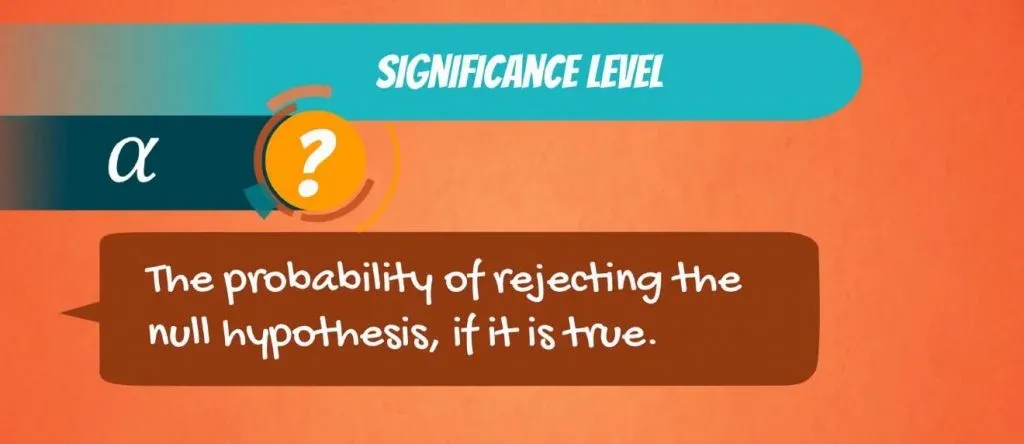
So, the probability of making this error.
Typical values for α are 0.01, 0.05 and 0.1. It is a value that we select based on the certainty we need. In most cases, the choice of α is determined by the context we are operating in, but 0.05 is the most commonly used value.
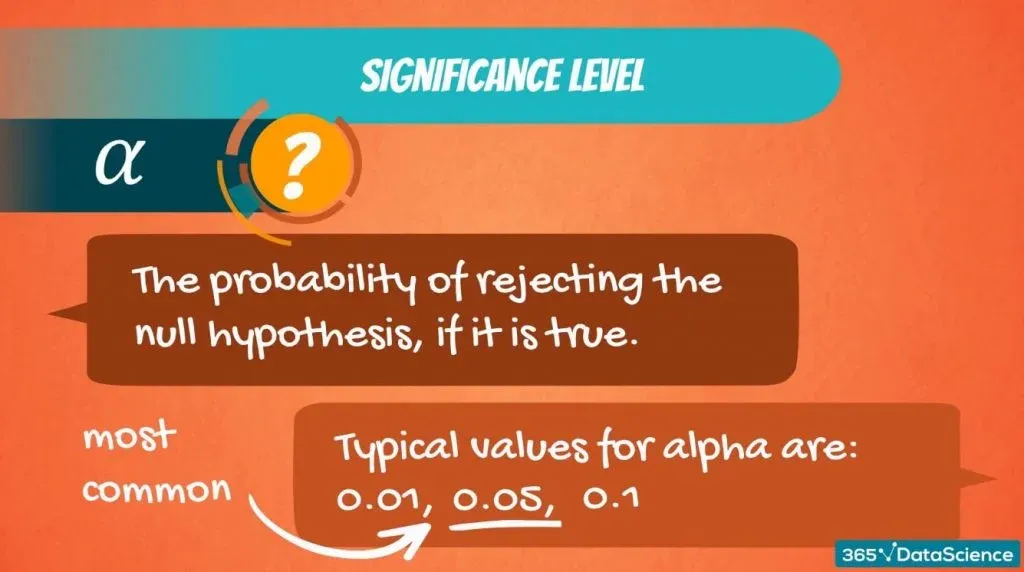
A Case in Point
Say, we need to test if a machine is working properly. We would expect the test to make little or no mistakes. As we want to be very precise, we should pick a low significance level such as 0.01.
The famous Coca Cola glass bottle is 12 ounces. If the machine pours 12.1 ounces, some of the liquid would be spilled, and the label would be damaged as well. So, in certain situations, we need to be as accurate as possible.
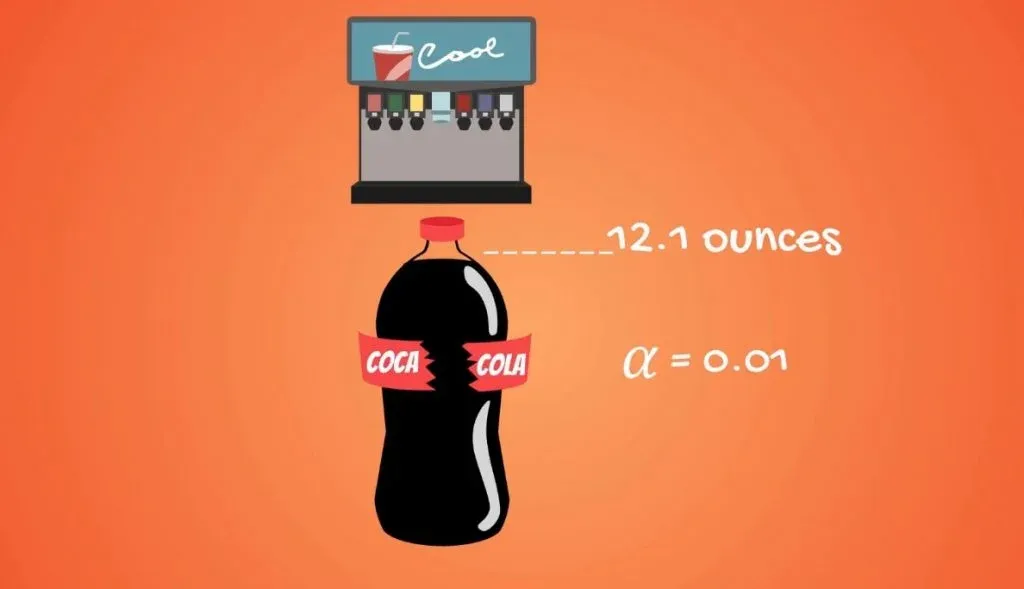
Higher Degree of Error
However, if we are analyzing humans or companies, we would expect more random or at least uncertain behavior. Hence, a higher degree of error.

For instance, if we want to predict how much Coca Cola its consumers drink on average, the difference between 12 ounces and 12.1 ounces will not be that crucial. So, we can choose a higher significance level like 0.05 or 0.1.

Hypothesis Testing: Performing a Z-Test
Now that we have an idea about the significance level , let’s get to the mechanics of hypothesis testing.
Imagine you are consulting a university and want to carry out an analysis on how students are performing on average.

The university dean believes that on average students have a GPA of 70%. Being the data-driven researcher that you are, you can’t simply agree with his opinion, so you start testing.
The null hypothesis is: The population mean grade is 70%.
This is a hypothesized value.
The alternative hypothesis is: The population mean grade is not 70%. You can see how both of them are denoted, below.

Visualizing the Grades
Assuming that the population of grades is normally distributed, all grades received by students should look in the following way.
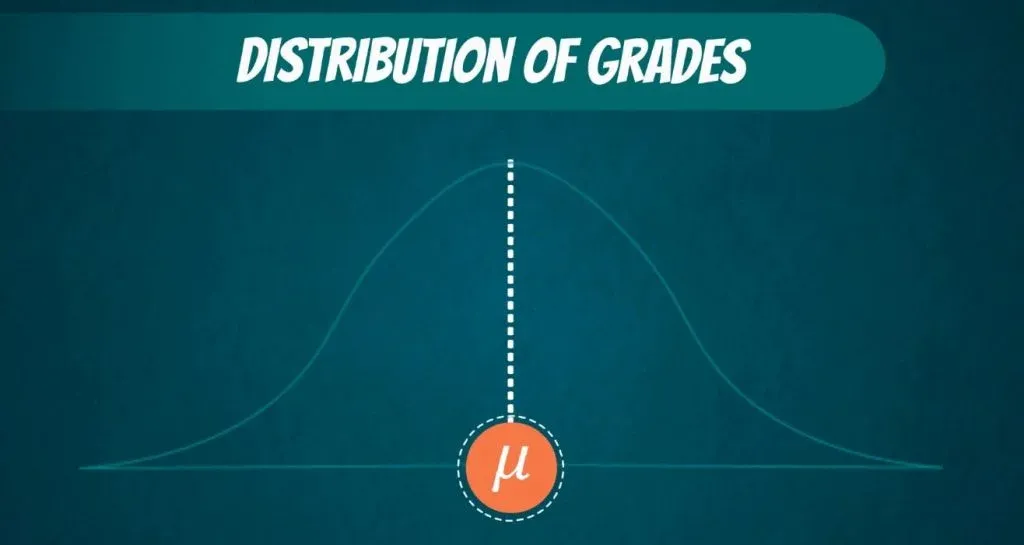
That is the true population mean .
Performing a Z-test
Now, a test we would normally perform is the Z-test . The formula is:
Z equals the sample mean , minus the hypothesized mean , divided by the standard error .
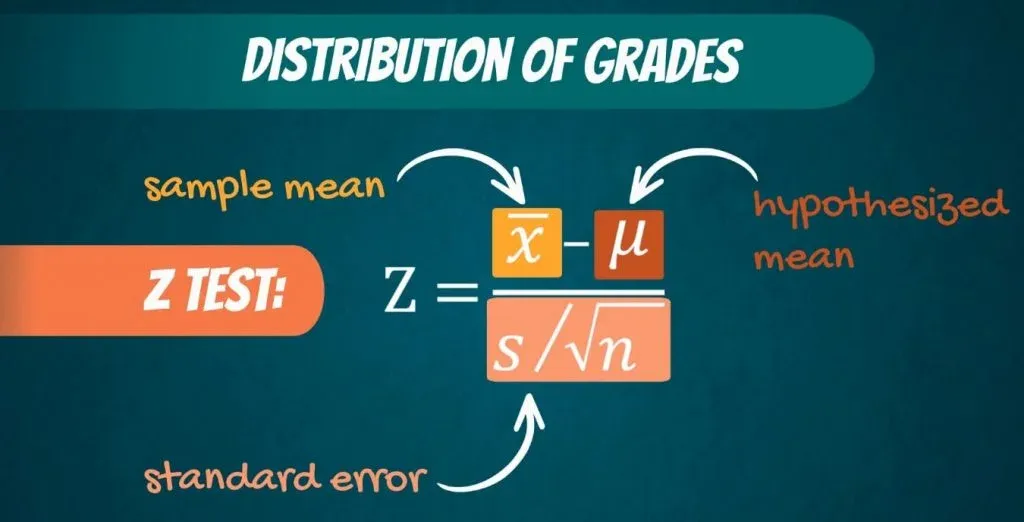
The idea is the following.
We are standardizing or scaling the sample mean we got. (You can quickly obtain it with our Mean, Median, Mode calculator .) If the sample mean is close enough to the hypothesized mean , then Z will be close to 0. Otherwise, it will be far away from it. Naturally, if the sample mean is exactly equal to the hypothesized mean , Z will be 0.
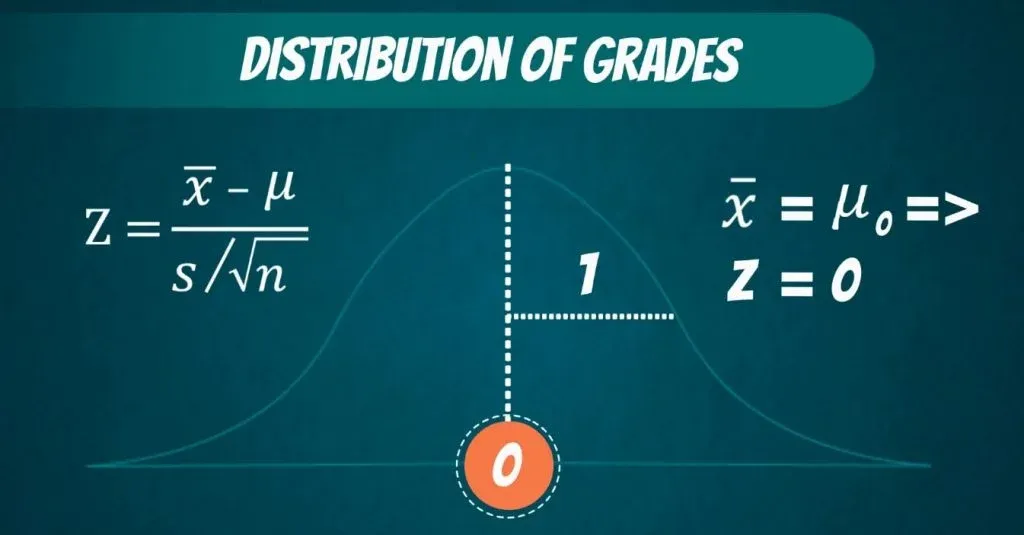
In all these cases, we would accept the null hypothesis .
What Is the Rejection Region?
The question here is the following:
How big should Z be for us to reject the null hypothesis ?
Well, there is a cut-off line. Since we are conducting a two-sided or a two-tailed test, there are two cut-off lines, one on each side.
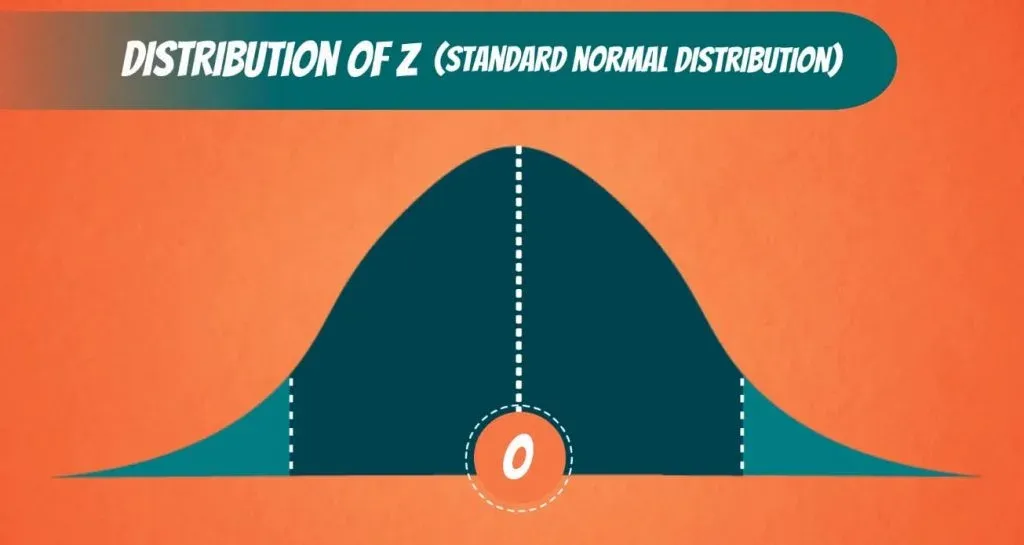
When we calculate Z , we will get a value. If this value falls into the middle part, then we cannot reject the null. If it falls outside, in the shaded region, then we reject the null hypothesis .
That is why the shaded part is called: rejection region , as you can see below.
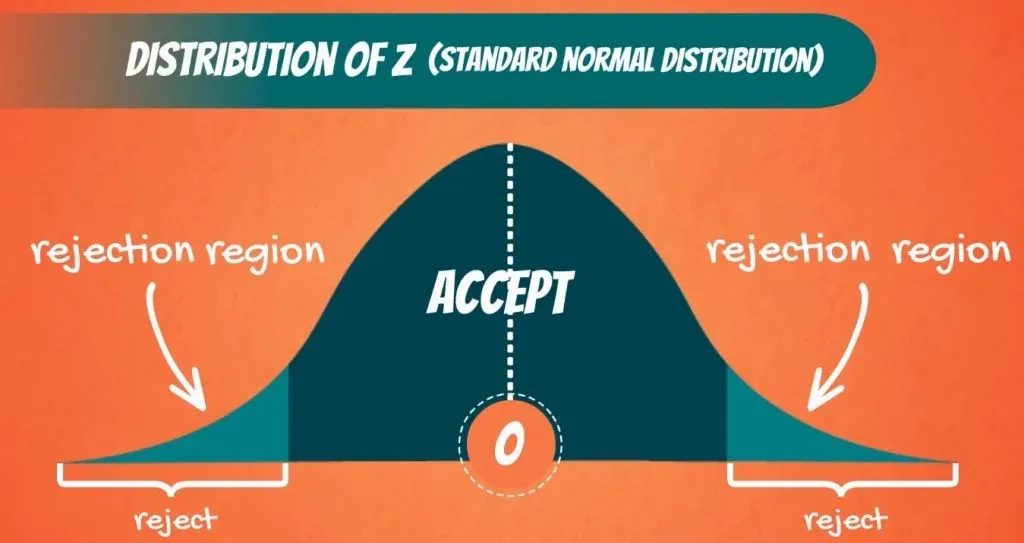
What Does the Rejection Region Depend on?
The area that is cut-off actually depends on the significance level .
Say the level of significance , α , is 0.05. Then we have α divided by 2, or 0.025 on the left side and 0.025 on the right side.
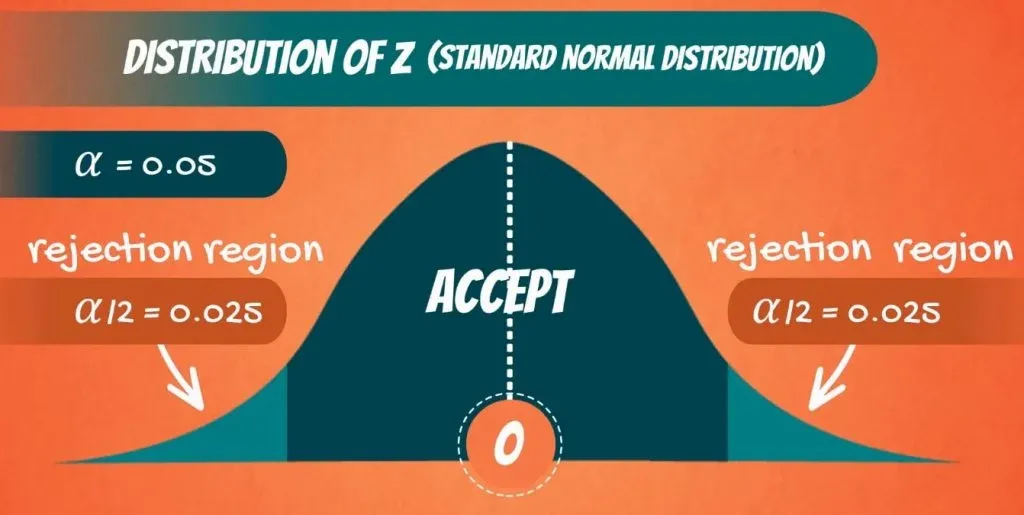
Now these are values we can check from the z-table . When α is 0.025, Z is 1.96. So, 1.96 on the right side and minus 1.96 on the left side.
Therefore, if the value we get for Z from the test is lower than minus 1.96, or higher than 1.96, we will reject the null hypothesis . Otherwise, we will accept it.
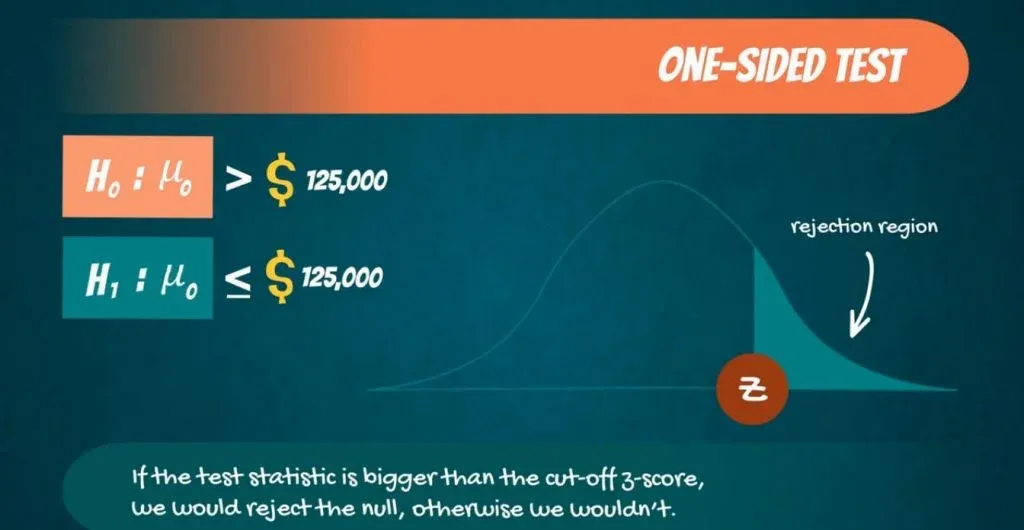
That’s more or less how hypothesis testing works.
We scale the sample mean with respect to the hypothesized value. If Z is close to 0, then we cannot reject the null. If it is far away from 0, then we reject the null hypothesis .
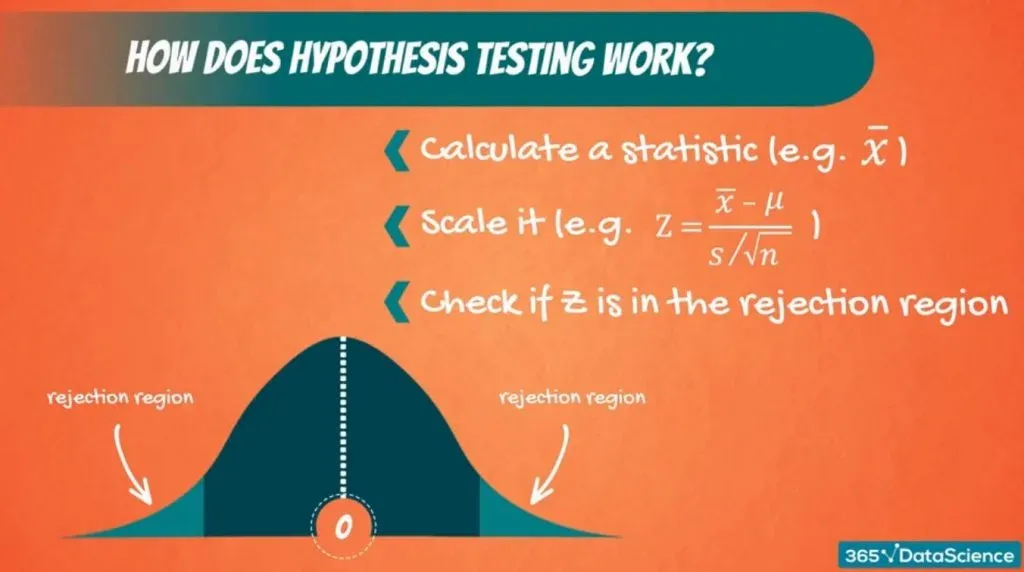
Example of One Tailed Test
What about one-sided tests? We have those too!
Let’s consider the following situation.
Paul says data scientists earn more than $125,000. So, H 0 is: μ 0 is bigger than $125,000.
The alternative is that μ 0 is lower or equal to 125,000.
Using the same significance level , this time, the whole rejection region is on the left. So, the rejection region has an area of α . Looking at the z-table, that corresponds to a Z -score of 1.645. Since it is on the left, it is with a minus sign.
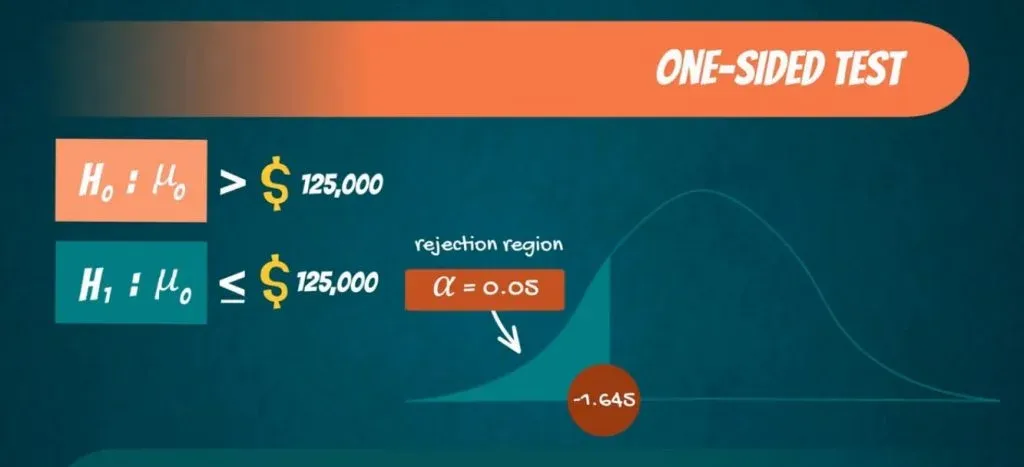
Accept or Reject
Now, when calculating our test statistic Z , if we get a value lower than -1.645, we would reject the null hypothesis . We do that because we have statistical evidence that the data scientist salary is less than $125,000. Otherwise, we would accept it.

Another One-Tailed Test
To exhaust all possibilities, let’s explore another one-tailed test.
Say the university dean told you that the average GPA students get is lower than 70%. In that case, the null hypothesis is:
μ 0 is lower than 70%.
While the alternative is:
μ 0` is bigger or equal to 70%.

In this situation, the rejection region is on the right side. So, if the test statistic is bigger than the cut-off z-score, we would reject the null, otherwise, we wouldn’t.
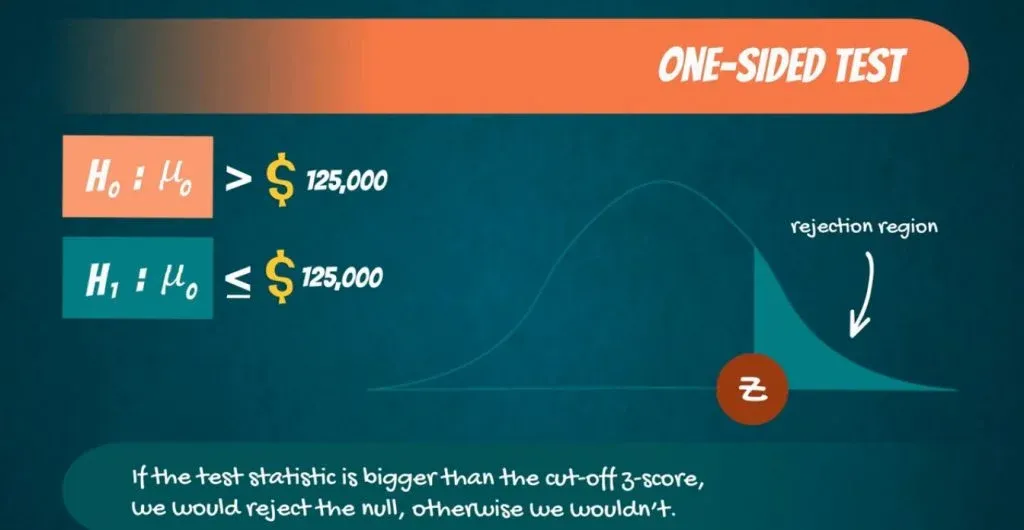
Importance of the Significance Level and the Rejection Region
To sum up, the significance level and the reject region are quite crucial in the process of hypothesis testing. The level of significance conducts the accuracy of prediction. We (the researchers) choose it depending on how big of a difference a possible error could make. On the other hand, the reject region helps us decide whether or not to reject the null hypothesis . After reading this and putting both of them into use, you will realize how convenient they make your work.
Interested in taking your skills from good to great? Try statistics course for free !
Next Tutorial: Providing a Few Linear Regression Examples
World-Class
Data Science
Learn with instructors from:
Iliya Valchanov
Co-founder of 365 Data Science
Iliya is a finance graduate with a strong quantitative background who chose the exciting path of a startup entrepreneur. He demonstrated a formidable affinity for numbers during his childhood, winning more than 90 national and international awards and competitions through the years. Iliya started teaching at university, helping other students learn statistics and econometrics. Inspired by his first happy students, he co-founded 365 Data Science to continue spreading knowledge. He authored several of the program’s online courses in mathematics, statistics, machine learning, and deep learning.
We Think you'll also like

Statistics Tutorials
Hypothesis Testing: Null Hypothesis and Alternative Hypothesis

False Positive vs. False Negative: Type I and Type II Errors in Statistical Hypothesis Testing

Calculating and Using Covariance and Linear Correlation Coefficient

Examples of Numerical and Categorical Variables

- Critical Value
Calculate Critical Z Value

Enter a probability value between zero and one to calculate critical value. Critical values determine what probability a particular variable will have when a sampling distribution is normal or close to normal.
| Probability Value | Input |
|---|---|
| Critical Value | Output |
|---|---|
Probability (p): p = 1 - α/2.
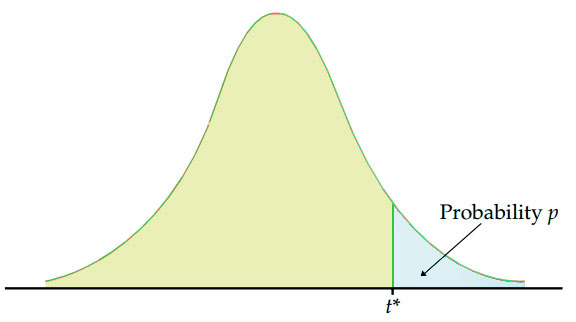
Critical Value: Definition and Significance in the Real World
- Guide Authored by Corin B. Arenas , published on October 4, 2019
Ever wondered if election surveys are accurate? How about statistics on housing, health care, and testing scores?
In this section, we’ll discuss how sample data is tested for accuracy. Read on to learn more about critical value, how it’s used in statistics, and its significance in social science research.
What is a Critical Value?

In testing statistics, a critical value is a factor that determines the margin of error in a distribution graph.
According to Statistics How To , a site headed by math educator Stephanie Glen, if the absolute value of a test statistic is greater than the critical value, then there is statistical significance that rejects an accepted hypothesis.
Critical values divide a distribution graph into sections which indicate ‘rejection regions.’ Basically, if a test value falls within a rejection region, it means an accepted hypothesis (referred to as a null hypothesis) must be rejected. And if the test value falls within the accepted range, the null hypothesis cannot be rejected.
Testing sample data involves validating research and surveys like voting habits, SAT scores, body fat percentage, blood pressure, and all sorts of population data.
Hypothesis Testing and the Distribution Curve

Hypothesis tests check if your data was taken from a sample population that adheres to a hypothesized probability distribution. It is characterized by a null hypothesis and an alternative hypothesis.
In hypothesis testing, a critical value is a point on a distribution graph that is analyzed alongside a test statistic to confirm if a null hypothesis —a commonly accepted fact in a study which researchers aim to disprove—should be rejected.
The value of a null hypothesis implies that no statistical significance exists in a set of given observations. It is assumed to be true unless statistical evidence from an alternative hypothesis invalidates it.
How does this relate with distribution graphs? A normal distribution curve, which is a bell-shaped curve, is a theoretical representation of how often an experiment will yield a particular result.
Elements of Normal Distribution:
- Has a mean, median, or mode. A mean is the average of numbers in a group, a median is the middle number in a list of numbers, and a mode is a number that appears most often in a set of numbers.
- 50% of the values are less than the mean
- 50% of the values are greater than the mean
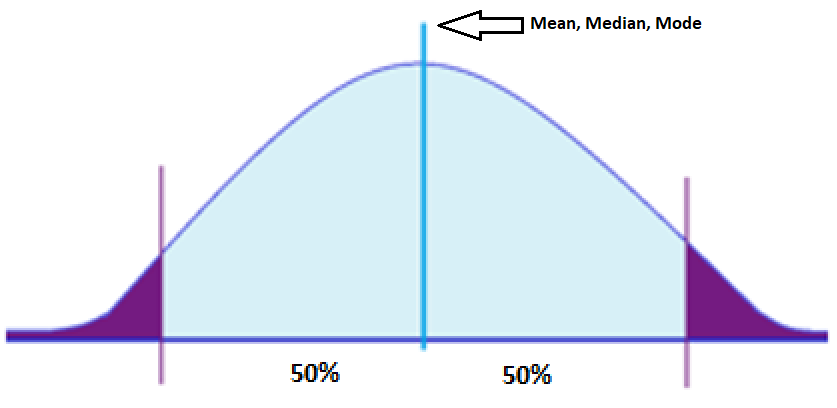
Majority of the data points in normal distribution are relatively similar. A perfectly normal distribution is characterized by its symmetry, meaning half of the data observations fall on either side of the middle of the graph. This implies that they occur within a range of values with fewer outliers on the high and low points of the graph.
Given these implications, critical values do not fall within the range of common data points. Which is why when a test statistic exceeds the critical value, a null hypothesis is forfeited.
Take note: Critical values may look for a two-tailed test or one-tailed test (right-tailed or left-tailed). Depending on the data, statisticians determine which test to perform first.
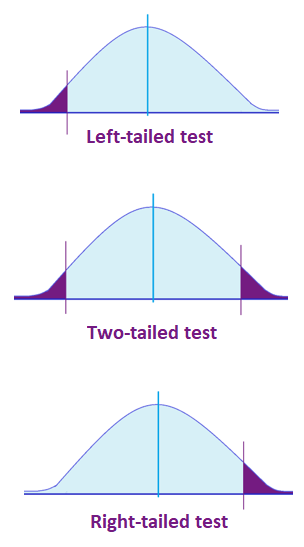
Finding the Critical Value

The standard equation for the probability of a critical value is:
p = 1 – α/2
Where p is the probability and alpha (α) represents the significance or confidence level. This establishes how far off a researcher will draw the line from the null hypothesis.
The alpha functions as the alternative hypothesis. It signifies the probability of rejecting the null hypothesis when it is true. For instance, if a researcher wants to establish a significance level of 0.05, it means there is a 5% chance of finding that a difference exists.
When the sampling distribution of a data set is normal or close to normal, the critical value can be determined as a z score or t score .
Z Score or T Score: Which Should You Use?
Typically, when a sample size is big (more than 40) using z or t statistics is fine. However, while both methods compute similar results, most beginner’s textbooks on statistics use the z score.
When a sample size is small and the standard deviation of a population is unknown, the t score is used. The t score is a probability distribution that allows statisticians to perform analyses on specific data sets using normal distribution. But take note: Small samples from populations that are not approximately normal should not use the t score.
What’s a standard deviation ? This measures how numbers are spread out in a set of values, showing the amount of variation. Low standard deviation means the numbers are close to the mean set, while a high standard deviation signifies numbers are dispersed at a wider range.
Calculating Z Score
The critical value of a z score can be used to determine the margin of error, as shown in the equations below:
- Margin of error = Critical value x Standard deviation of the statistic
- Margin of error = Critical value x Standard error of the statistic
The z score , also known as the standard normal probability score, signifies how many standard deviations a statistical element is from the mean. A z score table is used in hypothesis testing to check proportions and the difference between two means. Z tables indicate what percentage of the statistics is under the curve at any given point.
| cumulative prob | t .50 | t .75 | t .80 | t .85 | t .90 | t .95 | t.975 | t .98 | t .99 | t .995 | t . 9975 | t .999 | t .9995 |
|---|---|---|---|---|---|---|---|---|---|---|---|---|---|
| α 1-tail | .5 | .25 | .20 | .15 | .10 | .05 | .025 | .02 | .01 | .005 | .0025 | .001 | .0005 |
| α 2-tail | 1 | .50 | .40 | .30 | .20 | .10 | .050 | .04 | .02 | .010 | .0050 | .002 | .0010 |
| df | |||||||||||||
| z | 0.00 | 0.674 | 0.841 | 1.036 | 1.282 | 1.645 | 1.960 | 2.054 | 2.326 | 2.576 | 2.807 | 3.091 | 3.291 |
| 1 | 0.00 | 1.000 | 1.376 | 1.963 | 3.078 | 6.314 | 12.71 | 15.89 | 31.82 | 63.66 | 127.3 | 318.3 | 636.6 |
| 2 | 0.00 | 0.816 | 1.061 | 1.386 | 1.886 | 2.920 | 4.303 | 4.849 | 6.965 | 9.925 | 14.09 | 22.33 | 31.60 |
| 3 | 0.00 | 0.765 | 0.978 | 1.250 | 1.638 | 2.353 | 3.182 | 3.482 | 4.541 | 5.841 | 7.453 | 10.21 | 12.92 |
| 4 | 0.00 | 0.741 | 0.941 | 1.190 | 1.533 | 2.132 | 2.776 | 2.999 | 3.747 | 4.604 | 5.598 | 7.173 | 8.610 |
| 5 | 0.00 | 0.727 | 0.920 | 1.156 | 1.476 | 2.015 | 2.571 | 2.757 | 3.365 | 4.032 | 4.773 | 5.893 | 6.869 |
| 6 | 0.00 | 0.718 | 0.906 | 1.134 | 1.440 | 1.943 | 2.447 | 2.612 | 3.143 | 3.707 | 4.317 | 5.208 | 5.959 |
| 7 | 0.00 | 0.711 | 0.896 | 1.119 | 1.415 | 1.895 | 2.365 | 2.517 | 2.998 | 3.499 | 4.029 | 4.785 | 5.408 |
| 8 | 0.00 | 0.706 | 0.889 | 1.108 | 1.397 | 1.860 | 2.306 | 2.449 | 2.896 | 3.355 | 3.833 | 4.501 | 5.041 |
| 9 | 0.00 | 0.703 | 0.883 | 1.100 | 1.383 | 1.833 | 2.262 | 2.398 | 2.821 | 3.250 | 3.690 | 4.297 | 4.781 |
| 10 | 0.00 | 0.700 | 0.879 | 1.093 | 1.372 | 1.812 | 2.228 | 2.359 | 2.764 | 3.169 | 3.581 | 4.144 | 4.587 |
| 11 | 0.00 | 0.697 | 0.876 | 1.088 | 1.363 | 1.796 | 2.201 | 2.328 | 2.718 | 3.106 | 3.497 | 4.025 | 4.437 |
| 12 | 0.00 | 0.695 | 0.873 | 1.083 | 1.356 | 1.782 | 2.179 | 2.303 | 2.681 | 3.055 | 3.428 | 3.930 | 4.318 |
| 13 | 0.00 | 0.694 | 0.870 | 1.079 | 1.350 | 1.771 | 2.160 | 2.282 | 2.650 | 3.012 | 3.372 | 3.852 | 4.221 |
| 14 | 0.00 | 0.692 | 0.868 | 1.076 | 1.345 | 1.761 | 2.145 | 2.264 | 2.624 | 2.977 | 3.326 | 3.787 | 4.140 |
| 15 | 0.00 | 0.691 | 0.866 | 1.074 | 1.341 | 1.753 | 2.131 | 2.249 | 2.602 | 2.947 | 3.286 | 3.733 | 4.073 |
| 16 | 0.00 | 0.690 | 0.865 | 1.071 | 1.337 | 1.746 | 2.120 | 2.235 | 2.583 | 2.921 | 3.252 | 3.686 | 4.015 |
| 17 | 0.00 | 0.689 | 0.863 | 1.069 | 1.333 | 1.740 | 2.110 | 2.224 | 2.567 | 2.898 | 3.222 | 3.646 | 3.965 |
| 18 | 0.00 | 0.688 | 0.862 | 1.067 | 1.330 | 1.734 | 2.101 | 2.214 | 2.552 | 2.878 | 3.197 | 3.611 | 3.922 |
| 19 | 0.00 | 0.688 | 0.861 | 1.066 | 1.328 | 1.729 | 2.093 | 2.205 | 2.539 | 2.861 | 3.174 | 3.579 | 3.883 |
| 20 | 0.00 | 0.687 | 0.860 | 1.064 | 1.325 | 1.725 | 2.086 | 2.197 | 2.528 | 2.845 | 3.153 | 3.552 | 3.850 |
| 21 | 0.00 | 0.686 | 0.859 | 1.063 | 1.323 | 1.721 | 2.080 | 2.189 | 2.518 | 2.831 | 3.135 | 3.527 | 3.819 |
| 22 | 0.00 | 0.686 | 0.858 | 1.061 | 1.321 | 1.717 | 2.074 | 2.183 | 2.508 | 2.819 | 3.119 | 3.505 | 3.792 |
| 23 | 0.00 | 0.685 | 0.858 | 1.060 | 1.319 | 1.714 | 2.069 | 2.177 | 2.500 | 2.807 | 3.104 | 3.485 | 3.768 |
| 24 | 0.00 | 0.685 | 0.857 | 1.059 | 1.318 | 1.711 | 2.064 | 2.172 | 2.492 | 2.797 | 3.091 | 3.467 | 3.745 |
| 25 | 0.00 | 0.684 | 0.856 | 1.058 | 1.316 | 1.708 | 2.060 | 2.167 | 2.485 | 2.787 | 3.078 | 3.450 | 3.725 |
| 26 | 0.00 | 0.684 | 0.856 | 1.058 | 1.315 | 1.706 | 2.056 | 2.162 | 2.479 | 2.779 | 3.067 | 3.435 | 3.707 |
| 27 | 0.00 | 0.684 | 0.855 | 1.057 | 1.314 | 1.703 | 2.052 | 2.158 | 2.473 | 2.771 | 3.057 | 3.421 | 3.690 |
| 28 | 0.00 | 0.683 | 0.855 | 1.056 | 1.313 | 1.701 | 2.048 | 2.154 | 2.467 | 2.763 | 3.047 | 3.408 | 3.674 |
| 29 | 0.00 | 0.683 | 0.854 | 1.055 | 1.311 | 1.699 | 2.045 | 2.150 | 2.462 | 2.756 | 3.038 | 3.396 | 3.659 |
| 30 | 0.00 | 0.683 | 0.854 | 1.055 | 1.310 | 1.697 | 2.042 | 2.147 | 2.457 | 2.750 | 3.030 | 3.385 | 3.646 |
| 40 | 0.00 | 0.681 | 0.851 | 1.050 | 1.303 | 1.684 | 2.021 | 2.123 | 2.423 | 2.704 | 2.971 | 3.307 | 3.551 |
| 50 | 0.00 | 0.679 | 0.849 | 1.047 | 1.299 | 1.676 | 2.009 | 2.109 | 2.403 | 2.678 | 2.937 | 3.261 | 3.496 |
| 60 | 0.00 | 0.679 | 0.848 | 1.045 | 1.296 | 1.671 | 2.000 | 2.099 | 2.390 | 2.660 | 2.915 | 3.232 | 3.460 |
| 80 | 0.00 | 0.678 | 0.846 | 1.043 | 1.292 | 1.664 | 1.990 | 2.088 | 2.374 | 2.639 | 2.887 | 3.195 | 3.416 |
| 100 | 0.00 | 0.677 | 0.845 | 1.042 | 1.290 | 1.660 | 1.984 | 2.081 | 2.364 | 2.626 | 2.871 | 3.174 | 3.390 |
| 1000 | 0.00 | 0.675 | 0.842 | 1.037 | 1.282 | 1.646 | 1.962 | 2.056 | 2.330 | 2.581 | 2.813 | 3.098 | 3.300 |
| 0% | 50% | 60% | 70% | 80% | 90% | 95% | 96% | 98% | 99% | 99.5% | 99.8% | 99.9% |
The basic formula for a z score sample is:
z = (X – μ) / σ
- X is the value of the element
- μ is the population mean
- σ is the standard deviation
Let’s solve an example. For instance, let’s say you have a test score of 85. If the test has a mean (μ) of 45 and a standard deviation (σ) of 23, what’s your z score? X = 85, μ = 45, σ = 23
z = (85 – 45) / 23 = 40 / 23 z = 1.7391
For this example, your score is 1.7391 standard deviations above the mean.
What do the z scores imply?
- If a score is greater than 0, the statistic sample is greater than the mean
- If the score is less than 0, the statistic sample is less than the mean
- If a score is equal to 1, it means the sample is 1 standard deviation greater than the mean, and so on
- If a score is equal to -1, it means the sample is 1 standard deviation less than the mean, and so on
For elements in a large set:
- Around 68% fall between -1 and 1
- Around 95% fall between -2 and 2
- Around 99% fall between -3 and 3
To give you an idea, here’s how spread out statistical elements would look like under a z score graph:
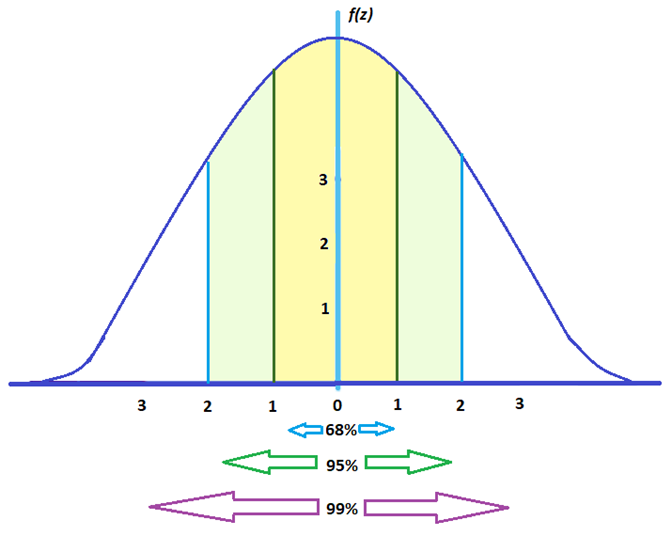
Calculating T Score
On the other hand, here’s the standard formula for the t score:
t = [ x – μ ] / [ s / sqrt( n ) ]
- x is the sample mean
- s is the sample’s standard deviation
- n is the sample size
Then, we account for the degrees of freedom (df) which is the sample size minus 1. df = n – 1
T distribution, also known as the student’s distribution, is associated with a unique cumulative probability. This signifies the chance of finding a sample mean that’s less than or equal to x, based on a random sample size n. Cumulative probability refers to the likelihood that a random variable would fall within a specific range. To express the t statistic with a cumulative probability of 1 – α, statisticians use t α .
Part of finding the t score is locating the degrees of freedom (df) using the t distribution table as a reference. For demonstration purposes, let’s say you have a small sample of 5 and you want to conduct a right-tailed test. Follow the steps below.
5 df, α = 0.05
- Take your sample size and subtract 1. 5 – 1 = 4. df = 4
- For this example, let’s say the alpha level is 5% (0.05).
- Look for the df in the t distribution table along with its corresponding alpha level. You’ll find the critical value where the column and row intersect.
| df | α = 0.1 | 0.025 | 0.01 | 0.005 | |
| ∞ | = 1.2816 | 1.6449 | 1.96 | 2.3263 | 2.5758 |
| 1 | 3.078 | 6.314 | 12.706 | 31.821 | 63.656 |
| 2 | 1.886 | 2.920 | 4.303 | 6.965 | 9.925 |
| 3 | 1.638 | 2.353 | 3.182 | 4.541 | 5.841 |
| 1.533 | 2.776 | 3.747 | 4.604 | ||
| 5 | 1.476 | 2.015 | 2.571 | 3.365 | 4.032 |
*One-tail t distribution table referenced from How to Statistics. In this example, 5 df, α = 0.05, the critical value is 2.132.
Here’s another example using the t score formula.
A factory produces CFL light bulbs. The owner says that CFL bulbs from their factory lasts for 160 days. Quality specialists randomly chose 20 bulbs for testing, which lasted for an average of 150 days, with a standard deviation of 40 days. If the CFL bulbs really last for 160 days, what is the probability that 20 random CFL bulbs would have an average life that’s less than 150 days?
t = [ 150 – 160 ] / [ 40 / sqrt( 20 ) ] = -10 / [40 / 4.472135] = -10 / 8.94427 t = -1.118034
The degrees of freedom: df = 20 – 1, df = 19
Again, use the variables above to refer to a t distribution table, or use a t score calculator.
For this example, the critical value is 0.1387 . Thus, if the life of a CFL light bulb is 160 days, there is a 13.87% probability that the average CFL bulb for 20 randomly chosen bulbs would be less than or equal to 150 days.
If we were to plot the critical value and shade the rejection region in a graph, it would look like this:
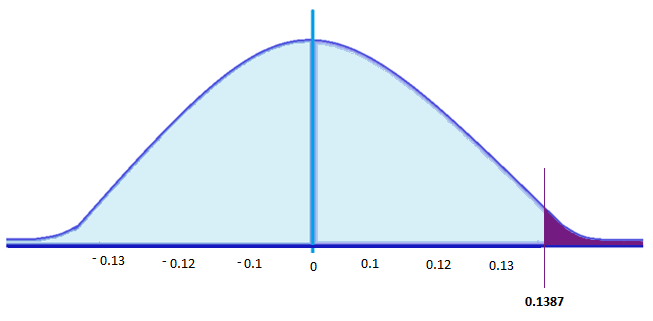
If a test statistic is greater than this critical value, then the null hypothesis, which is ‘CFL light bulbs have a life of 160 days,’ should be rejected. That’s if tests show more than 13.87% of the sample light bulbs (20) have a lifespan of less than or equal 150 days.
Why is Determining Critical Value Important?
Researchers often work with a sample population, which is a small percentage when they gather statistics.
Working with sample populations does not guarantee that it reflects the actual population’s results. To test if the data is representative of the actual population, researchers conduct hypothesis testing which make use of critical values.
What are Real-World Uses for It?

Validating statistical knowledge is important in the study of a wide range of fields. This includes research in social sciences such as economics, psychology, sociology, political science, and anthropology.
For one, it keeps quality management in check. This includes product testing in companies and analyzing test scores in educational institutions.
Moreover, hypothesis testing is crucial for the scientific and medical community because it is imperative for the advancement of theories and ideas.
If you’ve come across research that studies behavior, then the study likely used hypothesis testing and sampling in populations. From the public’s voting behavior, to what type of houses people tend to buy, researchers conduct distribution tests.
Studies such as how male adolescents in certain states are prone to violence, or how children of obese parents are prone to becoming obese, are other examples that use critical values in distribution testing.
In the field of health care, topics like how often diseases like measles, diphtheria, or polio occur in an area is relevant for public safety. Testing would help communities know if there are certain health conditions rising at an alarming rate. This is especially relevant now in the age of anti-vaccine activists .
The Bottom Line
Finding critical values are important for testing statistical data. It’s one of the main factors in hypothesis testing, which can validate or disprove commonly accepted information.
Proper analysis and testing of statistics help guide the public, which corrects misleading or dated information.
Hypothesis testing is useful in a wide range of disciplines, such as medicine, sociology, political science, and quality management in companies.
About the Author
Corin is an ardent researcher and writer of financial topics—studying economic trends, how they affect populations, as well as how to help consumers make wiser financial decisions. Her other feature articles can be read on Inquirer.net and Manileno.com. She holds a Master’s degree in Creative Writing from the University of the Philippines, one of the top academic institutions in the world, and a Bachelor’s in Communication Arts from Miriam College.
How to Excel at Math Cartoon

- Trigonometry
- Percent Off
- Statistical Average
- Standard Deviation
- Correlation
- Probability
- Log/Antilog
- HEX & Binary
- Weight/Mass
- Temperature
- Current Time
- Time Duration
- Balance Equations
Play & Learn

Pin It on Pinterest
Rejection Region (Critical Region) for Statistical Tests
Hypothesis Testing >
What is a Rejection Region?
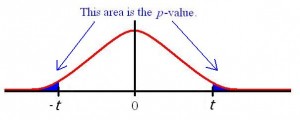
A rejection region (also called a critical region ) is an area of a graph where you would reject the null hypothesis if your test results fall into that area. In other words, if your results fall into that area then they are statistically significant .
The main purpose of statistics is to test theories or results from experiments. For example, you might have invented a new fertilizer that you think makes plants grow 50% faster. In order to prove your theory is true, your experiment must:
- Be repeatable.
- Be compared to a known fact about plants (in this example, probably the average growth rate of plants without the fertilizer).
We call this type of statistical testing a hypothesis test . The rejection region is a part of the testing process. Specifically, it is an area of probability that tells you if your theory (your “”hypothesis”) is probably true.
Two Tailed vs One Tailed
Which type of test is determined by your null hypothesis statement. For example, if your statement asks “Is the average growth rate greater than 10cm a day?” that’s a one tailed test, because you are only interested in one direction (greater than 10cm a day).
You could also have a single rejection region for “less than”. For example, “Is the growth rate less than 10cm a day?” A two tailed test , with two regions, would be used when you want to know if there’s a difference in both directions (greater than and less than).
Rejection Regions and Alpha Levels
You, as a researcher, choose the alpha level you are willing to accept. For example, if you wanted to be 95% confident that your results are significant , you would choose a 5% alpha level (100% – 95%). That 5% level is the rejection region . For a one tailed test , the 5% would be in one tail. For a two tailed test, the rejection region would be in two tails.
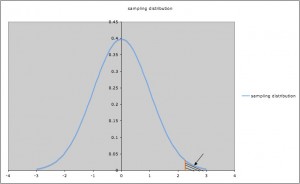
Rejection Regions and P-Values.
There are two ways you can test a hypothesis: with a p-value and with a critical value .
P-value method : When you run a hypothesis test (for example, a z test ), the result of that test will be a p value . The p value is a “probability value.” It’s what tells you if your hypothesis statement is probably true or not. If the value falls in the rejection region, it means you have statistically significant results; You can reject the null hypothesis . If the p-value falls outside the rejection region, it means your results aren’t enough to throw out the null hypothesis. In the example of the plant fertilizer, a statistically significant result would be one that shows the fertilizer does indeed make plants grow faster (compared to other fertilizers).
Rejection Region method with a critical value : The steps are exactly the same. However, instead of calculating a p-value you calculate a critical value. If the value falls inside the region, you reject the null hypothesis.
Next : What is an Acceptance Region?
Check out our YouTube channel for more stats help and tips!
Beyer, W. H. CRC Standard Mathematical Tables, 31st ed. Boca Raton, FL: CRC Press, pp. 536 and 571, 2002. Dodge, Y. (2008). The Concise Encyclopedia of Statistics . Springer. Lindstrom, D. (2010). Schaum’s Easy Outline of Statistics , Second Edition (Schaum’s Easy Outlines) 2nd Edition. McGraw-Hill Education Wheelan, C. (2014). Naked Statistics . W. W. Norton & Company
Critical Value Calculator
- Chi-square Value
| Probabilities | P |
|---|---|
| one-tailed for —z | -- |
| one-tailed for +z | -- |
| two-tailed for ±z | -- |
| area between ±z | -- |
| Large value of z: | |
|---|---|
| P[one-tail] | -- |
| P[two-tail] | -- |
| tArea between | -- |
Please Fill aleat 1 row
Give your feedback!

| 1 | |
| 2 | |
| 3 | |
| 4 | |
| 5 | |
| 6 | |
| 7 |
What is Critical Value
In literal terms, critical value is defined as any point present on a line which dissects the graph into two equal parts. The rejection or acceptance of null hypothesis depends on the region in which the value falls. The rejection region is defined as one of the two sections that are split by the critical value. If the test value is present in the rejection region, then the null hypothesis would not have any acceptance.
Critical Value Formula
Two formulae can be used to determine the critical value. These are listed as follows.
1. \(\mathrm{Critical Value = \dfrac{Margin\ of\ Error} {Standard\ Deviation}}\)
2. \( \mathrm {Critical Value = \dfrac{Margin\ of\ Error} {Standard\ Error\ of\ Sample}} \)
Anyone of the two formulae listed above can be used to determine Critical Value depending on the known values.
How to calculate critical value? - steps and process
Here are the steps you need to complete for calculating the critical value
1. Determination of Alpha
This is the first step which the user has to complete for finding out the critical value. To determine the value of Alpha level, the following formula will be used.
\( \mathrm{Alpha\ Level} = 100% - \mathrm{Confidence Interval} \)
Consider that the confidence interval is 80%. Thus, Alpha Level will be given as.
\( \mathrm{Alpha\ Level} = 100 - 80 \)
\( \mathrm{Alpha\ Level} = 20% \)
2. Converting the Alpha Percentage Value to Decimal
The second step involves converting the value of alpha to decimal. By default, it has the percentage unit. Hence, convert it to the decimal format. In step, the value of alpha is 20%. Thus, in terms of decimals, it would be \(0.2\)
\( \alpha = 0.2 \)
3. Divide the value of Alpha by 2
In this step, the value of alpha determined in step 2 would be divided by \(2\). In the above example, the value of alpha is \(0.2\) .
\( \textbf{Thus}, \dfrac{\alpha} {2} = \dfrac{0.2}{2} \)
\( \dfrac{\alpha}{2} = 0.1 \)
4. Subtract the result determined in step 3 from 1
The value of α /2 = 0.1. In this step, subtract this value from 1.
\( \textbf{Thus}, 1 - \, 0.1 = 0.9 \)
Converting this decimal value to a percentage. Thus, 0.9 would be 90%. The corresponding critical value will be for a confidence interval of 90%. It would be given as:
\( \mathbf{Z = 1.645} \)
Note: To calculate t critical value, f critical value, r critical value, z critical value and chi-square critical use our advance critical values calculator. It helps to calculate the value from the Z table very quickly in real-time.
Common confidence levels and their critical values
The common confidence levels and the corresponding critical values in the form of a table are given below.
| Confidence Level | Critical Value (Z-score) |
| 0.90 | 1.645 |
| 0.91 | 1.70 |
| 0.92 | 1.75 |
| 0.93 | 1.81 |
| 0.94 | 1.88 |
| 0.95 | 1.96 |
| 0.96 | 2.05 |
| 0.97 | 2.17 |
| 0.98 | 2.33 |
| 0.99 | 2.57 |
Types of Critical Values
To get the null hypothesis, various methods are used to determine the required area. The common methods used include z tests, t scores and also chi tests. All these methods are used to determine null hypothesis. However, null hypothesis is the area between right and left tails. The right tail has positive values while the left tail has negative ones. This point is incorporated when the critical value has to be determined.
Critical Value of Z
The standard normal model is used to determine the value of Z. The graphical display of normal distribution shows that the graph is divided into two main regions. The first one is called the Central Region and the other is the Tail Region.
- The central region includes the values of Standard Deviation. These values are derived from the mean.
- The tail values are on the edges of the graph. These values are determined after excluding the central region. To determine the tail values, the following formula is used.
\( \mathrm {Tail Value = 1 \space - \space Central Value} \)
Assistance offered by this critical value calculator
This tool is actually very helpful for the determination of critical value. It cuts down the time needed to determine critical value. Other than that, it is very easy to use so users are able to calculate the correct results without any difficulties.
- To use the tool, enter the degrees of freedom (DF) and the value of Alpha (α). Consider that the value of DF is 12 and Alpha is 0.5. Once the values have been entered, click the calculate button to get the results.
- In accordance with these entered values, the following results would be generated.
- T Value is 0
- Upper Probability is 0.31
- T Value Right Tailed is 0.031
- Total Reviews 0
- Overall Rating 0 / 5
Your Review Will Appear Soon.
Rejection Region Calculator: A Comprehensive Guide for Hypothesis Testing
In the realm of statistics, hypothesis testing plays a crucial role in determining the validity of claims or assumptions made about a population based on a sample. At the heart of hypothesis testing lies the concept of a rejection region, a pivotal area that determines whether the null hypothesis is rejected or not.
The rejection region calculator serves as an invaluable tool for researchers and statisticians, simplifying the process of calculating and visualizing the rejection region for a given hypothesis test. Whether you're dealing with a one-tailed or two-tailed test, this guide will equip you with the knowledge and understanding necessary to utilize the rejection region calculator effectively.
Before delving into the specifics of the rejection region calculator, it's essential to establish a solid grasp of the underlying concepts. This includes understanding the significance level, p-value, and null hypothesis - all key elements in the hypothesis testing framework.
rejection region calculator
A statistical tool for hypothesis testing.
Calculates the rejection region.
Determines if the null hypothesis is rejected., used in one-tailed and two-tailed tests., involves significance level and p-value., simplifies hypothesis testing process., provides visual representation of rejection region., essential for statistical analysis., available online and in statistical software..
The rejection region calculator is an invaluable tool for researchers and statisticians, enabling efficient and accurate hypothesis testing.
The rejection region calculator performs a crucial task in hypothesis testing: determining the rejection region for a given significance level and sample size. This region, also known as the critical region, represents the range of values for the test statistic that would lead to the rejection of the null hypothesis.
The calculator determines the critical values that define the boundaries of the rejection region. These values are based on the significance level and the distribution of the test statistic.
The rejection region can be one-tailed or two-tailed, depending on the alternative hypothesis. In a one-tailed test, the rejection region is located in one direction (either the left or right tail of the distribution), while in a two-tailed test, it is located in both tails.
Many rejection region calculators provide a visual representation of the rejection region, allowing researchers to easily visualize the critical values and the area where the null hypothesis is rejected.
Once the rejection region is calculated, the test statistic is compared to the critical values. If the test statistic falls within the rejection region, the null hypothesis is rejected; otherwise, it is not rejected.
By calculating the rejection region, the rejection region calculator simplifies the hypothesis testing process and provides a clear indication of the range of values that would lead to the rejection of the null hypothesis.
The rejection region calculator plays a pivotal role in determining whether the null hypothesis is rejected or not. This decision is based on the comparison between the test statistic and the critical values that define the rejection region.
Hypothesis testing process:
- Formulate the null and alternative hypotheses: The null hypothesis (H0) represents the claim or assumption being tested, while the alternative hypothesis (H1) represents the opposite or contrasting claim.
- Select the appropriate test statistic: The choice of test statistic depends on the type of data, the research question, and the assumptions of the test.
- Calculate the test statistic: Using the sample data, the test statistic is calculated. This value quantifies the discrepancy between the observed data and what would be expected under the null hypothesis.
- Determine the rejection region: The rejection region calculator determines the critical values and the rejection region based on the significance level and the distribution of the test statistic.
- Compare the test statistic to the critical values: The test statistic is then compared to the critical values that define the rejection region. This comparison determines whether the test statistic falls within the rejection region.
Decision-making:
- Reject the null hypothesis: If the test statistic falls within the rejection region, it is considered statistically significant, and the null hypothesis is rejected. This means that the evidence supports the alternative hypothesis.
- Fail to reject the null hypothesis: If the test statistic does not fall within the rejection region, it is considered statistically insignificant, and the null hypothesis is not rejected. However, this does not necessarily mean that the null hypothesis is true; it simply means that there is not enough evidence to reject it.
The rejection region calculator simplifies this decision-making process by providing clear boundaries for the rejection region, allowing researchers to easily determine whether the null hypothesis should be rejected or not.
The rejection region calculator can be used in both one-tailed and two-tailed hypothesis tests. The type of test used depends on the research question and the direction of the expected effect.
One-tailed test:
- In a one-tailed test, the researcher has a specific expectation about the direction of the effect. For example, they may hypothesize that the mean of Group A will be greater than the mean of Group B.
- In this case, the rejection region is located in only one tail of the distribution (either the left or right tail), depending on the direction of the hypothesized effect.
- If the test statistic falls within the rejection region, it provides strong evidence in support of the hypothesized direction of the effect, and the null hypothesis is rejected.
Two-tailed test:
- In a two-tailed test, the researcher does not have a specific expectation about the direction of the effect. They are simply testing whether there is a significant difference between the two groups, regardless of the direction.
- In this case, the rejection region is located in both tails of the distribution.
- If the test statistic falls within the rejection region, it indicates that there is a statistically significant difference between the two groups, but it does not specify the direction of the difference.
The choice between a one-tailed and a two-tailed test depends on the research question and the specific hypotheses being tested. The rejection region calculator can accommodate both types of tests and provides the appropriate critical values and rejection region based on the selected test type.
The rejection region calculator takes into account two key statistical concepts: the significance level and the p-value.
Significance level (α):
- The significance level is the probability of rejecting the null hypothesis when it is actually true. It is typically set at 0.05, which means that there is a 5% chance of rejecting the null hypothesis when it is true.
- The significance level determines the critical values that define the rejection region. The lower the significance level, the smaller the rejection region and the more difficult it is to reject the null hypothesis.
- The p-value is the probability of obtaining a test statistic as extreme as, or more extreme than, the observed test statistic, assuming that the null hypothesis is true.
- The p-value is compared to the significance level to determine whether the null hypothesis should be rejected or not.
- If the p-value is less than or equal to the significance level, the null hypothesis is rejected. Otherwise, it is not rejected.
The rejection region calculator uses the significance level to determine the critical values and the rejection region. It then calculates the p-value based on the observed test statistic and compares it to the significance level to determine whether the null hypothesis should be rejected.
The rejection region calculator simplifies the hypothesis testing process by automating the calculation of the rejection region and the p-value. This eliminates the need for manual calculations and reduces the risk of errors.
Steps involved in hypothesis testing:
- Formulate the null and alternative hypotheses.
- Select the appropriate test statistic.
- Calculate the test statistic using the sample data.
- Determine the rejection region and critical values using the rejection region calculator.
- Compare the test statistic to the critical values to determine whether the null hypothesis should be rejected or not.
The rejection region calculator simplifies step 4 by automatically determining the rejection region and critical values based on the significance level and the distribution of the test statistic. This makes the hypothesis testing process more efficient and accessible, especially for researchers who may not be familiar with the underlying statistical calculations.
Additionally, the rejection region calculator often provides visual representations of the rejection region and the distribution of the test statistic. This can help researchers better understand the results of the hypothesis test and communicate them more effectively to others.
Many rejection region calculators offer visual representations of the rejection region and the distribution of the test statistic. This can greatly enhance the understanding and interpretation of the hypothesis test results.
The calculator may display a graph or chart showing the distribution of the test statistic under the null hypothesis. This helps researchers understand the expected range of values for the test statistic if the null hypothesis were true.
The calculator may indicate the critical values and the rejection region on the graph or chart. This allows researchers to easily visualize the boundaries of the rejection region and the significance level.
The calculator may also plot the observed test statistic on the graph or chart. This allows researchers to see where the test statistic falls in relation to the critical values and the rejection region.
Some calculators shade the rejection region to make it more visually distinct from the rest of the distribution. This makes it easier for researchers to determine whether the test statistic falls within the rejection region.
The visual representation of the rejection region provided by the calculator can greatly aid in understanding the results of the hypothesis test. It allows researchers to see the relationship between the test statistic, the critical values, and the rejection region, and to make more informed decisions about whether to reject or fail to reject the null hypothesis.
The rejection region calculator is an essential tool for statistical analysis, particularly in hypothesis testing. It plays a crucial role in determining whether the null hypothesis should be rejected or not, based on the observed data and the significance level.
Why is the rejection region calculator essential?
- Simplifies hypothesis testing: The rejection region calculator automates the calculation of the rejection region and the p-value, making the hypothesis testing process more efficient and accessible.
- Reduces errors: By automating the calculations, the rejection region calculator minimizes the risk of human error, ensuring more accurate and reliable results.
- Provides visual representations: Many rejection region calculators offer visual representations of the rejection region and the distribution of the test statistic, which can greatly enhance the understanding and interpretation of the hypothesis test results.
- Facilitates communication: The visual representations generated by the rejection region calculator can be easily shared and discussed with other researchers, stakeholders, or decision-makers, facilitating effective communication of the hypothesis testing results.
Overall, the rejection region calculator is an indispensable tool for statistical analysis, enabling researchers to conduct hypothesis tests accurately, efficiently, and effectively.
The rejection region calculator is widely accessible, both online and as a feature in statistical software packages. This makes it easily available to researchers and practitioners who need to conduct hypothesis tests.
Online rejection region calculators:
- There are numerous online resources that provide rejection region calculators. These calculators are typically user-friendly and require minimal statistical knowledge to operate.
- Online calculators often offer a variety of options, allowing users to select the type of test (one-tailed or two-tailed), the significance level, and the distribution of the test statistic.
- Some online calculators also provide step-by-step instructions and explanations, making them suitable for users who are new to hypothesis testing.
Rejection region calculators in statistical software:
- Most statistical software packages, such as SPSS, SAS, and R, include built-in rejection region calculators.
- These calculators are often more comprehensive than online calculators, offering a wider range of options and customization.
- Statistical software also allows users to import their own data and perform hypothesis tests on large datasets.
- The results generated by statistical software typically include detailed information about the hypothesis test, including the test statistic, p-value, and critical values.
The availability of rejection region calculators online and in statistical software makes it convenient for researchers and practitioners to conduct hypothesis tests, regardless of their level of statistical expertise.
Here are some practical tips for using a rejection region calculator effectively:
1. Choose the right calculator:
- Select a calculator that is appropriate for the type of hypothesis test you are conducting (one-tailed or two-tailed) and the distribution of the test statistic.
- Many online calculators allow you to choose from a variety of distributions, including the normal distribution, t-distribution, and chi-square distribution.
2. Enter the correct values:
- Make sure you enter the correct values for the significance level, sample size, and test statistic.
- Double-check your entries to ensure that there are no errors, as incorrect values can lead to misleading results.
3. Understand the results:
- The calculator will typically provide the critical values, rejection region, and p-value.
- Interpret these results in the context of your hypothesis test to determine whether to reject or fail to reject the null hypothesis.
- If you are unsure about the interpretation, consult a statistician or refer to a statistics textbook.
4. Use visual aids:
- Many calculators provide visual representations of the rejection region and the distribution of the test statistic.
- These visual aids can help you better understand the results of the hypothesis test and communicate them more effectively to others.
By following these tips, you can use a rejection region calculator accurately and effectively to conduct hypothesis tests and make informed decisions based on your data.
The rejection region calculator is an invaluable tool for researchers and practitioners conducting hypothesis tests. It simplifies the process of calculating the rejection region and determining whether the null hypothesis should be rejected or not.
This article has provided a comprehensive overview of the rejection region calculator, covering its key features, applications, and practical tips for its effective use. The main points discussed include:
- The concept of the rejection region and its role in hypothesis testing.
- The significance of the significance level and p-value in determining the rejection region.
- The different types of hypothesis tests (one-tailed and two-tailed) and how they affect the rejection region.
- The availability of rejection region calculators online and in statistical software, making them accessible to users of all levels.
- Practical tips for choosing the right calculator, entering the correct values, understanding the results, and using visual aids to enhance comprehension.
In conclusion, the rejection region calculator is a powerful tool that can greatly assist in the analysis and interpretation of statistical data. By utilizing this tool effectively, researchers and practitioners can make more informed decisions based on their data and contribute to the advancement of knowledge in various fields.
Hypothesis Test Graph Generator
Note: After clicking "Draw here", you can click the "Copy to Clipboard" button (in Internet Explorer), or right-click on the graph and choose Copy. In your Word processor, choose Paste-Special from the Edit menu, and select "Bitmap" from the choices
Note: This creates the graph based on the shape of the normal curve, which is a reasonable approximation to the t-distribution for a large sample size. These graphs are not appropriate if you are doing a t-distribution with small sample size (less than 30).
Difference in Means Hypothesis Test Calculator
Use the calculator below to analyze the results of a difference in sample means hypothesis test. Enter your sample means, sample standard deviations, sample sizes, hypothesized difference in means, test type, and significance level to calculate your results.
You will find a description of how to conduct a two sample t-test below the calculator.
Define the Two Sample t-test
| Significance Level | Difference in Means | |
|---|---|---|
| t-score | ||
| Probability |
The Difference Between the Sample Means Under the Null Distribution
Conducting a hypothesis test for the difference in means.
When two populations are related, you can compare them by analyzing the difference between their means.
A hypothesis test for the difference in samples means can help you make inferences about the relationships between two population means.
Testing for a Difference in Means
For the results of a hypothesis test to be valid, you should follow these steps:
Check Your Conditions
State your hypothesis, determine your analysis plan, analyze your sample, interpret your results.
To use the testing procedure described below, you should check the following conditions:
- Independence of Samples - Your samples should be collected independently of one another.
- Simple Random Sampling - You should collect your samples with simple random sampling. This type of sampling requires that every occurrence of a value in a population has an equal chance of being selected when taking a sample.
- Normality of Sample Distributions - The sampling distributions for both samples should follow the Normal or a nearly Normal distribution. A sampling distribution will be nearly Normal when the samples are collected independently and when the population distribution is nearly Normal. Generally, the larger the sample size, the more normally distributed the sampling distribution. Additionally, outlier data points can make a distribution less Normal, so if your data contains many outliers, exercise caution when verifying this condition.
You must state a null hypothesis and an alternative hypothesis to conduct an hypothesis test of the difference in means.
The null hypothesis is a skeptical claim that you would like to test.
The alternative hypothesis represents the alternative claim to the null hypothesis.
Your null hypothesis and alternative hypothesis should be stated in one of three mutually exclusive ways listed in the table below.
| Null Hypothesis | Alternative Hypothesis | Number of Tails | Description |
|---|---|---|---|
| - μ = D | - μ ≠ D | Tests whether the sample means come from populations with a difference in means equal to D. If D = 0, then tests if the samples come from populations with means that are different from each other. | |
| - μ ≤ D | - μ > D | Tests whether sample one comes from a population with a mean that is greater than sample two's population mean by a difference of D. If D = 0, then tests if sample one comes from a population with a mean greater than sample two's population mean. | |
| - μ ≥ D | - μ < D | Tests whether sample one comes from a population with a mean that is less than sample two's population mean by a difference of D. If D = 0, then tests if sample one comes from a population with a mean less than sample two's population mean. |
D is the hypothesized difference between the populations' means that you would like to test.
Before conducting a hypothesis test, you must determine a reasonable significance level, α, or the probability of rejecting the null hypothesis assuming it is true. The lower your significance level, the more confident you can be of the conclusion of your hypothesis test. Common significance levels are 10%, 5%, and 1%.
To evaluate your hypothesis test at the significance level that you set, consider if you are conducting a one or two tail test:
- Two-tail tests divide the rejection region, or critical region, evenly above and below the null distribution, i.e. to the tails of the null sampling distribution. For example, in a two-tail test with a 5% significance level, your rejection region would be the upper and lower 2.5% of the null distribution. An alternative hypothesis of μ 1 - μ 2 ≠ D requires a two tail test.
- One-tail tests place the rejection region entirely on one side of the distribution i.e. to the right or left tail of the null distribution. For example, in a one-tail test evaluating if the actual difference in means, D, is above the null distribution with a 5% significance level, your rejection region would be the upper 5% of the null distribution. μ 1 - μ 2 > D and μ 1 - μ 2 < D alternative hypotheses require one-tail tests.
The graphical results section of the calculator above shades rejection regions blue.
After checking your conditions, stating your hypothesis, determining your significance level, and collecting your sample, you are ready to analyze your hypothesis.
Sample means follow the Normal distribution with the following parameters:
- The Difference in the Population Means, D - The true difference in the population means is unknown, but we use the hypothesized difference in the means, D, from the null hypothesis in the calculations.
- The Standard Error, SE - The standard error of the difference in the sample means can be computed as follows: SE = (s 1 2 /n 1 + s 2 2 /n 2 ) (1/2) with s 1 being the standard deviation of sample one, n 1 being the sample size of sample one, s 2 being the standard deviation of sample one, and n 2 being the sample size of sample two. The standard error defines how differences in sample means are expected to vary around the null difference in means sampling distribution given the sample sizes and under the assumption that the null hypothesis is true.
- The Degrees of Freedom, DF - The degrees of freedom calculation can be estimated as the smaller of n 1 - 1 or n 2 - 1. For more accurate results, use the following formula for the degrees of freedom (DF): DF = (s 1 2 /n 1 + s 2 2 /n 2 ) 2 / ((s 1 2 /n 1 ) 2 / (n 1 - 1) + (s 2 2 /n 2 ) 2 / (n 2 - 1))
In a difference in means hypothesis test, we calculate the probability that we would observe the difference in sample means (x̄ 1 - x̄ 2 ), assuming the null hypothesis is true, also known as the p-value . If the p-value is less than the significance level, then we can reject the null hypothesis.
You can determine a precise p-value using the calculator above, but we can find an estimate of the p-value manually by calculating the t-score, or t-statistic, as follows: t = (x̄ 1 - x̄ 2 - D) / SE
The t-score is a test statistic that tells you how far our observation is from the null hypothesis's difference in means under the null distribution. Using any t-score table, you can look up the probability of observing the results under the null distribution. You will need to look up the t-score for the type of test you are conducting, i.e. one or two tail. A hypothesis test for the difference in means is sometimes known as a two sample mean t-test because of the use of a t-score in analyzing results.
The conclusion of a hypothesis test for the difference in means is always either:
- Reject the null hypothesis
- Do not reject the null hypothesis
If you reject the null hypothesis, you cannot say that your sample difference in means is the true difference between the means. If you do not reject the null hypothesis, you cannot say that the hypothesized difference in means is true.
A hypothesis test is simply a way to look at evidence and conclude if it provides sufficient evidence to reject the null hypothesis.
Example: Hypothesis Test for the Difference in Two Means
Let’s say you are a manager at a company that designs batteries for smartphones. One of your engineers believes that she has developed a battery that will last more than two hours longer than your standard battery.
Before you can consider if you should replace your standard battery with the new one, you need to test the engineer’s claim. So, you decided to run a difference in means hypothesis test to see if her claim that the new battery will last two hours longer than the standard one is reasonable.
You direct your team to run a study. They will take a sample of 100 of the new batteries and compare their performance to 1,000 of the old standard batteries.
- Check the conditions - Your test consists of independent samples . Your team collects your samples using simple random sampling , and you have reason to believe that all your batteries' performances are always close to normally distributed . So, the conditions are met to conduct a two sample t-test.
- State Your Hypothesis - Your null hypothesis is that the charge of the new battery lasts at most two hours longer than your standard battery (i.e. μ 1 - μ 2 ≤ 2). Your alternative hypothesis is that the new battery lasts more than two hours longer than the standard battery (i.e. μ 1 - μ 2 > 2).
- Determine Your Analysis Plan - You believe that a 1% significance level is reasonable. As your test is a one-tail test, you will evaluate if the difference in mean charge between the samples would occur at the upper 1% of the null distribution.
- Analyze Your Sample - After collecting your samples (which you do after steps 1-3), you find the new battery sample had a mean charge of 10.4 hours, x̄ 1 , with a 0.8 hour standard deviation, s 1 . Your standard battery sample had a mean charge of 8.2 hours, x̄ 2 , with a standard deviation of 0.2 hours, s 2 . Using the calculator above, you find that a difference in sample means of 2.2 hours [2 = 10.4 – 8.2] would results in a t-score of 2.49 under the null distribution, which translates to a p-value of 0.72%.
- Interpret Your Results - Since your p-value of 0.72% is less than the significance level of 1%, you have sufficient evidence to reject the null hypothesis.
In this example, you found that you can reject your null hypothesis that the new battery design does not result in more than 2 hours of extra battery life. The test does not guarantee that your engineer’s new battery lasts two hours longer than your standard battery, but it does give you strong reason to believe her claim.
Stack Exchange Network
Stack Exchange network consists of 183 Q&A communities including Stack Overflow , the largest, most trusted online community for developers to learn, share their knowledge, and build their careers.
Q&A for work
Connect and share knowledge within a single location that is structured and easy to search.
Finding the rejection region of a given case
A casino dealer suspects that his die isn't a fair die. He thinks that the die gives more chances to the even numbers (the probability for an even number is larger than $0.5$). To test his suspects he decides to have an experiment, he writes down the outcome of $60$ independent die rolls. The dealer would say that the die is unfair if the number of even numbers in those $60$ rolls will be larger than $35$.
I'm asked to:
Formalize the dealer's assumption.
- What is the rejection region ($C$)?
- What is the probability for both mistakes ($\alpha$ and $\beta$)?
I started by saying that $X$, the number of even results of a fair cube $X\sim B(\frac{1}{2}, 60)$, and thus $X \sim N (30, 15)$
$H_0: \mu = 30$ $H_1: \mu > 30$
So this is the dealer's assumption. The rejection area should be derived from the fact that the dealer will reject $H_0$ if and only if the even numbers on the experiment will be less or equal to $35$. I'm having a hard time finding $C$ and calculating $\alpha$ and $\beta$.
- hypothesis-testing
- $\begingroup$ Nicely stated. You might be over-thinking part of this. I don't believe you need to find $C$ at all: it is given to you explicitly in the problem statement. Question (2) is there merely to confirm you understand what this terminology means. $\endgroup$ – whuber ♦ Commented Jan 28, 2014 at 20:48
- 1 $\begingroup$ @whuber, So you mean that $C: x > 35$, since in this case we reject $H_0$. $\endgroup$ – Quaker Commented Jan 28, 2014 at 20:58
- $\begingroup$ @whuber, I'm thankful for the upvote but I still don't know how to calculate $\alpha$ and $\beta$ since I need to use the mean of $H_1$ in order to calculate it, but all I know is that $\mu > 30$ when it's $H_1$. $\endgroup$ – Quaker Commented Jan 28, 2014 at 22:06
- 1 $\begingroup$ The upvote means you asked a good question and asked it well. As far as answers go, I am confident you will see some good ones soon. In the meantime, it often is helpful to return to the definitions (and you might even want to state your definitions in the question, because not everybody will have the same understanding of your symbols). What precisely does $\alpha$ mean? What does $\beta$ mean? How do those definitions translate into the terms of this particular question (now that you know the distribution, the hypotheses, and the rejection region)? Go on from there... . $\endgroup$ – whuber ♦ Commented Jan 28, 2014 at 22:09
- 1 $\begingroup$ Since you haven't been given a specific $p$, I was suggesting you consider $\beta$ as a function of $p$ *. $$\quad$$ *(or perhaps more traditionally, $1-\beta$ as a function of $p$ - i.e. the power function ) $\endgroup$ – Glen_b Commented Jan 29, 2014 at 8:37
Let $X$ be the number of even numbers observed in 60 rolls.
What exactly is required here would depend on what you've been taught. The fact that it says "assumption" rather than "assumptions" leaves me in some doubt as to which assumption is sought and the degree of formalism required. I presume it's the assumption of symmetry on the die, but it might be a formal statement relating to the resulting probability. But then again it might be about the Bernoulli assumptions (constant probability and independence across trials). Or it might be as you suggested (and you're likely to know better than I what is sought).
2. What is the rejection region ($C$)?
How you'll write the relevant subset will depend on how you've been taught, but it will be some way of expressing the set of values where $X>35$.
3. What is the probability for both mistakes ($\alpha$ and $\beta$)?
$\alpha$ is straightforward. It's $P(\text{rejection}|H_0\text{ is true})$, which is the probability of being in the rejection region when $p=0.5$.
Under $H_0$, $X\sim \text{Binomial}(60,.5)$. So $P(X>35|n=60,p=0.5)$ is a simple binomial distribution calculation. I make that 0.0775 using the binomial distribution function in R. You were doing it using a normal approximation and that may be what is required instead. The question is then whether to use the continuity correction or not. I'll use it here:
$P(X> 35|p=0.5)\approx P(\frac{X-60p}{\sqrt{60p(1-p)}}>\frac{35.5-60p}{\sqrt{60p(1-p)}}|p=0.5)$
$= P(Z>\frac{35.5-30}{\sqrt{15}}) \approx 0.0778$
$\beta$ depends on the true value of $p$. You can write it as a binomial tail area that is a function of $p$, but it seems that you can write it as a normal probability which simplifies things a little.
$P(X\leq 35|p)= P(X<35.5|p)$
$\approx P(\frac{X-60p}{\sqrt{60p(1-p)}}<\frac{35.5-60p}{\sqrt{60p(1-p)}}|p)$
$= P(Z<\frac{35.5-60p}{\sqrt{60p(1-p)}}|p)$
$= \Phi(\frac{35.5-60p}{\sqrt{60p(1-p)}})$

Your Answer
Sign up or log in, post as a guest.
Required, but never shown
By clicking “Post Your Answer”, you agree to our terms of service and acknowledge you have read our privacy policy .
Not the answer you're looking for? Browse other questions tagged hypothesis-testing self-study or ask your own question .
- Featured on Meta
- Announcing a change to the data-dump process
- We've made changes to our Terms of Service & Privacy Policy - July 2024
Hot Network Questions
- Are there non-religious variants of moral realism that defend the existence of objectively evil thoughts, intentions, and desires?
- An SF story where an orangutan writes a book that is published
- Efficient way to remove nailed-down plywood flooring in attic without damaging it?
- Why are there no 12V/5A USB PD chargers/batteries?
- How do Trinitarians distinguish which person the Bible is referring to throughout the scriptures when the three titles of the Godhead is not used?
- Structure of the headline "Olympics organizers scramble as furor over woke blasphemy grows."
- Is doping still a thing in pro cycling (2024)?
- Is it safer to sarcastically say "This is not a scam" than honestly say "This is a scam"?
- Represent and evaluate an infinite expression
- What happens if your flight is cancelled on the last day of your visa; does it vary by country/region?
- How to make an operator form of Part[] to use with // (Postfix)
- How can I keep a dummy load constant resistance when resistance changes by temperature?
- BIO 2021 Q3a: Window Dressing (BFS in C++)
- Is my EV subpanel properly wired?
- What does “teletext” exactly refer to in BBC Micro specifications?
- Since we now have unlimited computation power (relative to historical norms), do we need to use statistical methods instead of simulations?
- Could Swashplate be replaced with small electric motors?
- Pgfplots calculates plot wrongly
- Jurisdiction: Can police officers open mail addressed to a stranger?
- Drawing perfect square in QGIS
- Finding a story: Space travel in canoes, automated self-healing houses
- "Man cannot live by bread alone." — Is there any logical explanation why this idiom doesn't have an article before "man"?
- Is it possible to use "sshd_config" to prevent root login only after a user has logged in via ssh?
- How is the name "Took" pronounced?
Pardon Our Interruption
As you were browsing something about your browser made us think you were a bot. There are a few reasons this might happen:
- You've disabled JavaScript in your web browser.
- You're a power user moving through this website with super-human speed.
- You've disabled cookies in your web browser.
- A third-party browser plugin, such as Ghostery or NoScript, is preventing JavaScript from running. Additional information is available in this support article .
To regain access, please make sure that cookies and JavaScript are enabled before reloading the page.
Information
- Author Services
Initiatives
You are accessing a machine-readable page. In order to be human-readable, please install an RSS reader.
All articles published by MDPI are made immediately available worldwide under an open access license. No special permission is required to reuse all or part of the article published by MDPI, including figures and tables. For articles published under an open access Creative Common CC BY license, any part of the article may be reused without permission provided that the original article is clearly cited. For more information, please refer to https://www.mdpi.com/openaccess .
Feature papers represent the most advanced research with significant potential for high impact in the field. A Feature Paper should be a substantial original Article that involves several techniques or approaches, provides an outlook for future research directions and describes possible research applications.
Feature papers are submitted upon individual invitation or recommendation by the scientific editors and must receive positive feedback from the reviewers.
Editor’s Choice articles are based on recommendations by the scientific editors of MDPI journals from around the world. Editors select a small number of articles recently published in the journal that they believe will be particularly interesting to readers, or important in the respective research area. The aim is to provide a snapshot of some of the most exciting work published in the various research areas of the journal.
Original Submission Date Received: .
- Active Journals
- Find a Journal
- Proceedings Series
- For Authors
- For Reviewers
- For Editors
- For Librarians
- For Publishers
- For Societies
- For Conference Organizers
- Open Access Policy
- Institutional Open Access Program
- Special Issues Guidelines
- Editorial Process
- Research and Publication Ethics
- Article Processing Charges
- Testimonials
- Preprints.org
- SciProfiles
- Encyclopedia

Article Menu

- Subscribe SciFeed
- Recommended Articles
- Google Scholar
- on Google Scholar
- Table of Contents
Find support for a specific problem in the support section of our website.
Please let us know what you think of our products and services.
Visit our dedicated information section to learn more about MDPI.
JSmol Viewer
Novel flow cytometry method detecting complement c1q bound to blood type a/b igg antibody for preventing severe antibody-mediated rejection in abo-incompatible kidney transplantation.

Graphical Abstract
1. Introduction
2. materials and methods, 2.1. study population, 2.1.1. flow cytometry method for igg test, 2.1.2. flow cytometry method for complement c1q test, 2.2. immunological regimen for aboi-ktx, 2.3. anti-a/b antibody measurement in dialysis patients and healthy participants, 2.4. anti-a/b antibody measurement in aboi-ktx before and after transplantation, 2.5. statistical analysis, 3.1. demographics and blood groups of cohort a, comparison of anti-a/b antibodies between healthy individuals and dialysis patients, 3.2. demographics of cohort b, 3.2.1. comparison of patient characteristics between rejection and non-rejection groups, 3.2.2. immunological test results and clinical courses of recipients in rg, 4. discussion, 5. conclusions, supplementary materials, author contributions, institutional review board statement, informed consent statement, data availability statement, acknowledgments, conflicts of interest, abbreviations.
- Sawada, T.; Fuchinoue, S.; Kawase, T.; Kubota, K.; Teraoka, S. Preconditioning regimen consisting of anti-CD20 monoclonal antibody infusions, splenectomy and DFPP-enabled non-responders to undergo ABO-incompatible kidney transplantation. Clin. Transplant. 2004 , 18 , 254–260. [ Google Scholar ] [ CrossRef ] [ PubMed ]
- Wilbrandt, R.; Tung, K.S.; Deodhar, S.D.; Nakamoto, S.; Kolff, W.J. ABO blood group incompatibility in human renal homotransplantation. Am. J. Clin. Pathol. 1969 , 51 , 15–23. [ Google Scholar ] [ CrossRef ] [ PubMed ]
- Slapak, M.; Naik, R.B.; Lee, H.A. Renal transplant in a patient with major donor-recipient blood group incompatibility: Reversal of acute rejection by the use of modified plasmapheresis. Transplantation 1981 , 31 , 4–7. [ Google Scholar ] [ CrossRef ] [ PubMed ]
- McAlack, R.F.; Bannett, A.D.; Raja, R.; Kim, P.; Romano, E.; Lauzon, G. Delayed hyperacute rejection in an ABO-incompatible renal transplant. Transplant. Proc. 1987 , 19 , 4558–4560. [ Google Scholar ]
- Ishizuka, T.; Yasuo, M.; Ishida, Y.; Futatsuyama, K.; Yoshino, T.; Iwado, K.; Nakajima, I.; Fuchinoue, S. Is the discrepancy between complement-dependent cytotoxic crossmatch and flow cytometric crossmatch due to the difference in complement-binding capacity of HLA antibodies? Jpn. J. Transplant. 2013 , 48 , 33–41. [ Google Scholar ] [ CrossRef ]
- Tydén, G.; Kumlien, G.; Genberg, H.; Sandberg, J.; Lundgren, T.; Fehrman, I. ABO incompatible kidney transplantations without splenectomy, using antigen-specific immunoadsorption and rituximab. Am. J. Transplant. 2005 , 5 , 145–148. [ Google Scholar ] [ CrossRef ] [ PubMed ]
- Tanabe, K. Japanese experience of ABO-incompatible living kidney transplantation. Transplantation 2007 , 84 , S4–S7. [ Google Scholar ] [ CrossRef ]
- Opelz, G.; Morath, C.; Susal, C.; Tran, T.H.; Zeier, M.; Dohler, B. Three-year outcomes following 1420 ABO-incompatible living-donor kidney transplants performed after ABO antibody reduction: Results from 101 centers. Transplantation 2015 , 99 , 400–404. [ Google Scholar ] [ CrossRef ]
- Djamali, A.; Muth, B.L.; Torrealba, J.; Bloom, D.; Miller, K.M.; Lorentzen, D.; Sollinger, H.W.; Pirsch, J.D.; Mezrich, J.D. Bortezomib as a rescue therapy for hyperacute and multi-drug resistant mixed acute rejection after kidney transplantation. Clin. Transpl. 2009 , 485–490. [ Google Scholar ] [ PubMed ]
- Biglarnia, A.R.; Nilsson, B.; Nilsson, T.; von Zur-Muhlen, B.; Wagner, M.; Berne, C.; Wanders, A.; Magnusson, A.; Tufveson, G. Prompt reversal of a severe complement activation by eculizumab in a patient undergoing intentional ABO-incompatible pancreas and kidney transplantation. Transpl. Int. 2011 , 24 , e61–e66. [ Google Scholar ] [ CrossRef ]
- Ishizuka, S.; Ishida, H.; Yasuo, M.; Futatsuyama, K.; Yoshino, T.; Toki, D.; Tanabe, K. Establishment of measurement method of anti-A/B antibody titer using flow cytometry. Med. Exam. 2009 , 58 , 827–831. [ Google Scholar ]
- Knight, R.C. Measuring IgG anti-A/B titres using dithiothreitol (DTT). J. Clin. Pathol. 1978 , 31 , 283–287. [ Google Scholar ] [ CrossRef ] [ PubMed ]
- Olson, P.R.; Weiblen, B.J.; O’Leary, J.J.; Moscowitz, A.J.; McCullough, J. A simple technique for the inactivation of IgM antibodies using dithiothreitol. Vox Sang. 1976 , 30 , 149–159. [ Google Scholar ] [ CrossRef ] [ PubMed ]
- Alexandre, G.P.; De Bruyere, M.; Squifflet, J.P.; Moriau, M.; Latinne, D.; Pirson, Y. Human ABO-incompatible living donor renal homografts. Neth. J. Med. 1985 , 28 , 231–234. [ Google Scholar ]
- Alexandre, G.P.; Squifflet, J.P.; De Bruyere, M.; Latinne, D.; Reding, R.; Gianello, P.; Carlier, M.; Pirson, Y. Present experiences in a series of 26 ABO-incompatible living donor renal allografts. Transplant. Proc. 1987 , 19 , 4538–4542. [ Google Scholar ] [ PubMed ]
- Fuchinoue, S.; Ishii, Y.; Sawada, T.; Murakami, T.; Iwadoh, K.; Sannomiya, A.; Koyama, I.; Kubota, K.; Tojimbara, T.; Nakajima, I.; et al. The 5-year outcome of ABO-incompatible kidney transplantation with rituximab induction. Transplantation 2011 , 91 , 853–857. [ Google Scholar ] [ CrossRef ] [ PubMed ]
- Aikawa, A.; Kawamura, T.; Shishido, S.; Saito, K.; Takahashi, K.; the ABO-Incompatible Transplantation Committee members. ABO-incompatible living-donor pediatric kidney transplantation in Japan. Clinics 2014 , 69 (Suppl. S1), 22–27. [ Google Scholar ] [ CrossRef ] [ PubMed ]
- Tobian, A.A.R.; Shirey, R.S.; Montgomery, R.A.; Cai, W.; Haas, M.; Ness, P.M.; King, K.E. ABO antibody titer and risk of antibody-mediated rejection in ABO-incompatible renal transplantation. Am. J. Transplant. 2010 , 10 , 1247–1253. [ Google Scholar ] [ CrossRef ] [ PubMed ]
- Duncan, A.R.; Winter, G. The binding site for C1q on IgG. Nature 1988 , 332 , 738–740. [ Google Scholar ] [ CrossRef ] [ PubMed ]
- Stewart, Z.A.; Collins, T.E.; Schlueter, A.J.; Raife, T.I.; Holanda, D.G.; Nair, R.; Reed, A.I.; Thomas, C.P. Case report: Eculizumab rescue of severe accelerated antibody-mediated rejection after ABO-incompatible kidney transplant. Transplant. Proc. 2012 , 44 , 3033–3036. [ Google Scholar ] [ CrossRef ]
- Kocak, B.; Arpali, E.; Demiralp, E.; Yelken, B.; Karatas, C.; Gorcin, S.; Gorgulu, N.; Uzunalan, M.; Turkmen, A.; Kalayoglu, M. Eculizumab for salvage treatment of refractory antibody-mediated rejection in kidney transplant patients: Case reports. Transplant. Proc. 2013 , 45 , 1022–1025. [ Google Scholar ] [ CrossRef ] [ PubMed ]
- Kaabak, M.; Babenko, N.; Kuznetsov, O.; Matveev, A.; Minina, M.; Platova, E.; Morozova, M.; Novozhilova, T. Eculizumab reverses the potentially fatal effects of kidney graft reperfusion injury. Pediatr. Transplant. 2014 , 18 , E44–E47. [ Google Scholar ] [ CrossRef ] [ PubMed ]
- McVey, J.; Baker, D.; Parti, R.; Berg, R.; Gudino, M.; Teschner, W. Anti-A and anti-B titers in donor plasma, plasma pools, and immunoglobulin final products. Transfusion 2015 , 55 (Suppl. S2), S98–S104. [ Google Scholar ] [ CrossRef ] [ PubMed ]
- Grundbacher, F.J. Genetics of anti-A and anti-B levels. Transfusion 1976 , 16 , 48–55. [ Google Scholar ] [ CrossRef ]
- Yabe, R.; Fujisaka, S.; Masuno, A. Fluctuations in anti-A and anti-B antibody titers in healthy volunteers-17 years ago and now, and comparison with Lao people. J. Jpn. Soc. Transfus. 2004 , 50 , 350. [ Google Scholar ]
- Ishida, K.; Takahashi, Y.; Kawakami, M.; Ono, A.; Kameishi, N.; Nozaki, M.; Takahashi, T.; Takahashi, S.; Fujikawa, M.; Fukuzawa, N.; et al. Relationship between ABO Antibody Titer and Risk of Antibody-Mediated Rejection in ABO-Incompatible Kidney Transplantation. J. Jpn. Soc. Clin. Ren. Transplant. 2014 , 2 , 62–67. [ Google Scholar ]
- Suzuki, M.; Ishida, H.; Komatsu, T.; Kennoki, T.; Ishizuka, T.; Tanabe, K. Kidney transplantation in a recipient with anti-HLA antibody IgM positive. Transpl. Immunol. 2009 , 21 , 150–154. [ Google Scholar ] [ CrossRef ]
- Melero, J.; Tarrago, D.; Nunez-Roldan, A.; Sanchez, B. Human polyreactive IgM monoclonal antibodies with blocking activity against self-reactive IgG. Scand. J. Immunol. 1997 , 45 , 393–400. [ Google Scholar ] [ CrossRef ]
Click here to enlarge figure
| Healthy Subjects (N = 44) | Dialysis Patients (N = 43) | ||||
|---|---|---|---|---|---|
| Blood type | Sex (M/F) | Age | Blood type | Sex (M/F) | Age |
| O | 9/5 | 54.5 ± 12.7 (25–70) | O | 11/4 | 54.3 ± 11.3 (34–75) |
| A | 7/8 | 54.5 ± 13.4 (26–75) | A | 13/1 | 60.8 ± 9.6 (37–70) |
| B | 5/10 | 54.9 ± 12.5 (38–75) | B | 10/4 | 51.5 ± 11.4 (24–66) |
| Variable | Rejection Group (N = 16) | Non-Rejection Group (N = 46) | p-Value | ||
|---|---|---|---|---|---|
| Continuous variables | Average | Range | Average | Range | |
| Donor age | 61.9 ± 10.7 | 44~79 | 60.4 ± 8.6 | 40~78 | 0.601 |
| Recipient age | 48.3 ± 14.9 | 17~70 | 49.0 ± 13.7 | 20~77 | 0.782 |
| Dialysis period (yr) | 6.48 ± 8.69 | 0.01~23.9 | 4.39 ± 6.44 | 0.01~29.6 | 0.489 |
| HLA A locus AA mismatch | 16.6 ± 9.5 | 0~34 | 11.7 ± 11.1 | 0~34 | 0.171 |
| HLA B locus AA mismatch | 12.9 ± 3.9 | 7~21 | 10.44 ± 6.7 | 0~23 | 0.26 |
| HLA DR locus AA mismatch | 10.8 ± 7.4 | 0~24 | 11.1 ± 7.8 | 0~25 | 0.885 |
| HLA amino acid mismatch | 40.1 ± 15.2 | 10~67 | 33.2 ± 18.4 | 0~76 | 0.133 |
| FCM-IgG before KTx (2^n) | 10.0 ± 21.21 | 1~64 | 5.48 ± 7.66 | 1~32 | 0.647 |
| FCM-C1q before KTx (%) | 5.69 ± 16.21 | 0.4~66 | 3.59 ± 9.70 | 0.36~64.9 | 0.879 |
| POD of FCM test before KTx | −1.56 ± 1.09 | −4~0 | −1.22 ± 2.11 | −14~0 | 0.072 |
| FCM-IgG after KTx (2^n) | 7.81 ± 16.85 | 1~64 | 2.67 ± 3.60 | 1~16 | 0.52 |
| FCM-C1q after KTx (%) | 4.49 ± 10.85 | 0.45~41.7 | 0.91 ± 0.53 | 0.41~3.96 | 0.748 |
| POD of FCM test after KTx | 5.25 ± 2.24 | 3~12 | 5.15 ± 2.40 | 3~18 | 0.955 |
| Discrete variables | Count | Rate (%) | Count | Rate (%) | |
| Donor sex (M/F) | 5/11 | 31.3%/68.8% | 15/31 | 32.6%/67.4% | 0.92 |
| Recipient gender (M/F) | 12/4 | 75.0%/25.0% | 30/16 | 65.2%/34.8% | 0.544 |
| Spousal donor | 7 | 43.8% | 25 | 54.3% | 0.465 |
| CDC T-cell | 0 | 0.0% | 0 | 0% | 1 |
| CDC B-cell warm | 1 | 6.3% | 2 | 4.3% | 1 |
| CDC B-cell cold | 1 | 6.3% | 5 | 10.9% | 1 |
| FCXM T-cell | 0 | 0.0% | 4 | 8.7% | 0.564 |
| FCXM B-cell | 1 | 6.3% | 4 | 8.7% | 1 |
| PRA Class 1 | 1 | 6.3% | 4 | 8.7% | 1 |
| PRA Class 2 | 1 | 6.3% | 3 | 6.5% | 1 |
| Preformed DSA | 2 | 12.5% | 4 | 8.7% | 0.643 |
| Induction with Basiliximab | 16 | 100.0% | 45 | 97.8% | 1 |
| Induction with Rituximab | 15 | 93.8% | 44 | 95.7% | 1 |
| Induction with ATG | 5 | 31.3% | 5 | 10.9% | 0.0562 |
| The statements, opinions and data contained in all publications are solely those of the individual author(s) and contributor(s) and not of MDPI and/or the editor(s). MDPI and/or the editor(s) disclaim responsibility for any injury to people or property resulting from any ideas, methods, instructions or products referred to in the content. |
Share and Cite
Ishizuka, T.; Iwadoh, K.; Kataoka, H.; Hoshino, J.; Nitta, K.; Ishida, H. Novel Flow Cytometry Method Detecting Complement C1q Bound to Blood Type A/B IgG Antibody for Preventing Severe Antibody-Mediated Rejection in ABO-Incompatible Kidney Transplantation. Antibodies 2024 , 13 , 62. https://doi.org/10.3390/antib13030062
Ishizuka T, Iwadoh K, Kataoka H, Hoshino J, Nitta K, Ishida H. Novel Flow Cytometry Method Detecting Complement C1q Bound to Blood Type A/B IgG Antibody for Preventing Severe Antibody-Mediated Rejection in ABO-Incompatible Kidney Transplantation. Antibodies . 2024; 13(3):62. https://doi.org/10.3390/antib13030062
Ishizuka, Tsutomu, Kazuhiro Iwadoh, Hiroshi Kataoka, Junichi Hoshino, Kosaku Nitta, and Hideki Ishida. 2024. "Novel Flow Cytometry Method Detecting Complement C1q Bound to Blood Type A/B IgG Antibody for Preventing Severe Antibody-Mediated Rejection in ABO-Incompatible Kidney Transplantation" Antibodies 13, no. 3: 62. https://doi.org/10.3390/antib13030062
Article Metrics
Supplementary material.
ZIP-Document (ZIP, 12777 KiB)
Further Information
Mdpi initiatives, follow mdpi.

Subscribe to receive issue release notifications and newsletters from MDPI journals

IMAGES
VIDEO
COMMENTS
The critical value calculator will display your critical value(s) and the rejection region(s). Click the advanced mode if you need to increase the precision with which the critical values are computed. For example, let's envision a scenario where you are conducting a one-tailed hypothesis test using a t-Student distribution with 15 degrees of ...
Hypothesis Testing Calculator. The first step in hypothesis testing is to calculate the test statistic. The formula for the test statistic depends on whether the population standard deviation (σ) is known or unknown. If σ is known, our hypothesis test is known as a z test and we use the z distribution. If σ is unknown, our hypothesis test is ...
Introduction: The Critical Value and Rejection Region Calculator is a powerful tool in hypothesis testing, aiding researchers in determining the critical value and rejection region based on sample statistics and a specified significance level. These calculations are crucial for making informed decisions about null hypothesis rejection. This calculator provides accuracy and efficiency in ...
For example, in a two-tailed Z test with critical values -1.96 and 1.96 (corresponding to 0.05 significance level) the critical regions are from -∞ to -1.96 and from 1.96 to +∞. Therefore, if the statistic falls below -1.96 or above 1.96, the null hypothesis test is statistically significant.
Those regions are often referred to as the critical regions, or rejection regions. The decision of whether or not you should reject the null hypothesis is then based on whether or not our z z z belongs to the critical region. The critical regions depend on a significance level, α \alpha α, of the test, and on the alternative hypothesis.
Recall, that in the critical values approach to hypothesis testing, you need to set a significance level, α, before computing the critical values, which in turn give rise to critical regions (a.k.a. rejection regions). Formulas for critical values employ the quantile function of t-distribution, i.e., the inverse of the cdf:. Critical value for left-tailed t-test:
Because there are two rejection regions, we must split our significance level in half. Each rejection region has a probability of α / 2, making the total likelihood for both areas equal the significance level. The probability plot below displays the critical values and the rejection regions for a two-sided z-test with a significance level of 0.05.
From a t-distribution table, the critical value is 1.734. For a two-tailed test, you need to find the critical value for both tails. The critical values are typically denoted by tα/2 and -tα/2. For example, if α = 0.01 and df = 28, the critical values from a t-distribution table are -2.763 and 2.763, respectively.
The chi square critical value calculator calculates the critical value for the chi-squared statistic, choose the Chi-square distribution and enter and enter the degrees of freedom. Calculates critical values and draws distribution chart for Z, t, F and chi-squared distributions. Two-tails, left tail or right tail. Step-by-step calculation.
The critical value for conducting the left-tailed test H0 : μ = 3 versus HA : μ < 3 is the t -value, denoted -t( α, n - 1), such that the probability to the left of it is α. It can be shown using either statistical software or a t -table that the critical value -t0.05,14 is -1.7613. That is, we would reject the null hypothesis H0 : μ = 3 ...
Decision Rule Calculator. In hypothesis testing, we want to know whether we should reject or fail to reject some statistical hypothesis. To make this decision, we compare the p-value of the test statistic to a significance level we have chosen to use for the test. If the p-value is less than the significance level, we reject the null hypothesis.
This graph shows the normal distribution with a given mean and standard deviation. It will also show the critical regions given a significance level. The significance levels programmed in are: 10%, 5%, 2.5%, 2%, 1% and 0.5%. You can also see where the test statistic is in relation to the critical region.
Generally, if a test value falls into a rejection rejoin, then it means that an accepted hypothesis (represent as a null hypothesis) should be rejected. Left-tailed: Q (α) Right-tailed: Q (1 - α) Two-tailed: Q (α/2)] ∪ Q (1 - α/2) How to Calculate Critical Value With This Tool. Simply, you just have to follow the given steps:
In this situation, the rejection region is on the right side. So, if the test statistic is bigger than the cut-off z-score, we would reject the null, otherwise, we wouldn't. Importance of the Significance Level and the Rejection Region. To sum up, the significance level and the reject region are quite crucial in the process of hypothesis ...
Calculate probability value (p-value), or find the rejection region: A p-value is found by using the test statistic to calculate the probability of the sample data producing such a test statistic or one more extreme. The rejection region is found by using alpha to find a critical value; the rejection region is the area that is more extreme than ...
Basically, if a test value falls within a rejection region, it means an accepted hypothesis (referred to as a null hypothesis) must be rejected. And if the test value falls within the accepted range, the null hypothesis cannot be rejected. Testing sample data involves validating research and surveys like voting habits, SAT scores, body fat ...
A one tailed test with the rejection region in one tail. Rejection Regions and P-Values. There are two ways you can test a hypothesis: with a p-value and with a critical value. P-value method: When you run a hypothesis test (for example, a z test), the result of that test will be a p value. The p value is a "probability value."
The rejection or acceptance of null hypothesis depends on the region in which the value falls. The rejection region is defined as one of the two sections that are split by the critical value. If the test value is present in the rejection region, then the null hypothesis would not have any acceptance. Critical Value Formula
The rejection region calculator is an essential tool for statistical analysis, particularly in hypothesis testing. It plays a crucial role in determining whether the null hypothesis should be rejected or not, based on the observed data and the significance level. Why is the rejection region calculator essential? Simplifies hypothesis testing:
This region, which leads to rejection of the null hypothesis, is called the rejection region. For example, for a significance level of 5%: For an upper-tail test, the critical value is the 95th percentile of the t-distribution with n−1 degrees of freedom; reject the null in favor of the alternative if the t-statistic is greater than this.
Hypothesis Test Graph Generator. Note: After clicking "Draw here", you can click the "Copy to Clipboard" button (in Internet Explorer), or right-click on the graph and choose Copy. In your Word processor, choose Paste-Special from the Edit menu, and select "Bitmap" from the choices. Note: This creates the graph based on the shape of the normal ...
For example, in a two-tail test with a 5% significance level, your rejection region would be the upper and lower 2.5% of the null distribution. An alternative hypothesis of μ 1 - μ 2 ≠ D requires a two tail test. One-tail tests place the rejection region entirely on one side of the distribution i.e. to the right or left tail of the
H0: μ = 30 H 0: μ = 30. H1: μ > 30 H 1: μ > 30. So this is the dealer's assumption. The rejection area should be derived from the fact that the dealer will reject H0 H 0 if and only if the even numbers on the experiment will be less or equal to 35 35. I'm having a hard time finding C C and calculating α α and β β. hypothesis-testing.
P-Value Method Versus Critical Region Method Introduction This lesson discusses the similarities and differences between the P-value and the rejection region methods. Learning Material Both the P-value and the rejection region methods are used to conduct a hypothesis test regarding a population parameter, such as the mean. Regardless of which method is chosen to perform the hypothesis test ...
A single datum is acquired: x. The classical procedure for deciding between "H0" and "H1" is to choose the test "size". Put down the threshold cut T on the right tail of p(x|mu0) so the area above that cut is the test size; the power of that test against the stipulated alternative H1 is of course the area above T under p(x|mu1).
We aimed to develop a novel method for measuring the complement-binding ability of anti-blood type antibodies (ab-Abs), the flow cytometry method for the complement C1q test (FCM-C1q) for detecting antibody-mediated rejection (AMR) caused by ab-Abs in ABO-incompatible kidney transplantation (ABOI-KTx). FCM-C1q distribution was surveyed in 44 healthy participants and 43 dialysis patients ...